God's Hand in History
(Part 1)
Benjamin Franklin, speaking at the Constitutional Convention in Philadelphia in June, 1787, asserted: "The longer I live the more convincing proofs I see that God governs in the affairs of men. And if a sparrow cannot fall to the ground without his notice [Matt. 10:29], is it probable that an empire can rise without his aid?" Winston Churchill clearly perceived God's hand in history. In an address before the U.S. Congress December 26, 1941, the British prime minister asserted that "he must indeed have a blind soul who cannot see that some great purpose and design is being worked out here below." On another occasion in Britain some 10 months later, he said, "I sometimes have a feeling of interference. . . . I have a feeling sometimes that some Guiding Hand has interfered." God is permitting the experiments of human degeneracy within the limits of safety imposed by Him (Jer. 31:28-34) for 6000 years.
The following is a miniature history course -- "His Story 101" -- the way it should have been taught in grade school to every child growing up. But historical evidence to support God's hand in history has been LEFT OUT of our history classes. MIRACULOUS intervention and circumstances with PRECISE TIMING at crucial dates in the story of nations and empires point unmistakably to the GUIDING HAND of God. The authority of Scripture is established by the fulfillment of the prophecies it contains. That fulfillment is proven by history. But God has been "kicked out" of school text books. "And even as they did not like to retain God in their knowledge (persona non-grata), God gave them over to a reprobate mind" (void of judgment) (Romans 1:28). "For the material man rejects spiritual things, for they are foolishness to him: neither can he know them, because they are spiritually discerned” (1 Cor. 2:14).
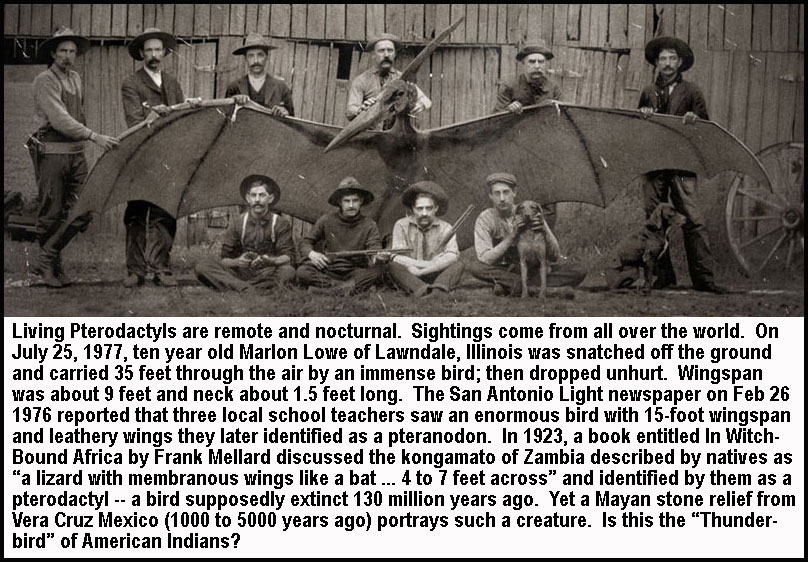

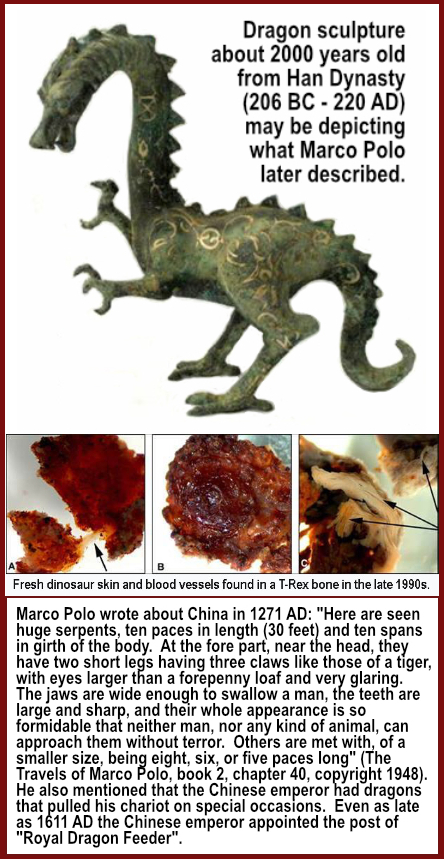
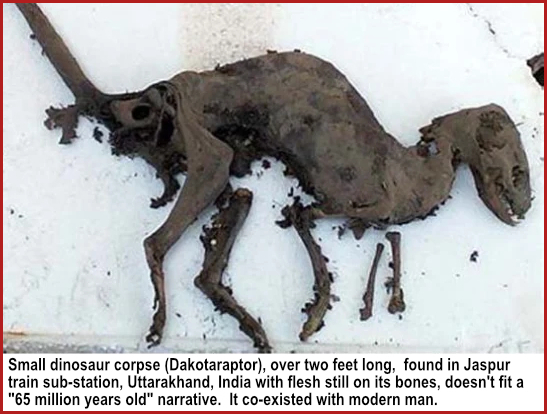
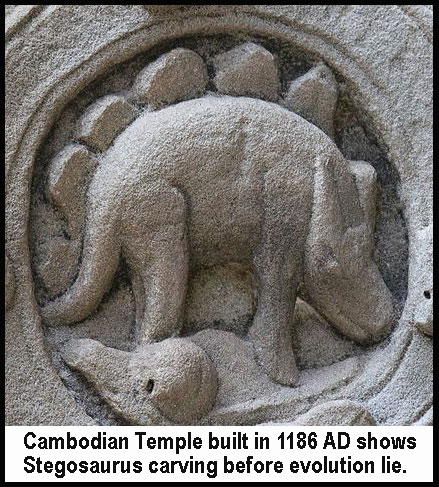
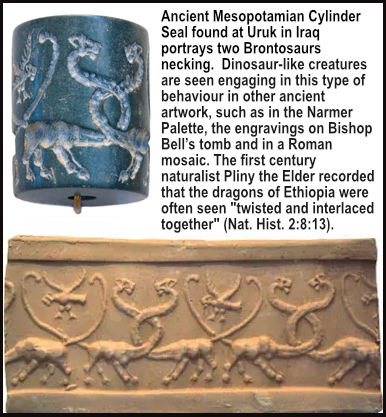
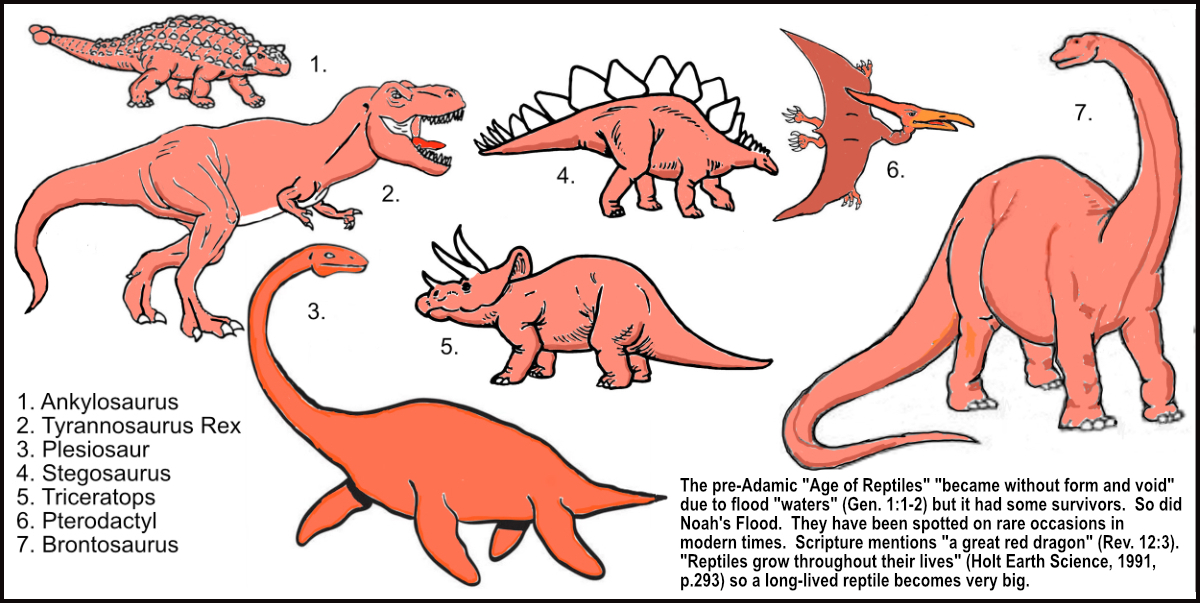 .
.
The Dinosaur World Was Not Extinct 65 Million Years Ago --
Dragons Were Drowned in a Flood Just Before Man Was Created ("Gap Theory") About 6000 Years Ago -- And Some Have Survived
God originally created the earth "to be inhabited" (Isa. 45:18) at an unknown date in the distant past. It was populated by dinosaurs (dragons). A dinosaur world is not "very good" for man (Gen. 1:31). Instead it was created for angels (Job 38:7-8). But "the angels ... kept not their first estate, but left their own habitation" (Jude 6). They rebelled (Isa. 14:12; Ez. 28:12) and "God spared not the angels that sinned" (2 Pet. 2:4). He didn't create the earth "in vain" [tohu] (Isa. 45:18) but it BECAME that way. "The earth BECAME without form [tohu] and void [bohu]" (Gen. 1:2) when the angels rebelled just as Lot's wife "BECAME a pillar of salt" (Gen. 19:26) when she rebelled. Same word used in both places. Scientists believe a meteor collided with earth causing the extinction of the age of dinosaurs. Satan and his angels had sinned (Isa. 14:12; Ez. 28:12; 2 Pet. 2:4; Jude 6). This collision caused a worldwide flood. "And darkness was upon the face of the deep ... waters" (Gen. 1:2) which drowned the dinosaur world (except aquatic varieties, and apparently some land animals and birds). Then God RENEWED "the face of the earth" (Ps. 104:30) and commanded man to "REPLENISH the earth" (Gen. 1:28 -- Strong's # 4390). It had supported life once before. Then 1656 years later, another worldwide flood occurred (Gen. 7:12), initiated by another meteor colliding with earth, and God again instructed man to "REPLENISH the earth" (Gen. 9:1 -- Strong's # 4390). The pre-flood world had been drowned due to wickedness and rebellion. But Noah preserved dinosaur species through the flood.
Many in the scientific community now believe in the reality of ancient, global catastrophes due to a layer of iridium which can be found in widely scattered parts of the earth. "This iridium-rich clay lay right at the boundary between the Cretaceous period, when there were dinosaurs, and the Tertiary, when there were none. Because iridium is rare on earth but common in meteorites ... [three Berkeley scientists] proposed that earth had been hit by an asteroid ten kilometers (six miles) across ... the proposal has since been backed up by abundant and convincing evidence from around the globe. Most scientists now concur that at least one great extraterrestrial object struck the planet around the time the dinosaurs died out." (National Geographic, "The March Toward Extinction," June, 1989 Issue, p. 665). This six-mile wide asteroid hit the earth creating the giant crater we know as the the Gulf of Mexico.
It is significant that the iridium layer is found within a layer of clay. Since clay is typically deposited on sea-bottoms (Collier's Encyclopedia, Vol. 5, Heading entitled "Clay," p. 345), a layer of clay indicates that an ancient worldwide flood occurred as a result of a meteoric collision. Since this iridium layer marks the end of the dinosaur age and many other forms of prehistoric life, it seems evident that meteoric collisions precipitated a series of catastrophic events which led to the earth becoming (in the Bible's words) "tohu - without form and bohu - void." The fact that this layer of destruction is followed by a world of mammals indicates there was a "clean break" in the types of life on earth. The hostile world of dinosaurs was eliminated (with a few exceptions such as plesiosaurs like Lake Okanogan's Ogopogo, Lake Champlain's Champ and Loch Ness monster's Nessie as well as pterodactyls which have been photographed, a stegosaurus carved on Ta Prohm temple wall in Cambodia, ancient art and seal cylinders depicting brontosaurs and Marco Polo's description of Tyrannosaurus Rex dragons in China, etc.), and was followed by a world of mammals which were far more compatible with mankind (Cambrian Explosion). This is consistent with the Bible's account that the prehistoric earth experienced a global catastrophe which was followed by a new creation featuring mammal species.
The National Geographic article also catalogues evidence that more than one mass extinction has occurred in the earth's history. It says: "scientists know that the story of life on earth has been punctuated by mass extinctions...no matter what causes them, mass extinctions do occur. They force a new perspective on the history of life." (National Geographic, "The March Toward Extinction," pp. 666, 673). This scientific view states that one ancient catastrophe: "was abrupt, worldwide, and occurred during the midst of a long warm spell. 'At most we are dealing with 20,000 years -- and maybe just one stormy night,' says Willi Ziegler, director of the Senckenberg Museum in Frankfurt." (Ibid, p. 684) Soft tissue and proteins found in dinosaur bones indicates dinosaurs are recent, not millions of years old (Earth, June 1997 pp.55-57). For thousands of years, the Bible has been telling man that at least two ancient global catastrophes occurred: the Flood of Noah's time, and the destruction of an inhabited earth prior to Adam's creation. Interestingly, in recent years man's ability to analyse objectively the earth's past has finally advanced to the point that it confirms what the Bible has said from the beginning.
"Stone Age Prehistoric Man"?
The word "prehistoric" means no written record exists. How then do we know "prehistoric man" existed at all? There is no history to support it. But men continue to try to prove that cavemen COEXISTED with dinosaurs. But the world of the dinosaurs and the modern world of mammals are NOT INTERMIXED in the fossil record. Realistically, they are not even compatible. Yet historians try to extend the history of mankind. We read about "the first man Adam" (1 Cor. 15:45). There was no "cave man" before him. Manetho summarized the history of Egypt under the rule of 30 dynasties and tried to make them appear consecutive. But the truth is that Egypt was ruled by several kings at the same time (2 Ki. 7:6). The famous "AGES" of man known as Paleolithic (Old Stone), the Mesolithic (Intermediate Stone), the Neolithic (New Stone), the Chalcolithic (Stone and Copper) and the Bronze and Iron -- were CULTURES, not ages. Civilized man did not descend from primitive tribes using stone tools. Instead, it was degraded and degenerate men that descended from civilization -- "driven forth from the midst of men ... to dwell in the clefts of the valleys, in caves of the earth, and in the rocks" (Job 30:1-8). Such cultures of head-hunters and cannibals exist today in places like New Guinea alongside modern civilization. But Adam was created 6000 years ago with a brilliant mind that was "very good" (Gen. 1:31). He was not in any way degenerate or primitive. Did not Zipporah, the wife of Moses (Ex. 4:25), and Joshua (5:3) both avail themselves of stone knives in order to perform the rite of circumcision, long after the stone age is supposed to have passed away? In fact, the very stone knives which were used on the occasion were buried in the tomb of Joshua according to the LXX of Joshua 24:30. Sir Gardiner Wilkinson, in his Manners and Customs of the Ancient Egyptians 3:262, gives an account of flint knives found in their tombs, the use of which was retained for certain religious purposes long after bronze and iron had been familiar to them. Herodotus 2:86 mentions that the Egyptians made an incision in the body of a dead person, when brought to be embalmed, "with an Ethiopic stone."
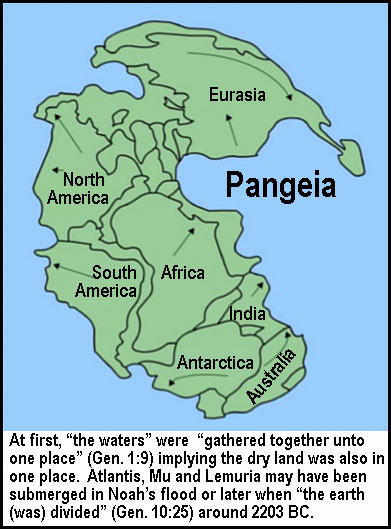
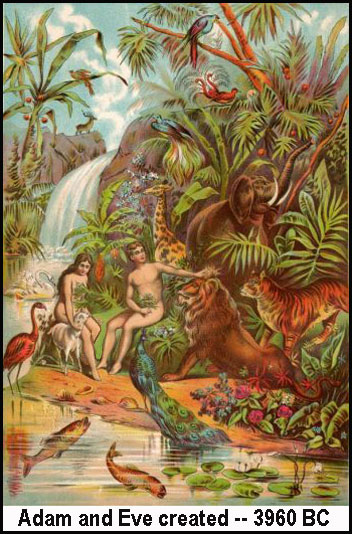
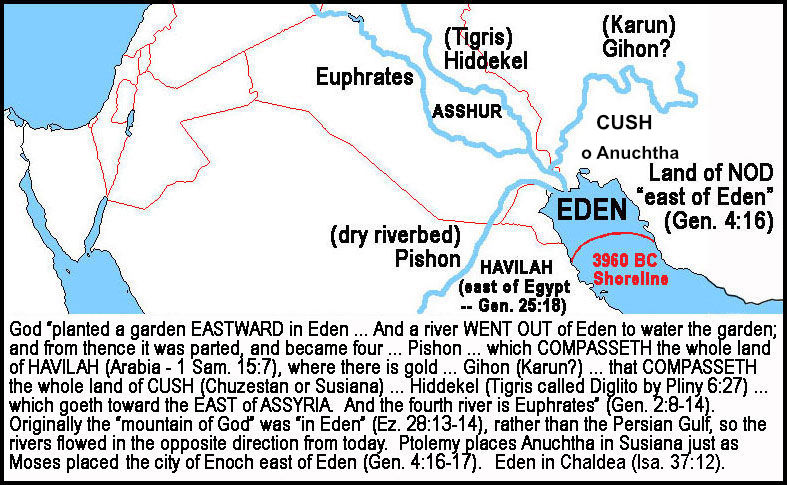
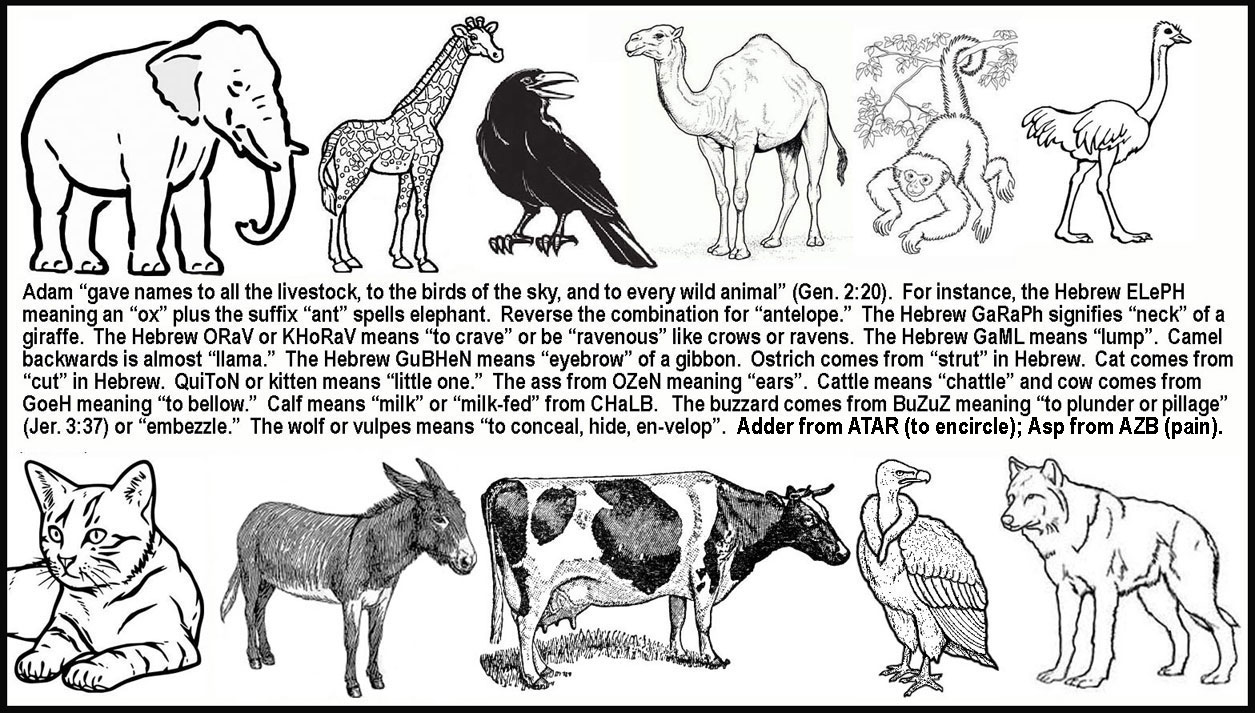
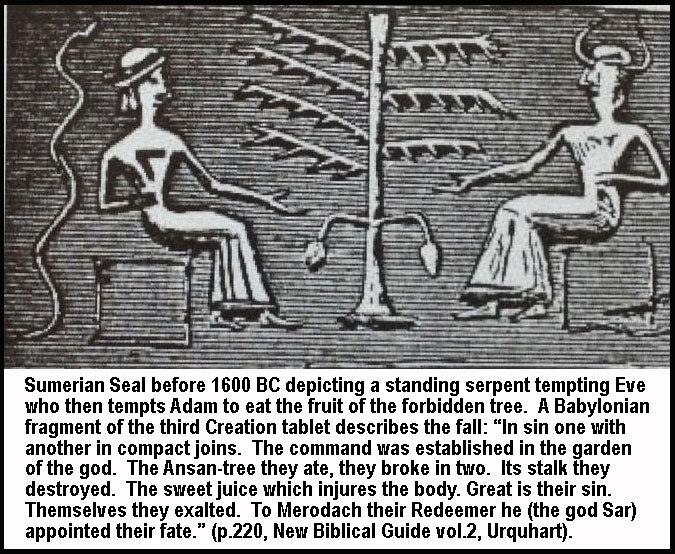
Adam and Eve Were Created in 3960 BC (Cambrian Explosion) -- "He Sendeth Forth His Spirit, and They Are Created, and He Reneweth the Face of the Earth" (Ps. 104:29)
The six days of creation symbolized 6000 years of human history (Ps. 90:4; 2 Pet. 3:8; Rev. 20:1-7; Heb. 4:1-11). "One DAY is ... as a thousand years, and a thousand years as one DAY" (2 Pet. 3:8). "The life of man is but of a DAY." (Max. Tyr. diss. 40). For instance, on the first day the light was divided from darkness just as in the first thousand years there was a clear division between Cain's and Seth's descendants. On the second day waters were divided from waters just as after Noah's Flood and the division at Babel in Peleg's generation people ("waters" --- Rev. 17:15) were divided. On the third day the earth brought forth fruit trees just as Abraham's descendants ("trees of righteousness" -- Isa. 61:3) became a huge nation producing good fruit. On the fourth day the sun and moon gave light upon the earth just as our Lord (the sun of righteousness -- Mal. 4:2) came to earth to bring us light which is reflected by his church (the lunar "lampstand" -- Rev. 2:5). The lamb was killed four days after selecting it (Ex. 12:6). On the fifth day God created birds and fish to "be fruitful and multiply" just as the church multiplied in the fifth millenium. On the sixth day, God made man in his image to subdue his creation. With the advent of the printing press, electricity, the light bulb, plane and automobile, men have conquered the earth. On the seventh day God rested. The seventh day Sabbath pictures the Millenium when peace and righteousness will prevail at the Second Coming. We are fashioned into God's moral image on this day. As Horace said, "Keep Nature's great original in view, And thence the truthful images pursue."
In 3960 BC Adam and Eve were created. Humans from humus. Moslems have a tradition that Adam was as tall as a palm tree (Yahya, Comment in Koran). On top of a mountain in Ceylon is a footprint above two spans long (over 18 inches) named Pico de Adam (Adam's Peak). Savages of Papuan Islands perform the rite of circumcision up to the present day and have a tradition that "The first man, who had previously been a stone, thought one day he would make a woman. He collected the light earth on the surface of the ground in the form of a human body, with head, arms, and legs. He then plucked out one of his left RIBS, and thrust it into the breast of his earth model. Instantly the earth became alive, and up started the woman. He called her Ivi ... which is their word for RIB." (Nineteen Years in Polynesia, by G. Turner, p.323)
Adam named the animals appropriate Hebrew names such as KHoPHeR (digger) for the GOPHER, GaRoN (throat, neck) for the CRANE, EGRET and HERON, and HoRaiSH (plougher) (Micah 3:2) for the HORSE. BaQaR (cattle) (Gen. 26:14) became CARIBOU. TSAKHUN (stink) (Joel 2:20) became SKUNK. QOAPH (ape -- 1 Ki. 10:22) became APE. OTSAR (storehouse -- Pr. 21:20) became OYSTER. AQRaB (scorpion -- 1 Ki. 12:11) became COCKROACH, CRAYFISH, SCARAB, CRAB and SCORPION. QaTSOAR ("to cut down") became CASTOR, the French and Latin name for BEAVER. Adam named the SNaKe from Hebrew NaKHaSH meaning "diviner" or "foreteller" since Eve had been told that her "EYES SHALL BE OPENED and ye shall be as gods, knowing good and evil" (Gen. 3:5). Adam became ashamed of his nakedness. The Lord "OPENED HER EYES, and she (Hagar) saw a well" (Gen. 21:19).
The Iambu tree of Indian mythology grew in the sacred grove, and its fruit feeds the waters of the Iambu river, which confer IMMORTALITY on all who drink them. The same reminiscence shows itself in the grotesque Norse legends of the Yggdrasil, the sacred ash, under one of whose roots is the holy Urdar-fount. "Near the fountain stands a very beauteous dwelling, out of which go three maidens, named Urd, Verdandi, and Skuld. These maidens FIX the LIFETIME of all men, and are called Norns.... the Norns, who dwell by the Urdar-fount, draw every day water from the spring, and with it and the clay that lies around the fount they sprinkle the ash, in order that its branches may not rot and wither away . This water is so holy that everything placed in the spring becomes as white as the film within an egg-shell." The Grecian myth has a garden kept by three sisters, the Hesperides, containing a tree which bore GOLDEN apples. The tree was guarded by a fierce dragon, called Ladon, which never slept. The ancient Aryans of India had their soma, the liquor extracted from the branches of a tree which they named amritam -- "that which renders IMMORTAL." The Persian tradition is equally clear. The Haoma is named in the Mazdean books the TREE OF LIFE. The sacred juice of the Haoma is called in the Yacna "that which BANISHES DEATH.""This sacred tree," says Vigouroux, "is incontestably one of the most exalted emblems of the Babylonian religion. It is always accompanied by personages who attest its high importance. These are sometimes royal figures in adoration, sometimes winged genii (Kirubi), set to guard it. Frequently above the sacred plant hovers the symbolical image of the supreme god, Ilu. Sometimes it is surrounded by the seven stars of the Great Bear, by the sun and by the moon." "The image of the TREE OF LIFE among the Chaldeo-Assyrians was the object of a genuine divine cult; the simulacra (copies) seem to have been arranged after the fashion of the old-fashioned May-poles of Western Europe, and trees laden with all kinds of attributes and ornaments were carried every year at springtime, as symbols of LIFE, to be burned in the court of the temple of Atar'Ate (Atergatis), at Hierapolis, in Syria." (pp. 206-212, New Biblical Guide, vol. 2, Urquhart). The Chinese call the first man's place of residence, Lan Thou ; which in Celtic signifies God's cloister, precinct or fold.
When they sinned, a "lamb" was "slain" (Rev. 13:8) to provide them each with "a robe of righteousness" (Isa. 61:10) to cover their nakedness (sin -- Rev. 3:18). That was the Gospel message at the very beginning. Humans and animals were vegetarian (Gen. 1:29-31; cp. Isa. 11:7 & 65:11). "Spring was forever ... earth, unplowed, brought forth rich grain" (Ovid Metam. 1:108) from pole to pole. Men lived to be nearly 1000 years old (Gen. 5:27) due to a water vapor canopy which protected earth's inhabitants from harmful cosmic rays and ultraviolet radiation, so the aging process was much slower. It will be that way again in the Millenium (Isa. 65:22). The planet Venus is shielded by vapor canopy so dense we can't see the surface of Venus. Saturn's moon, Titan, also has vapor canopies surrounding it. At one hundred years, a man was still a child (Hesiod Works and Days 109). Plants and animals grew larger than they do today (Gen. 6:4). It was also like a giant hyperbaric chamber. According to Time magazine, when analyzed in a vacuum chamber, the oxygen content of encased air bubbles in ancient amber (fossilized tree sap) is 50% higher than the atmosphere is now (Time magazine Nov. 9, 1987, p.82). In a hyperbaric chamber, cuts healed quickly. Furthermore, the sun and moon were in synchronization. Twelve 30-day months coincided with a 360-day year (Augustin de Trin 4:4). No remainder. In short, "it was very good" (Gen. 1:31). There was no rain. Instead, a "mist went up from the ground and watered" the plants (Gen. 2:4-6; Job 38:4,9). Noah is praised for believing a warning about rain -- something "not seen as yet" (Heb. 11:7). Rainbows also were first seen at the time of the Flood (Gen. 9:13-16). But the rest of the people "could not abstain from mutually inflicting violence on eachother, nor would they worship the immortals, nor sacrifice to the blessed ones on their altars. Therefore Zeus (in Latin Jove, which is short for Jehovah) removed them, because they would not give honor to the blessed gods who inhabit Olympus" (Hesiod, Works and Days, v.126-128). Each cherub came to be called a sphinx, the Garden of Eden was renamed the Garden of the Hesperides, and the fruit became golden apples. How long did Adam and Eve live in this Paradise of hedonism (Eden = Greek Hedon = Pleasure, Joy)? Since tradition labels it a "Golden Age", we believe it was longer than a day, or a week, or a year. A more likely guess would be 100 years to qualify as an "Age." Since Cain was born after the expulsion (Gen. 4:1), and murdered Abel as an adult, who was then replaced by Seth who was born when Adam was 130 years old (Gen. 5:3), we believe 100 years is an outer limit for this "Golden Age." If the EARTH DIDN'T ROTATE on its axis at first, then a day would have been a year in length originally. At least during creation week. Hence the day-year symbolism found in the Bible (Num. 14:34; Ez. 4:6). When did the earth start SPINNING? Possibly after the Creation Week or after the Fall of Adam. If the circumference of our Earth globe at the equator is twenty four thousand miles (24,901), the surface of the Earth, to move round its own axis once in twenty four hours, must move at the rate of a thousand miles an hour.
Jasher says Cain brought "the inferior fruit" (1:16). According to Jasher 1:18-19, Abel let his sheep graze on Cain's land because Cain had killed one of Abel's sheep for its meat and wool. Genesis 4:8 says, "Cain (Get) talked with (said unto) Abel (Vanity) his brother" after which there is a blank space left in Hebrew copies, as if something was missing. The Samaritan Pentateuch and Septuagint version supply this, by adding the words "Let us go into the field," but the Jerusalem Targum, and that of Jonathan ben Uzziel, have given us the whole conversation. Cain said, "There is no future judgment, nor judge, nor life after this, nor reward for the just, nor punishment for the wicked: the world was neither created, nor is governed, by the mercy of God; forasmuch as thy oblation was accepted, and mine rejected." Abel responded, "There is a future judgment, and a judge, and a life to come: there is both a reward for the just, and a punishment for the unjust: the world was created, and is governed, by the mercy of God. And because my works are better than thine, therefore was my oblation accepted, and thine rejected." Then Abel was murdered by Cain. "And the Lord said unto Cain, Where is Abel, thy brother? And he said, I know not: am I my brother's keeper?" (Gen. 4:9) But Ovid says, "We are not born for ourselves alone" (Each of us has a responsibility to others) (Metam. 14). "And Cain said to the Lord God, My crime (not my punishment) is too great for me to be forgiven (or to bear)" (Gen. 4:13; Brenton); or "Is my sin too great to be forgiven?". "I wish that any person that finds me may kill me" (4:14) is an alternate translation. When Cain was banished from the presence of the Lord in the land of Nod (from "nad" meaning vagabond or nomad; Chusistan or Susiana), he and his family forgot God and worshipped the sun according to Sanchoniatho (1:2) who says Cain's family, "in seasons of drought stretched out their hands toward the heavens, to the sun, whom they accounted the only Lord of Heaven, calling him 'Baal Shamin' (Master of the Heavens)". (cp. Wisom of Solomon 14:12). Diodorus Siculus says, "Men in earlier times struck with the beauty of the Universe, with the splendor and regularity which everywhere were in evidence, made no doubt that there was some divinity who therein presided, and they adored the sun as expressing the likeness of the Deity."
| Zeno (apud scholiast. Apollon. Argon. 4) and Plutarch (aquane p.955) took the chaos of Hesiod to have been water
(2 Pet. 3:5). Anaxagoras said, "For in the beginning all things were mingled together in confusion: but mind came in, and brought them out of confusion into order." Berossos in the first book of his Babyloniaka says "There was a time in which all was darkness and water". Before the seas, and this terrestrial ball, And heaven's high canopy, that covers all, One was the face of nature - if a face; Rather a rude and indigested mass; A lifeless lump, unfashioned and unframed, Of jarring seeds; and justly Chaos named. No sun was lighted up, the world to view; No moon did yet her blunted horns renew; Nor yet was earth suspended in the sky; Nor poised did on her foundations lie: Nor seas about their shores the arms had thrown; But earth, and air, and water were in one. Thus air was void of light, and earth unstable, And water's dark abyss unnavigable. No certain form on any was impressed; All were confused, and each disturbed the rest. For hot and cold were in one body fixed; And soft with hard, and light with heavy mixed. But God, or Nature, while they thus contend, To these intestine discords put an end:" (Ovid's Metamorphoses 1:7-26; Dryden) "A hundred years beheld the boy Beneath the mother's roof, her infant joy," -- Hesiod Oper. et Dier. 129 "Like gods they lived, with calm, untroubled mind, Free from the toil and anguish of our kind" -- Hesiod's Works & Days (Elton's translation) Diodorus says "that the first men ... being accustomed to go naked" and Plato says "they ... were without garments in the open air" (Politics). Hebrew "Nakee" means "innocent". "The Daeva who told the lie ... brought them fruits of which they ate, and in consequence of this, of the hundred advantages which they enjoyed, but one remained to them." (The Bundehesh) "May you return to the earth and water of which you were made." -- Homer Iliad 7:99 "With ills the land is rife, with ills the sea, Diseases haunt our frail humanity" (Hesiod's Works & Days, 101-102; translated by Elton) In one of India's oldest pagodas, one sculpture of Chrishna is seen trampling on the crushed head of a serpent while another scuplture shows the serpent encircling the deity in its folds, and biting his heel. (crucifixion required nail in heels) "Not out of his head to be his ruler; not out of his feet to be trampled on by him; out of his side to be equal with him; under his arm to be protected; and near his heart to be beloved." -- Matthew Henry The loss of Eden probably occasioned the first cries of Eva, Eva, in the orgies of Bacchus, and of Adon in Egypt and Phenicia. (Macrob. Sat. 1:21) "Adam and Eve" |
In Gothic theology, an infernal serpent gnaws at the root of a tree of wisdom. The god Thor is said "to have bruised the head of a great serpent." The 22 amino acids in our DNA correspond to the 22 letters of the Hebrew alphabet confirming Psalm 33:6 that says "the word of the Lord" made the heavens using "building blocks" known as letters or amino acids: 12 "Simple" letters (Hydrophilic amino acids); 7 "Double" letters (Hydrophobic amino acids); and 3 "Mother" letters (Punctuation Groups). God "made man upright" (Eccl. 7:29). "He who knows himself, will, in the first place perceive that he is possessed of something divine, and will think that the mind within him was dedicated like a sacred image" (Cicero de Leg. 1:22). The "divine counsel formed man after the image of the gods" (Ovid's Meta. 1:83). Yes Prometheus "first formed men out of clay" (Hyg. Fab. 142). But that old time which we the golden call, Was blessed with every useful fruit, and all Those flowery herbs which beautify the ground, By Nature's hand were thickly strewn around. no land was then defiled with human gore, The birds unhurt through airy space might soar; The timorous hare might widely, dauntless, roam, Gambol its fill, make every field its home; No wily fisher snared the finny tribe, Lured from their homes by his deceitful bribe; Fraud and deceit were wholly yet unknown, On every land peace raised her golden throne. -- Ovid's Meta. 50:15 "No walls were yet, nor fence, nor moat, nor mound; Nor drum was heard, nor trumpet's angry sound; Nor swords were forged; but, void of care and crime, The soft creation slept away their time. The flowers, unseen, in fields and meadows reigned; And western winds immortal spring maintained. From veins of valleys milk and nectar broke, And honey sweating through the pores of oak" -- Ovid Metamorphosis 1 (Dryden) "Here beauteous trees forever blooming grew Pomegranates, apples tempting to the view. Sweet figs, and verdant olives, flourished fair, And the branch bent beneath the weighty pear" (garden of Alcinous in Corcyra pictures Eden) "Then came they to the sacred place, where kept The serpent Ladon watch, nor ever slept; In the Atlantean land the garden lies, And there the apples hung, a golden prize; About the tree the wary dragon wound, And the Hesperides were heard around; Till great Alcides, son of Jove and fame, Engaged the serpent, and at length overcame." (Apollonius) The Chinese in Formosa deemed the world at first a chaos, but reduced to order in four years; that is years of days (p.29, Primitive History) (cp. Gen. 1:1-19). The Chinese "garden of Eden" is in the midst of the summits of mountains known as Houanlun, north of the Himalayas. "The fountain of immortality, which waters these gardens, is divided into four streams, the fountains of the supreme Spirit, Tychin" (Smith's Bible Dictionary, art. Eden). The Cosmology of Taautus or Thoth, King of Egypt, began with a "dark" "chaos" and a "watery mixture" of "mud" . The "waters" were "separated" |
Hindoos hold that after the Supreme Power created the universe, he again retired into himself, from a state of energy to one of repose. God rested. (Institute of Menu) "Eon (Eve), the wife of Protogonus, was the first person who gathered fruit from trees" (Sanchoniathon) Persephone was carried off by Pluto (death) for eating a pomegranate (Ovid Meta. 5:535). "Under the apple tree thy mother lost her innocence" (Song 8:5; Douay-Rheims). "God moulded clay in the likeness of a modest maid ... and a deceitful nature ... And he called this woman Pandora ... a plague to men" (Hesiod, Works & Days, 54) Orpheus instructed his followers that "woman was the origin of all evil." "The name Pandora to the maid was given; For all the gods conferred a gifted grace To crown this mischief of the mortal race. The woman's hands an ample casket bear, She lifts the lid, she scatters ills in air; Hope sole remained within, nor took her flight, Beneath the casket's verge concealed from sight." With ills the land is rife, with ills the sea, Diseases haunt our frail humanity; Now swift the days of manhood pass away, And misery's pressure makes the temples gray." (Hesiod Works & Days, 59-100) That Hope is Christ. Hesiod and other Poets, as Pausanias relates, asserted that Pandora was the first woman. The Garden of the Hesperides (Heb. "hets peri" = a tree of fruit) contained a tree with golden apples. The "Apple of Discord" led to the Trojan War. (Apollodorus E 3:2; Hyginus Astronomica 2:3; Colluthus, Rape of Hellen, 59ff) Guarding the entrance to Elysium is Cerberus (Cherubim) the dog. Another cherubic creature was the fire-breathing Chimera. And the griffin & sphinx. There was also a fountain of ambrosia or immortality in the midst of the garden of the Hesperides, answering to the Tree of Life (Eurip. Hippol. v. 750). Also a serpent named Ladon (El-Eden) defeated by the son of Jove (Apoll. Rhod. apud. Nat. Com. 7:7). In fact oracles of Greece (Dodona = Eden; Delphi) originated from Adam obeying a snake speaking through a woman (Python means "deceive") Just as God "made coats of skins and clothed them" (Gen.3:21), so also Virgil mentions the rite of "clothing in the skins of the sacrifices" (Aeneid 8:282) as having been long practised among the priests of Hercules. Both the Lupercalia & Bacchanalia followers did the same in their rites. Where is the "garden of Eden" located in India? "In the center of Iambu dwipa, the middle of the seven continents of the Puranas, is the golden mountain Meru ... On the summit is the vast city of Brahma ... encircled by the Ganges ... (which) is divided into four streams ... In this abode of Divinity is the Nandana, the grove of Indra, there too, is the Iambu tree, from whose fruit are fed the waters of the Iambu river, which give life and immortality to all who drink thereof."(Smith's Bible Dictionary, art. Eden). In the Hindoo system there is a being composed of a man and an eagle, which is placed in a pass leading to their high garden, called Garuda, to prevent the approach of serpents. "Blest is the man who pays the gods above The constant tribute of respect and love." -- Homer (Iliad) |
The denunciation of God against Adam that "In the SWEAT of thy face shalt thou eat bread" (Gen. 3:19) and "Thorns also and thistles shall it bring forth" implies that "the fruits of the earth sprung up SPONTANEOUSLY and abundantly" (Hesiod's Works & Days 109) up until that time. But "The food of man in deep concealment lies, The angry gods have veiled it from our eyes; Else had one day supplied sufficient cheer, And, though inactive, fed thee through the year" (Hesiod's Works & Days)". Hence we're a hardy toiling race, and bring; Abundant proofs from what dire source we spring." (Ovid 7:14) The curse may have consisted of an ice ring around the globe. The presence of a dark icy "swaddling band" (Job 38:9) encircling earth in pre-flood times may have resulted in lack of rain (Gen. 2:5). Noah's flood would have removed this curse (Gen. 5:29; 8:21-22). The very name "Noah" means "Comfort," because the ice ring condensed out of the sky as rain. Rainbows became visible for the first time after the flood was over. If "seven times" punishment were inflicted on Adam's family due to his sin, then 3960 BC - 2520 years = 1440 BC. But Israel actually entered the Promised Land in 1406 BC, ending the punishment, indicating Adam and Even were in Eden for 34 years before sinning.
Tubalcain (Chrysor or Vulcan) was "an instructor of every artificer in BRASS and IRON" (Gen. 4:22). This implies that IRON was smelted in furnaces where bellows were used to force air through a pile of IRON ore (reddish rock -- hematite -- Fe2O3 or magnetite -- Fe3O4) and burning charcoal (partially burned wood) (layered alternately with iron ore). The carbon monoxide (CO) produced by the charcoal chemically reduced the IRON oxide from the ore to metallic IRON by taking the oxygen and forming CO2. Tubalcain derived the BRASS from three parts crushed Malachite (copper carbonate -- green rock) (CuCO3) heated with one part charcoal which yielded carbon monoxide (CO) that captured the oxygen from malachite making carbon dioxide (CO2) and giving pure copper nuggets using bellows or blowpipes. Then he took zinc silicate (Zn2SiO4) or zinc carbonate (ZnCO3) and heated it with charcoal to obtain pure zinc by capturing the oxygen turning CO into CO2. Then he combined two parts copper and one part zinc in a furnace to obtain BRASS (an alloy not a chemical bond). This all implies that Tubalcain had a knowledge of metallurgy and chemistry.
| "The golden age was first, when man, yet new, no rule but uncorrupted reason knew; And, with a native bent, did good pursue. Unforced by punishment, unawed by fear, His words were simple, and his soul sincere: Needless was written law, where none oppressed, The law of man was written in his breast. "The teeming earth, yet guiltless of the plough, And unprovoked did fruitful stores allow: Content with food, which nature freely bred, On wildings and on strawberries they fed; Cornels and bramble-berries gave the rest, And falling acorns furnished out a feast. The flowers unsown in fields and meadows reigned; And western winds immortal spring maintained. In following years the bearded corn ensued From earth unasked, nor was that earth renewed; From veins of vallies milk and nectar broke, And honey sweating through the pores of oak." -- Ovid Meta. 1:89 "A creature of a more exalted kind was wanting till man was designed ... From such rude principles our form began And earth was metamorphosed into man" -- Ovid Meta book 1 (Dryden et al) "In strength and beauty rose his gradual frame; Perfect from his Creator's hand he came; And, as in form excelling, so in mind The sire of men transcended all mankind." (Montgomery et al) Ptolemy places an "Addan" (Eden) near the confluence of the Tigris and Euphrates. |
|
"Formerly corn of all sorts abounded as plentifully as dust does at present; and the fountains poured forth streams, some of water, some of milk, some of honey, some of wine, and some of oil. Owing to this luxurious abundance, man became corrupt, and fell into all kinds of wickedness; insomuch that Jupiter, disgusted with such a scene, abolished the ancient order of things, and permitted the necessaries of life to be obtained only through the medium of labour" (Strabo book 15:1:64). "God is never in any respect unjust, but as just as possible; and there is nothing that resembles Him more than the man amongst us who has likewise become as just as possible." (Plato Theatet. 85) "In the Krita (golden) age, justice and truth are complete; nor do unrighteous men profit. In the other three ages, justice is successively deprived by one fourth.... In the Krita age, the chief virtue is austerities, in the Treta (silver) divine knowledge, in the Dvapara (brazen) sacrificing, in the Kali (iron) liberality alone." (Laws of Manu, 1:81-86) "The king is identified with the ages of the world. Sleeping he represents the Kali (or iron age), walking the Dvapara (or brazen) age, ready to act the Treta (silver age), but moving actively the Krita (golden) age." (Laws of Manu 9:301-302). Hindu ages of the world are similar to the Greek golden, silver, brass and iron ages "according to the (declining) ... proportions of virtue on earth" in the language of Surya Sidhanta, their oldest astronomical treatise. Joint testimonies of sacred & profane writers agree that before the flood they lived nearly 1000 years: Josephus mentions Manetho, Berosus, Mochus, Hestiaeus, Jerom the Egyptian and the writers of the Phoenician antiquities. He says also that Hesiod (In Works & Days 130), Hecataeus, Acusilaus, Ephorus, and Nicolaus wrote that the ancients lived a thousand years (Ant. 1:4). We only have the records of Hesiod & Josephus at present. Eusebius (Prep. Evang. 9:13, p.415) and Syncellus (Chronog. p.43) refer to them also. Pliny (Nat. Hist. l.c.) and Valerius Maximus (8:13, ext.) have collected a certain number of examples. Dathon, ancestor of the Illyrians lived 500 years. The Thynians, according to the Periplus of Xenophon, headed their royal lists with a prince who lived 600 years and his son lived 800 years. |

The Pagan Gods Were Merely Deified Mortal Men -- Ancestor Worship -- As "Men Began to Profane God's Name" (Gen. 4:26) (c. 3725 BC)
Genesis 4:26 is mistranslated in the KJV. It says "then began men to call upon the name of the Lord." Yet we know Seth "was a virtuous man" (Jos. Ant. 1:71) and Abel was murdered for his righteous piety (Gen. 4:4) before this time. The verse should read, "then men began to profane God's name" or "to call themselves by the name of the Lord." The word halal denotes also to profane as in Leviticus 19:12. How? Perhaps sun worship or ancestor worship. Sanchoniatho describes the deification of dead men because of their useful inventions using wooden images and pillars "and held anniversary feasts in honour of them" (1:5). "Grecians ... Phoenicians and ... Egyptians ... reckoned those the greatest gods who found out matters of public utility, or in any respect served the world ... they worshipped them as gods; and they built temples to their use, and consecrated pillars and stocks in their names" and "held the greatest feasts for them" (Cyril 6, p.205).
Hesiod says that "the gods were the souls of MEN who were afterwards worshipped by their posterity, on account of their extraordinary virtues" (Hesiod, Opera et Dies 1:120-125). Hermes Trismegistus asserts that "Aesculapius, Osiris and Thoth were all holy MEN, whose souls were worshipped after their death by the Egyptians" (Herm. Apud. Mede's Apost. of Later Times 1:4). The Egyptian priests expressly taught "that Cronus, Osiris, Horus, and all their other principal deities were once mere MEN, but that after they died their souls migrated into some one or other of the heavenly bodies, and became the animating spirits of their new celestial mansions" (Plutarch De Iside, p.354). Diodorus Siculus says that "Osiris, Vulcan, and other cognate deities were all originally SOVEREIGNS of the people by whom they were venerated" (Diodorus, Bibl., book 1, pp.13-15). Herodotus also relates that the Egyptian priests admitted that their gods had once been KINGS of Egypt and that the last God king was Horus, the son of Osiris, who had deposed Typhon (Herod. 2:144). Alexander wrote his mother, that even the gods of the higher rank, Jupiter, Juno, Saturn, etc., were MEN; and that this secret was laid open to him by Leo the great priest of Egyptian sacred things; requiring the letter to be burnt, after it revealed this to her (Augustine de Civitate Dei, book 8, c.5).
Seth became THOTH, born of the forehead of SET, whom all tradition (Jewish, Egyptian, Persian, etc.) says invented astronomy and discovered the Sothaic astronomical period of "600 years" for the return of the celestial orbs to their same places (Josephus 1:2-3). In the "Book of the Dead" it is said, "Tet which is Set" confirming the identity of Seth with Thoth. Noah (Janus, Manu, Xisuthrus, Agrotes or Agrouerus) became URANUS (Ouranos) and his wife GE whose sons were Cronus (Ham), Japetus (Japheth) and Typhon (Shem) according to Greek mythology. Or Brahma (Pra Japeti or Japheth) as Creator, Vishnu (Sama or Shem) as Preserver, and Siva (Chama or Ham) the Destroyer according to Hindu tradition. Tubal-Cain (Chrysor), the metal-smith, became VULCAN, the god of the forge (Gen. 4:22; Dio. Sic. 5:74). Naamah, his sister, became MINERVA; or NEMESIS (Gen. 4:22) the goddess of retribution and revenge who married Ham and corrupted his family with her pre-flood witchcraft. Jubal, "the father of all such as handle the harp and organ" (Gen. 4:21) became APOLLO, the god of music. Enoch became ATLAS who invented astrology (p.375, Eusebius Prep. For Gospel). Japheth, son of Noah (Gen. 6:10) became JAPETUS, one of the Titans. Greek mythology made him the husband of Asia. He was also called JUPITER, father and king of the gods (Jah-Pater). Shem, son of Noah (Gen. 6:10), is TITAN (Cory, p.52) or TYPHON or the god SUMU or SAMU ("the Name"), from whom the Khammu-rabi dynasty traced its descent, its first king being Samu-abi, "Shem my father" of the First dynasty of Babylon, the god from whom the Arameans and south-eastern Arabs traced their descent. Ham, the son of Noah (Gen. 6:10) became CRONUS (Cory's Fragments, p.52); or KHEM; or AMUN, the god of Ethiopia, Egypt and Libya. Cush was called BEL, THOTH, JANUS, DAGON (OANNES), HERMES, MERCURY, BUDDHA, WODAN, ODIN, PAN, SATYR, SATURN and CRONUS. The fourth son of Cush was RAMA, worshipped to this day by Hindus. In Egyptian mythology, Ham's son Phut (Gen. 10:6) became PTAH or PHTHA, god of craftsmen and architects (called PYTHIAS in Greek). Misor (Mizraim) is Sanchoniatho's ISIRIS (OSIRIS) since brother of Chna, the first Phoenician and son of Ham (Ancient Fragments, p.9 by Cory) who was known also as ZEUS (p.109, Eusebius, Prep. For Gospel). Mizraim's son called Naphtuhim (Gen. 10:13) became NEPTUNE, god of the sea. Nimrod became NINUS (Apollod. 68), HERCULES, CUPID, DUMUZI or TAMMUZ, SESOSTRIS (Wilkinson Egyptians 1:69), NEBROD, MARS, DIONYSIUS, BACCHUS, MARDUK, or NIMURDA, the god of Babylon (Herod. 2:42,144). Semiramis, his mother and wife, was called RHEA, CYBELE, DIANA, ARTEMIS, BELTIS, ISHTAR, MYLITTA, VENUS, ISIS, CERES, ASTARTE, MINERVA, NEITH, ATHENA, JUNO etcetera "whom all the world worships" (Acts 19:27) because she is Dea Myrionymus -- "the goddess with 10,000 names." Asshur became THOR, the hammer-wielding god associated with thunder storms. Javan is JANUS the ancestor
of the Greeks. Raamah, son of Cush (Gen. 10:7) became the Hindu god RAMA. Etcetera. "The reputation of a man is like his shadow; it sometimes follows and sometimes precedes him; it is sometimes longer and sometimes shorter, than his actual size." -- French proverb
. The "men of renown" (Gen. 6:4) were to some extent what we call today the Greek & Roman gods of "mythology" as well as the gods of Egypt and Babylon, etc.
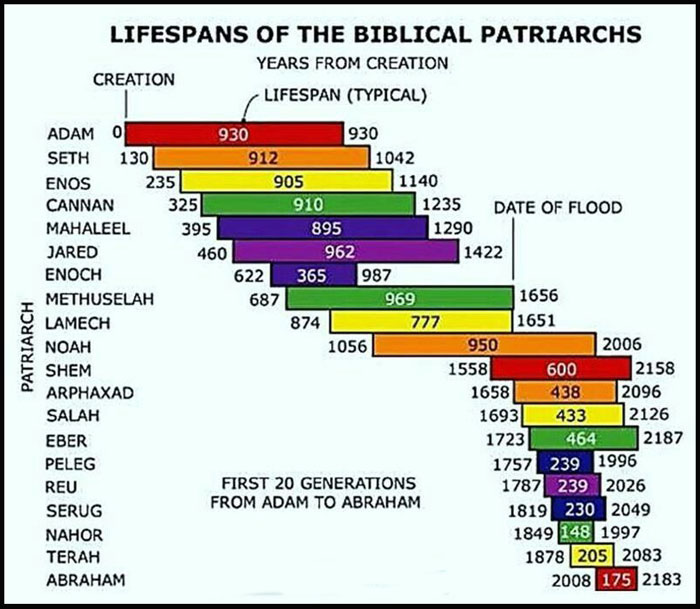
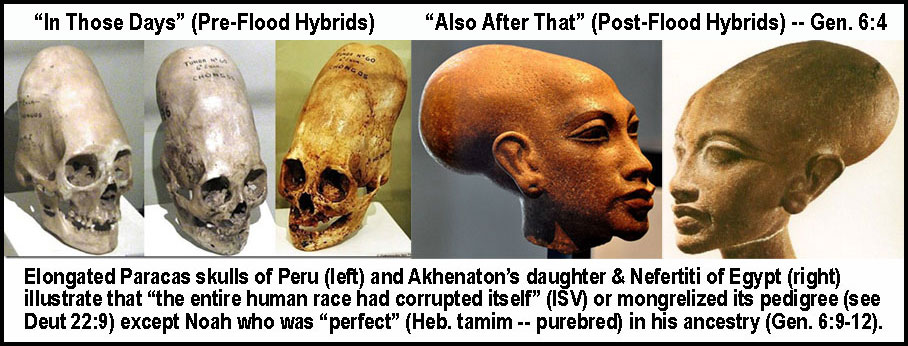
.jpg)
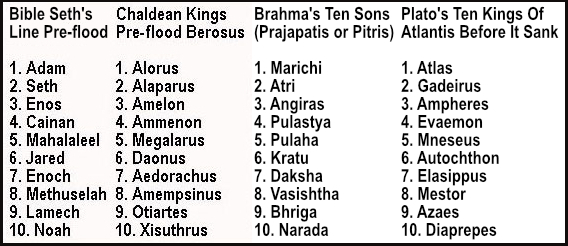
...........jpg)
Ten Antediluvian "Kings" Were Corrupted By Fallen Angels and Cannibalistic Giants Starting in 3500 BC
There were TEN generations from Adam to Noah thru Seth's line (Gen. 5:1-32). The Sybelline books speak of TEN ages which elapsed between the Creation and the Deluge. Sanchoniathon, though he makes no mention of the Flood, enumerates TEN generations (p.41, Cumberland). "In Chaldea Berosus (also Polyhistor and Abydenus) enumerates TEN antediluvian kings (from Alorus [Adam] to Xisusthrus [Noah]). The legends of the Iranian race commence with the reign of 'TEN Peischaddin kings, men of ancient law, who lived on pure homa (water of life), who preserved their sanctity.' In India we meet with the nine Brahmidikas or Brahmarshis who, with Brahma, their founder, make TEN, and who are called the TEN Pitris or Fathers. The Germans and Scandinavians believed in the TEN ancestors of Odin or Wodan. The Arabs in the TEN mythical kings of the Adites, the primordial people of their peninsula." (Lenormant, Ancient History of the East, vol. 1 pp.12-13; New Biblical Guide vol.2, pp. 251-252, Urquhart) To this we might add the Turin Papyrus, in its list of Egyptian dynasties, refers to TEN kings who governed men at the beginning of things. Also an Armenian tradition handed down by Abydenus tells of TEN ancestral heroes. And the TEN kings of the antediluvian Atlantis, which sank into the sea due to immorality, the story of which was related to Solon by the Egyptian priests (recorded by Plato The Critias 114b). It is remarkable that the Hebrew meanings of these ten Sethite antediluvians form a prophetic sentence: "Man (Adam) Appointed (Seth) Mortal (Enosh) Sorrow (Kenan). The Blessed God (Mahlalel) Shall Come Down (Jared) Teaching (Enoch). His Death Shall Bring (Methuselah) the Despairing (Lamech) Rest or Comfort (Noah)." But the names of Cain's descendants form a sentence also: Adam (man) Cain (acquired) Enoch (teaching) Irad (from a dragon) Mehujael (and will be destroyed by God). Methuselah (God shall kill) Lamech (the despairing) Tubal-Cain (offspring of Cain) Jabal (through flowing water) Jobel (at the ram's horn). Even when the names have the same meaning in both lines, Cain's Enoch "taught" material and secular pursuits (4:17) while Seth's Enoch "taught" religious truth (5:22).
According to the Sumerian King List (Weld-Blundell Prism), lines 1-39 deal with the time BEFORE THE FLOOD. This section, which is not present in every clay copy of the text, opens with the line "After the kingship descended from heaven, the kingship was in Eridu." Two kings of Eridu are mentioned, before the city "fell" and the "kingship was taken to Bad-tibira". This pattern of cities receiving kingship and then falling or being defeated, only to be succeeded by the next, is present throughout the entire text, often in the exact same words. This first section lists EIGHT KINGS (Adam and Noah not included) who ruled over five cities (apart from Eridu and Bad-tibiru, these also included Larak, Sippar, and Shuruppak). The duration of each reign is also given. In this first section, the reigns consist of 28,800, 36,000, 43,200, 28,800, 36,000, 28,800, 21,000, and 18,600 years for a total of 241,200 years. The section ends with the line "Then the FLOOD swept over" (the earth). Among the kings mentioned in this section is the ancient Mesopotamian god Dumuzid (the later Tammuz). "AFTER THE FLOOD had swept over, and the kingship descended from heaven, the kingship was in Kish." Early Sumerians used base 60 for their numbering system. Egyptians, Greeks, Romans and Hebrews used decimal. Perhaps a Sumerian scribe found a record written in the decimal system and interpreted it as being written in the sexagesimal system. The different powers of 60 depended on the position of the symbol in the number string. The individual signs representing a number had to be added together to obtain the value. The total duration of the kingdoms in the Sumerian King List and the total ages of the EIGHT patriarchs are equivalent if the number base of the Sumerian King List is changed from sexagesimal to decimal. The total (241,200) needs SIX 10x60 squared signs (6 X 36,000), SIX 60 squared signs (6 X 3600) and SIX 10x60 signs (6 X 600) and is transformed into 6660. If Adam and Noah are not included, the EIGHT remaining patriarchs would total 6695 (912 + 905 + 910 + 895 + 962 + 365 + 969 + 777 = 6695) which is almost identical to 6660. (99.48% accurate) The probability of this happening by chance is very small.
Rebellious angels ("sons of God" -- Job 1:6; 38:7; Ps. 82:6; possibly also Seth's descendants [Deut. 14:1; Jer. 3:19] who were magistrates [elohim -- Ex. 22:9; 1 Sam. 2:25]) DISROBED (oiketerion) from their heavenly bodies (cp. Matt. 22:30). This term is used only twice in the Bible (2 Cor. 5:2 & Jude 1:6). "And the angels who kept not their first estate, but left their own habitation, he hath reserved in everlasting chains under darkness unto the judgment of the great day" (Jude 1:6). "These angels then assumed human form (Gen. 19, Mark 16:5, etc.) and appeared as males when they DESCENDED (Heb. "Jared" means "descend") from Mount Hermon in 3500 BC (Elmacin. p.9; Euthych. p.27) or in the fortieth year of Jared (Abulfarag p.8; Epiphan. Heres. 1). Then they had sexual relations with human women in Genesis 6:1-4. (Hebrew verb "to take" means to forcefully ravish; "They took them by force" -- Alexandrian LXX). God charged his angels "with folly" (Job 4:18). The children from these unions were giants.
Jude 14-15 quotes 1 Enoch 1:9 which says, "Behold, he comes with ten thousand saints". But more than that, Jude 6-7 and 2 Peter 2:4 allude to the SEXUAL LUST of fallen angels for human women paralleling Enoch who says: "And when the angels, the sons of heaven, beheld them, they became enamored of them, saying to each other, Come, let us select for ourselves wives from the progeny of men, and let us beget children” (1 Enoch 7:2). The resulting children are called nephilim in Hebrew (from Heb. naphal -- to fall) or gigantes (giants -- Num. 13:33) in Latin and Greek. (English translators have rendered seven Hebrew words by the one term "GIANTS", viz. nephilim, gibborim, enachim, rephaim, emim, zuzim and zamzummim. But "APOSTATES" might be a correct translation of nephalim also, which has no reference to bodily stature -- 2 Ki. 25:11; Jer. 37:13; 38:19.) Notice the parallel: "Even as Sodom and Gomorrah ... GOING AFTER STRANGE FLESH" (Jude 7) -- humans lusting after angels (Gen. 19:1-8). Evil angels before the Flood lusted after human women and left their proper abode (i.e. heaven -- Matt. 22:30) and came to Earth and had children by human women. For this reason, these particular angels have now been bound in Hell ("Tartarus" -- used by Enoch and 2 Peter 2:4). The resulting children became the Nephilim – a cross between angels and the human species. They were the mighty TYRANTS of "the world that then was." The mixing between fallen angels and women was so extensive that by the time of the Flood only Noah (Gen. 6:9) was found to be "perfect in his generations" (i.e. PUREBRED IN HIS ANCESTRY). "All flesh" had "corrupted" its physical genetics (Gen. 6:12). Plato says the heroes (from eros -- sexual love) are demigods, for they are all born of the love of a god for mortal woman, or of a goddess for a mortal man (Cratylus 399). Herodotus remarks that the Egyptians were the only people among whom this belief did not exist (2:50). These angels taught humans "potions and spells" (SORCERY), "to make swords and armour" (WAR), (Diodorus says that "Hercules and other warriors fought with clubs in the Titanian war." that was in the fourth century before the Trojan War. Our gothic word battle is derived from that weapon, called in Irish Bat. The Sibyl counted the Titanian war during the tenth generation after the Flood, when Abraham lived.) "COSMETICS" and GOLD & SILVER jewelry (LUST), "ASTROLOGY", "DIVINATION" and "LEWDNESS" and after this, "the giants began to devour the flesh of men" (CANNIBALISM) (Synkellos Chronography 1:12-13, 25). The birth of the giants, according to 1 Enoch, is the reason for Noah's Flood -- to destroy the angel-human HYBRIDS. Greek "mythology" records that the Titans were a threat to the rule of Zeus and so Kronos and many Titans were banished to Tartarus. The Titans were the antediluvian Nephilim. "There were till then left the race of giants, who had bodies so large, and countenances so entirely DIFFERENT from other men, that they were SURPRISING to the SIGHT, and terrible to the hearing. The bones of these men are still shown to this very day, unlike to any credible relations to other men." (Antiquities 5:2:3). Was Josephus describing ELONGATED HEADS with RECEDING FOREHEADS? "It has been shown that this peculiar form of head was present even in the foetus of the Peruvian mummies" (p.272, Atlantis, the Antediluvian World). The Mangbetu people are from Central Africa -- Congo. They believe that an elongated skull with a flattened forehead pleases the gods. The ancient custom of head-flattening (in Peru, Mexico, Turkey France, Huns, Scythians and Chinook Indians) was an attempt to imitate an ancient aristocracy (nephilim?) (p.272, Atlantis, the Antediluvian World by Donnelly).
Sanchoniathon mentions that from Genos (Cain) were descended "sons of vast bulk and height, whose names were given to the mountains on which they first seized" This was an era of SHAMELESS DEPRAVITY since "the women of those times ... WITHOUT SHAME lay with any man they could light upon" (p.24, Cumberland's Sanchoniathon). Ovid mentions the giants trying to invade heaven (Metamorphosis 1:151). Apollodorus mentions those many-handed giants, Briareus, Gyas, and Ceus; who waged war with heaven, and who, for their crime, were thrust down into Tartarus (Appol. de Dis. 1:3). Then immense giants Otus and Ephialtes made war against heaven, and attempted to scale it by piling mountain upon mountain. At length, through a strategem of Diana, they fell by eachother's hands, and their design was aborted (Appol. de Dis. 1:25-29). "A tribe of the Ethiopians who are known as the Syrbotae exceed eight cubits in height." (Pliny Nat. Hist. 7:2) Homer speaks of the Laestrygonians as "Not like men, but like giants." (Odyss. 10:120) "The Africans tell us the body of Antaeus lies there, and Sertorius, not giving credit to what the barbarians reported of his gigantic size, opened his tomb for satisfaction. But how great was his surprise when ... he beheld a body sixty cubits long." (Plut. Sert. 9) Sanchoniatho dedicated his work to Abibalus king of Berytus in Phoenicia (a most ancient city between Byblos and Sidon) and flourished about 1200 BC because Porphyry says he conversed with Jerombaal (Gideon was called Jerubbaal -- Judges 6:32 -- by changing the first b into the kindred consonant m, as in Ambubaia, Sambuca, etc.), a priest of the god Jevo (Jehovah) in or near Phoenicia (Israel).

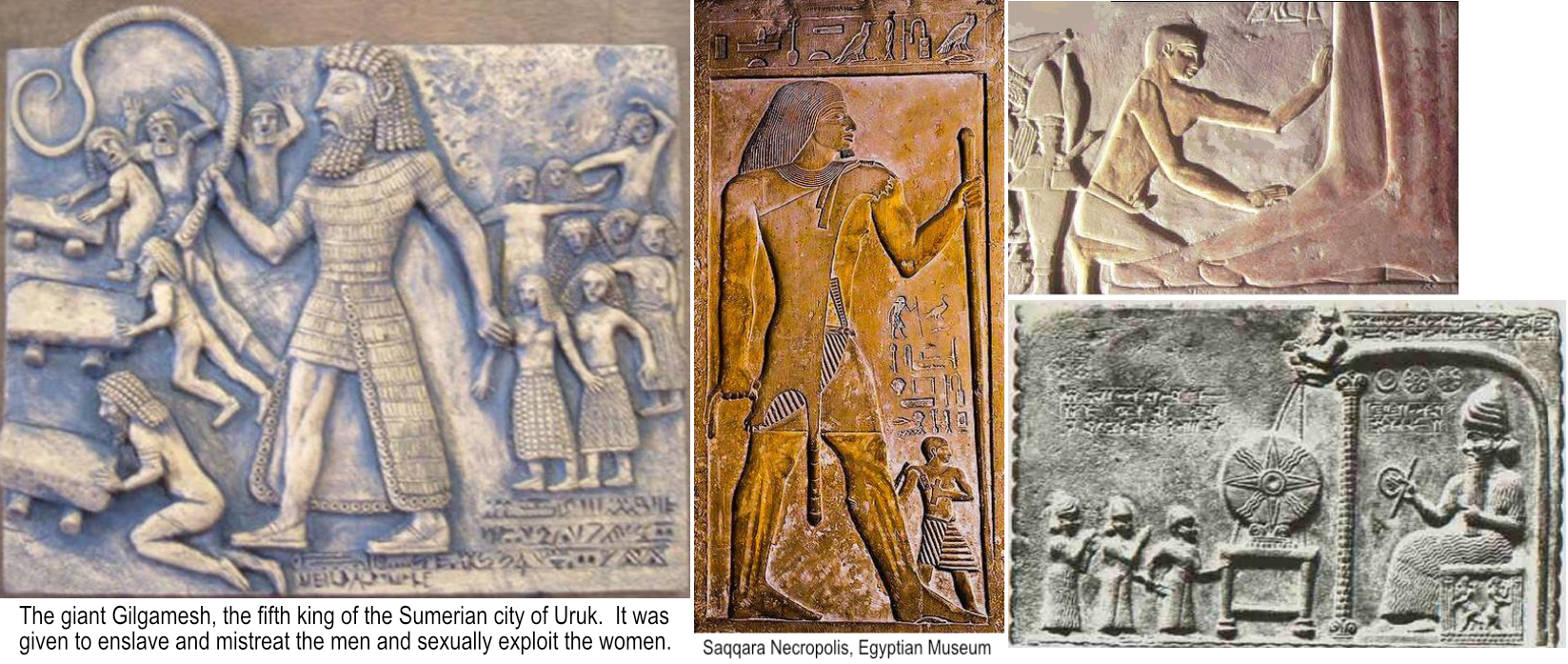
Credible instances of giants, though rare, are recorded by historians, sacred and profane, ancient and modern (Pliny Nat. Hist. 7:16; Aul. Gell., Noct. Attic., iii., x, 10-11). Traditions concerning a population of giants are found in the southern part of the island of Rhodes (Diod. Sic. v. 55) and at Cos (Hippocrat.,Epist., p.1292). Cyzicus displayed a causeway within her territory supposed to have been the work of these same giants (Schol. ad Apollon. Rhod., Argonaut., i., v. 0987). In the Odyssey there is reference to Eurymedon, king of the people of the giants, whose daughter, by the operation of the god Poseidon, became mother of Nausithoos, first king of of the Phaeacians (Odyssey, H. v.56-60) who said they were related to the Cyclops and Giants (Odyssey, H, v. 206). A gigantic stature is also ascribed to the Lestrygons (Odyssey, K. v. 120) in the same poem. This idea that the heroes of the earliest times were genuine giants has become commonplace in classic poetry (Homer, Iliad, E, v.302 et seq.; Lucret., ii., v.1151; Virgil, Aeneid, Xii., v.900; Juven., Sat., xv., v.69) and seems to be corroborated by the discoveries of remains of great fossil mammals, which have been taken for the bones of heroes seven (Herod. 1:68; Solin. 1:84), ten, eleven cubits high, or even taller (Pausan 1:35, 5; 8:29,3, and 32,4; Josephus (Antiq. Jud., v. 2,3) and even St. Augustine (De civit. Dei., 15., 9). Berosus, following Chaldeo-Babylonian tradition, said that the first men were of a prodigious stature and strength, and he represented them as retaining these characteristics during the first generations after the Flood (Fragment 17 of Lenormant's edition). Mar Abas founded his story of ancient violent giants of Mesopotamia and Armenia (the war between Bel the Babylonian & Haigh the Armenian) on Berosus and the national traditions of Armenia rather than Genesis 6. All Arab legends regarding the primitive inhabitants of Arabia, the sons of "Ad and of Amliq" (Num. 24:20), represent them as giants. They were wicked and violent (Knobel, Die Volkertafel der Genesis, pp.179, 204 et seq., 234 et seq.). According to the fourth book of Ezra (Apocrypha), the stature of men has been growing smaller ever since the Flood. According to the Talmud, Adam was endowed with prodigious size and strength (Talm. Bab. Baba Bathra fol. 58), beyond that of all the giants who lived after him. St. Augustine agrees as to the colossal stature of the first men (De civ. Dei, 15., 9).
In sacred history, we read about Og, king of Bashan (whose bed was nine cubits long -- Deut. 3:11), and Goliath of Gath and his brethren (six cubits and a span in stature -- 1 Sam. 17:4-7; 1 Chr. 20:4-8), as well as the Anakim (Num. 13:33) and Emim (Deut. 2:10-11). Six digits per hand and six toes per foot are a common trait of giants (2 Sam. 21:20; 1 Chr. 20:6-8). Double rows of teeth are also common in giants. Even elongated heads. In profane history, a memoir of M. Le Cat, read before the Academy of Sciences at Rouen, presents the most correct and authentic account of giants that has yet appeared. "Profane historians have given SEVEN feet of height to Hercules, their first hero; but in our days we have seen men EIGHT feet high. The giant who was exhibited at Rouen in 1735, measured EIGHT feet some inches. The Emperor Maximin was of that height. Shenkius and Platerus, physicians of the last century, saw several of that stature; and Goropius saw a girl who was TEN feet high. The body of Orestes, according to the Greeks, was ELEVEN AND A HALF feet; (Pliny 7:16) the giant Galbara, brought from Arabia to Rome, under Claudius Caesar, was nearly TEN feet; and the bones of Secondilla and Pusio, keepers of the gardens of Sallust, were but six inches shorter. Funnam, a Scot, who lived in the time of Eugenius II, measured ELEVEN AND A HALF feet; and Jacob Le Maire, in his Voyage to the Straits of Magellan, reports that they found at Port Desire, several graves covered with stones under which they discovered skeletons of TEN and ELEVEN feet long. The Chevalier Scory, in his Voyage to the Peak of Teneriffe, says they found in one of the sepulchral caverns of that mountain, the head of a Guanche, which had eighty teeth, and that the body was not less than FIFTEEN feet in length. Pausanias Attics, p.34 mentions the bones of Asterius whose body was ten cubits long (FIFTEEN FEET), one of the Anakim. In his Achaics he affirms that the Milesians informed him that their country was anciently called Anactoria, before Miletus came thither from Crete. It is certain that these Anakim were Canaanites. The giant Ferragus, slain by Orlando, nephew to Charlemagne, was EIGHTEEN feet high. Risland, a celebrated anatomist, who wrote in 1614, says that some years before, there was to be seen in the suburbs of St. Germain, the tomb of the giant Isoret, who was TWENTY feet high. In Rouen, in 1509, in digging in the ditches, near the Dominieans, a stone tomb was discovered, containing a skeleton, whose skull held a bushel of corn, and whose shin bone reached the girdle of the tallest man there, being about four feet long; consequently the whole person to whom it had belonged, must have been SEVENTEEN or EIGHTEEN feet in height: upon the tomb was a plate of copper, saying: 'In this tomb lies the noble and puissant lord the chevalier Rieon De Vallemont, and his bones.' Platerus, a celebrated physician, declares that he saw at Lucerne, the true human bones of a subject, which must have been at least NINETEEN feet high. Valence, in Dauphine, boasts of possessing the bones of the giant Bueart, tyrant of the Vivarois, who was slain by an arrow by the count De Cabillon, his vassal; the Dominicans had a part of the shin bone, with the articulation of the knee, and his finger painted in fresco, with an inscription, describing this giant to have been TWENTY-TWO AND A HALF feet in height, and that his bones were found in 1705, near the banks of the Morderi, a little river at the foot of the mountain of Crussol, upon which (according to tradition) the giant resides." M. Le Cat then proceeds to notice the discovery of other skeletons, of a still more incredible magnitude, viz. of Theutoboehus, king of the Teutones, found 11th January 1613 that was TWENTY-FIVE AND A HALF feet long; of a giant found near Mazarino in Sicily in 1516 that was THIRTY feet long; another in 1548, near Palermo, that was THIRTY feet long; another in 1550 that was THIRTY-THREE feet long; two others near Athens that were THIRTY-THREE and THIRTY-SIX feet long respectively; and one found in Totu, in Bohemia, whose leg bones alone measured TWENTY-SIX feet! Eumachus in Phlegon mentions two coffins in Africa with skeletons 23 and 24 cubits long (THIRTY-FOUR-AND-A-HALF FEET & THIRTY-SIX FEET). According to Pliny, "the human race as a whole is getting smaller as time goes by, and that few individuals grow taller than their fathers.... In Crete, after an earthquake split open a mountain, a body was found measuring forty-six cubits (approximately SIXTY-NINE FEET). Some said it was Orion, others Otus" (Nat. Hist. book 7:73)!
Cain's line only worldly pursuits desire, Seth's line also godly principles admire. Chrysor (Tubal-Cain) "exercised himself in words and charms and divinations, wherefore men worshipped him after death as a god" (Cory Fragments pp.7-8). Chrysor introduced magic and intercourse with evil spirits (Sanchoniathon's History pp.200-201). "Ye, of your sires a vile, degenerate race, Your offspring you, their fathers, will disgrace. War will soon desolate these fruitful lands; A brother's blood will stain a brother's hands: Rising to view I see a ghastly train -- Revenge -- oppression -- woe -- despair -- and pain." -- Aratus Phaenom. 123 "Vulcan, they say, found out the working of iron, brass, silver, and gold, and other metals that require forging by fire; and the general use of fire was shewn by him to artificers and other men. Therefore all cunning workmen offer their sacrifices chiefly to this god, and both they and all others call fire Vulcan." -- Diod. Sic. 5:74 |
"Through All the world prevails each horrid crime; That still more heinous grows with growing time. All modesty has left both age and youth; Integrity is gone, and fled is truth. Deceit, fraud, perfidy, supply their place: Force, avarice, rapine, sway the human race. To guests none hospitality allow: No brother shares fraternal friendship now. This his wife's father to destroy contrives: Wives slay their husbands; husbands slay their wives. Nefarious stepdames poisonous draughts prepare: Sons of parental health impatient are." "The Deity observant from above, Anger conceived an anger worthy Jove: The God indignant spoke in terms like these; "Through all yon earth, girt round by roaring seas, The sons of men shall perish; they shall reap The fruit of their deserts : this vow I'll keep.'' He bids a world of clouds Involve the sky : Loud thunders peal: rains tumble from on high Nor from his patrimonial heaven alone Is Jove content to pour his vengeance down : His brother of .the seas he urgent craves To help him with auxiliary waves. Then with his trident Neptune struck the ground; With central tremors earth received the wound." "The shock disclosed the fountains of the main The expanded waters deluge all the plain. The tallest hills are whelm'd by lawless waves Each loftiest mountain's crown proud ocean laves. Coasts intervene amidst the main no more. For the whole world's a sea without a shore." (Dryden's Ovid) |
"Here (in Tartarus) I beheld the ancient offspring of the earth, the Titan race, cast down by bolts from heaven." -- Virgil Aeneid 6:582 "We ought not to describe in fables ... the battles of the giants" -- Plato de Rep. 2:17 "With mighty Jove equality they claimed; But vengeful shafts their wild presumption tamed" -- Apollonius Rhodius Arg. 1:481 Homer speaks of the giants Otus and Ephialtes, who, at the age of nine years, were nine cubits about, and thirty-six in height (Odyssey 11). "Aerial spirits, by great Jove designed To be on earth the guardians of mankind; Invisible to mortal eyes they go, And mark our actions, good or bad, below; The immortal spies with watchful care preside, And thrice ten thousand round their charges glide. They can reward with glory or with gold; Such power divine permission bids them hold." (Hesiod's Oper.et Dies 1:121) "Before His feet, their armies wait, To manage His affairs of state, And swift as flames of fire they move, In works of vengeance or of love." |
According to the Bible (Gen. 5:23-24; Heb. 11:5) Enoch did not die, but was taken or raptured by God when he was in his 365th year. We believe this is a type of the rapture that will occur of those who "walk with God" in the end-time during a 365-day age. In other words, just before a destruction of the world, "as in the days of Noah", there was and is a 365-day age of both Enoch and modern man. After the rapture, we then revert to Noah's perfect 360-day age which is also mentioned in the book of Revelation.
A Jewish tradition (Jasher) says that Lamech, growing blind, killed Cain while hunting, ignorantly believing that he killed an animal. Afterwards he slew his own son, Tubal-Cain, who had caused this murder by directing Lamech to shoot at a certain place in the thicket where he heard something stir. Hence the speech of Lamech to his wives, "I have slain a man to my wounding, and a young man to my hurt. If Cain (a wilful murderer) shall be avenged seven-fold, truly Lamech (accidental murderer) seventy and sevenfold" (Gen. 4:23-24). He's trying to reassure his wives (Adah = Beauty & Zillah = Shaded) of his own safety, even though he killed two men, because he did so accidentally.
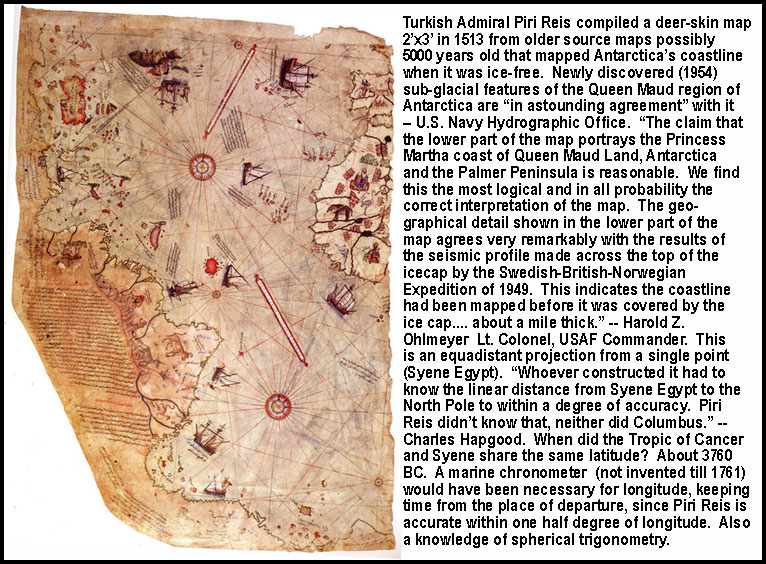
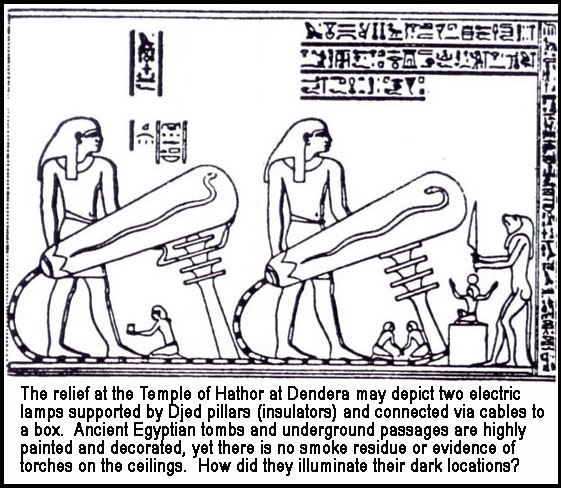
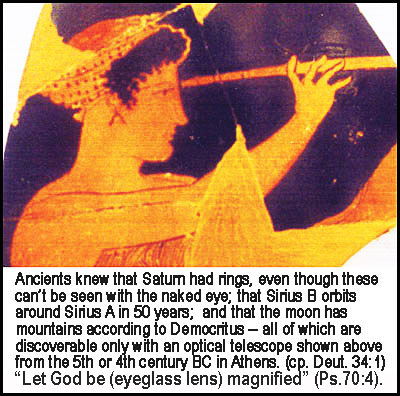
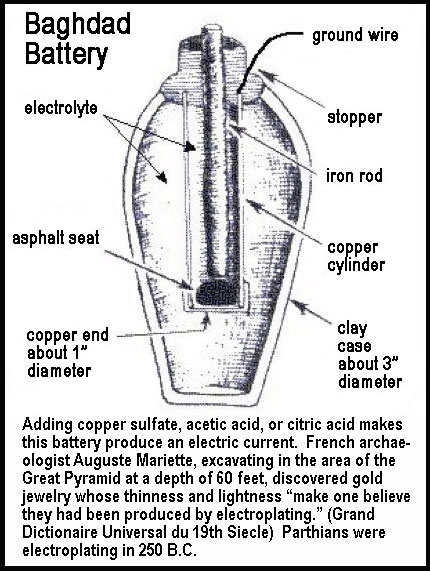
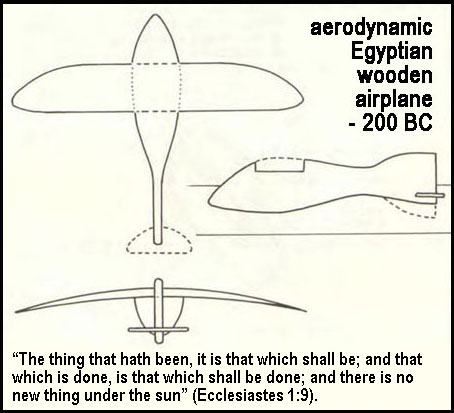
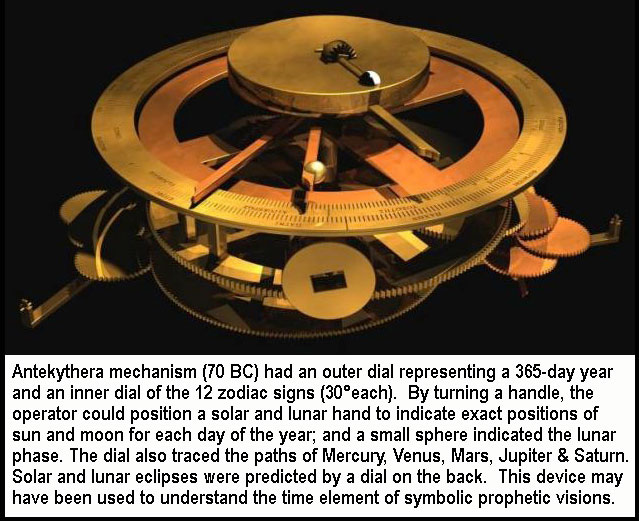

..jpg)
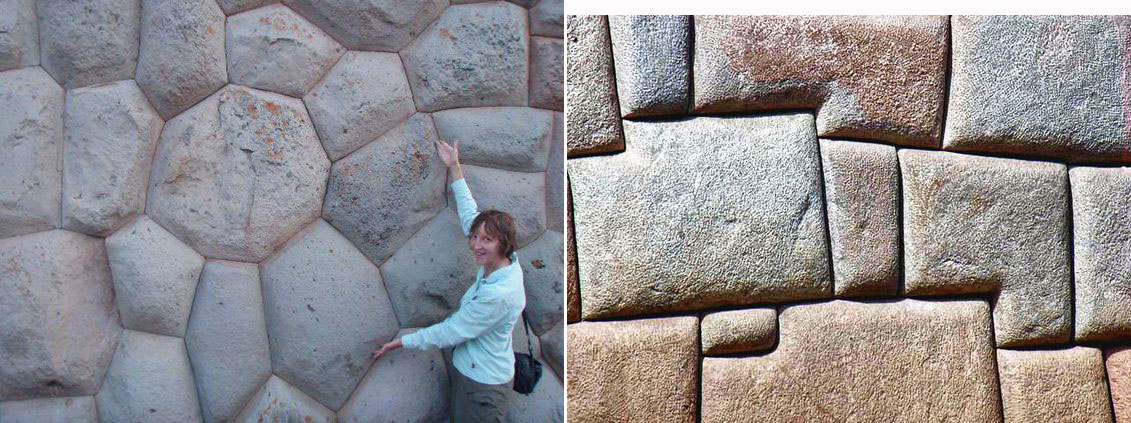
"Now Nothing Will Be Withheld From Them, Which They Have Imagined to Do" (Gen. 11:6)
Many Advanced Technologies Were Probably Known to the Antediluvians That Were Lost After Babel and Which We Can't Duplicate Even Today
"As in the days of Noah were, so shall the coming of the Son of Man be" (Matt. 24:37). What does our modern society uniquely have in common with antediluvian society? We know the earth was "corrupt" (Gen. 6:12). What does "corrupt" mean? According to Jasher, "the sons of men in those days took from the cattle of the earth, the beasts of the field and the fowls of the air, and taught the mixture of animals of one species with the other, in order therewith to provoke the Lord; and God saw the whole earth and it was corrupt ... all men and all animals" (4:18). Just like our GENETICALLY MODIFIED ORGANISMS of today. The Covid 19 vaccine permanently rewrites our DNA, changing our instruction code. Also "corrupt" can refer to antediluvians creating environmental POLLUTION just like our industrial society. They must have had a POPULATION EXPLOSION since "men began to multiply" (Gen. 6:1) just as we have that same problem today; They must have had a "KNOWLEDGE EXPLOSION" just like our day today when "knowledge shall be increased" [multiplied] (Dan. 12:4). "Ever learning, and never able to come to a knowledge of the truth" (2 Tim. 3:7). Furthermore, men were "WICKED" "VIOLENT" and "CORRUPT" just like our society today. Because "they were slaves of their wicked pleasures" Noah "was afraid they would kill him" for trying to persuade them to change "so he departed out of that land" (Antiq. 1:3:1). They argued that "God does not exist" (Jasher 6:19). But the most outstanding characteristic of our age is ADVANCED TECHNOLOGY which implies antediluvians possessed great advancement in technology also. Men lived 900 years on average, and had at least 1,656 years to advance their technology before the Flood. They even had the assistance of fallen angels (See Gen. 6:2, 4; Jude 6), with whose help, "nothing will be restrained from them, which they have imagined to do" (Gen. 11:6-8). Just like today we seek after "space alien" technology. They were all of one language -- no language barrier. In 1500 years (from the Fall of Rome in 476 to the Apollo moon landing and beyond in 1976), modern humankind, limited to a 75-year life span, and speaking many languages, advanced from the dark ages to developing telecommunications and sending men to the Moon. Antediluvian civilization could easily have achieved the same results. Sand turned from silicon into glass in the Indian Desert could be caused only by a nuclear explosion -- known as a "brahmastra". The face on Mars may indicate ancient space technology. Erich von Daniken documented a number of "ancient mysteries" in his books Chariots of the Gods and In Search of Ancient Gods to determine just how advanced ancient civilizations were. See also The Puzzle of Ancient Man by Chittick and Lost Technologies of Ancient Egypt by Dunn. Also Technology of the Gods by Childress, Ancient Man: A Handbook of Puzzling Artifacts by Corliss, Crystal Sun by Temple, Mysteries From Forgotten Worlds by Berlitz and Lost Ancient Technology by Foerster.
For instance, Puma Punka's perfectly carved and intersecting stones in Bolivia are works of precision with smooth bore holes. There are 100-ton slabs of rock at Puma Punka. These stone blocks were buried under mud at 13000 feet indicating they were part of a pre-flood civilization destroyed by the Flood. The site has been reconstructed. Laos has a Plain of Jars -- 3000 huge stone jars -- each weighing well over a ton and standing up to ten feet high (Some weighing up to 30 tons). Lip rims suggest they once had lids and we find circular disks of stone nearby which presumably are those lids. They are located uphill from a quarry about ten kilometers away. Legend says giants once lived there and used the jars to store their rice wine. Cuzco Peru's Stone Walls of Sacsayhuaman with stones up to 150 tons each so precisely cut they fit together with no adhesive and with rounded corners and leaning inward showing advanced building techniques. Baalbeck's 1000-ton shaped blocks -- largest granite blocks in the world -- forming the foundation of the Temple of Jupiter built on top of them by the Romans. How were they moved into position? Large stone spheres are found in Costa Rica, Los Angeles, Bosnia, Siberia, New Zealand, Italy and China. The Serapium of Sacara are 24 black boxes more than 100 tons each, carved accurately from solid Aswan Granite. Miniscule copper-and-tungsten coils from 1/10000" to 1" considered nanotechnology buried 40' below the surface of a river in the Ural Mountains. Stone cutting hole saws. Vimana aircraft. Where did the technology of the post-flood world come from, such as the more recent Antikythera mechanism, Chinese compass, electro-plating, and Bagdad batteries? Ancient scholar Aurelius Augustine writes about the everburning lamp in the Temple of Isis in Egypt that was unaffected by rain or storm. The "electric arc" in the Alexandria lighthouse was seen 35 miles away which could only come from an electric light source. Abaras carried a magnetic guiding arrow (compass) which Pythagoras gave him "in order that it may be useful to him in all difficulties in his long journey." (Herodotus 4:37). Martinius tells us that the Chinese anciently used the magnet in navigation : Gilbert, that the Arabs did so in traversing deserts. The ancient Egyptian wooden airplane in a tomb at Saqqara dated about 200 BC. The manufacture of glass was carried on in Egypt prior to 2000 BC. The paintings at Beni Hassen represent glass-blowers moulding all manner of articles. Glass bottles, and various other objects of the same material, are found in great numbers in the tombs. They could color glass with processes superior to what we can do today. They successfully imitated the variegated hues of insects and stones. They were able to manufacture precious gems, so similar to natural gems, as to defy detection. This was a lucrative profession. The sacred scarabaei (beetles) were reproduced in glass, with linings so delicate that it is almost certain that magnifying glasses were used in manufacturing them. Glass coffins were sometimes used. Processes for cutting and grinding glass, patented quite recently among us as a new discovery, were well known to the Egyptian artists. (p. 39, Myers Outlines of Ancient History). Optical lenses with one adjusted for astigmatism; and a telescope. "A lense of considerable power was found in the ruins of Babylon; it was an inch and a half in diameter and nine-tenths of an inch thick." (Layard's Nineveh & Babylon pp.16-17). Nero used optical glasses when he watched gladiator fights. Plutarch speaks of optical instruments used by Archimedes "to manifest to the eye the largeness of the sun." Plutarch held the moon to be of a terrestrial nature; which he says, "Glasses show in an eclipse." Diodorus Siculus says, "The motions and periods and stations of the planets were well known to the ancient Egyptians". Druids used magnifiers for astronomical purposes (Primitive History, p.16). Plutarch mentions Pythagorean teachers as maintaining that the earth revolves around the sun. Dentistry. Brain surgery called trephination. The Persian evaporative cooler was known as a Yakhchal (ice pit). Used for preserving food, it had two-meter-thick insulated walls at base. Hot air rose up and out the conical top while cool air breezes flowed in at the base through windcatchers. If we accept the account of Strabo that Eratosthenes in 250 BC measured the circumference of the earth as 252,000 stadia, the circumference would be 24,662 miles, and the polar diameter 7,850 miles -- only 50 miles short of the true polar diameter. This is considered to be one of the first great triumphs of scientific calculation. Aristarchus in 280 BC "supposed that the fixed stars and the sun are immovable, but that the earth is carried round the sun in a circle." Eudoxus (400-355 BC) was the first Greek to use a globe as a model for the earth. Herodotus mention s that Neco's expedition circumnavigated Africa. "In the wanderings of the heroes returning from Troy, Aristoricus makes Menelaus circumnavigate Africa more than 500 years before Neco sailed from Gedeira to India" (Cosmos vol.2 p.144). Anaxagorus (500-428 BC) discovered that "the moon is eclipsed by the earth screening the sun's light from it. The sun is eclipsed ... when the moon screens it from us."
.jpg)
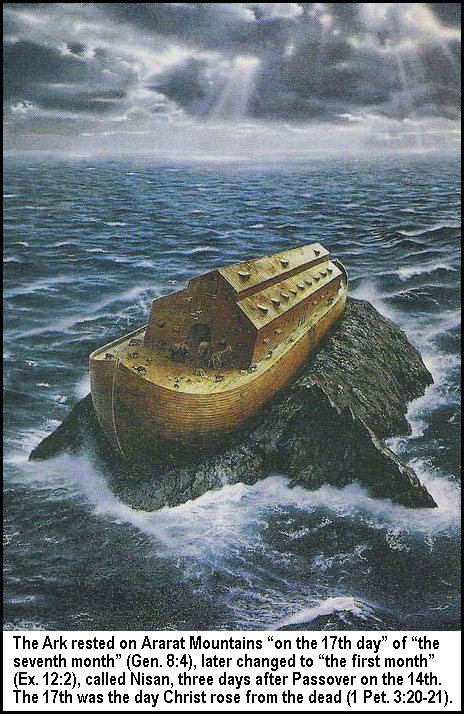

Secular History Confirms Noah's Flood in 2304 BC -- "The Mountains Rose; the Valleys Sank Down To the Place Which You Established for Them" (Ps. 104:8; NASB)
The name Methuselah means "When he dies, the flood will come." So 1656 years after the Creation of man, Noah's Flood occurred in 2304 BC (Gen. 7) resulting in "this present evil world" (Gal. 1:4) with "seedtime and harvest, and cold and heat, and summer and winter" (Gen. 8:22) due to the earth's axis now being tilted 23.5 degrees. Originally the earth's axis stood perpendicular to the plain of its orbit around the sun by which means the sun being always in the equator, produced a perpetual equality of day and night as well as a perpetual springtime. "In those days Noah saw that the earth became INCLINED, and that destruction approached" (Book of Enoch 64:1). "Jove made the springtime shorter, added winter, summer and autumn" (Ovid's Meta. 1:116-117). The water-vapor canopy condensed out of the sky and rained down "forty days and forty nights" (Gen. 7:12). The earth was no longer a greenhouse. Longevity decreased with more radiation entering the atmosphere (Gen. 11:10-26). Rain and rainbows became common (Gen. 9:13). Eight people were saved (1 Pet. 3:20). We read in 2 Esdras 6:42 that "Upon the third day thou didst command that the waters should be gathered in the seventh part of the earth: six parts hast thou dried up and kept them, to the intent that of these some being planted of God and tilled, might serve thee." In other words, today's world of vast oceans has covered up many land bridges and former continents of Atlantis, Mu and Lemuria of the ante-diluvians. Our post-flood Earth's surface is about 71% water, while the other 29% consists of continents and islands.
"It may also be observed that in the regions far remote from the Euphrates and Tigris, viz., Italy, Switzerland, Germany, England, the United States, etc., there are frequently found, in places scores of leagues from the sea, and even on the tops of high mountains, whole trees sunk deep under ground, as also teeth and bones of animals, fishes entire, sea-shells, ears of corn, etc., petrified; which the best naturalists are agreed could never have come there, but by the deluge" (Encyclopedia of Religious Knowledge, art. Deluge).
The Egyptian account from a text of the Book of the Dead: “And further I (the god Tum) am going to deface all I have done; this earth will become water (or an ocean) through an inundation, as it was at the beginning” (quoted by Skinner, p. 175). Perhaps also another Flood account may be Typhon, a personification of the sea (the Greek word Fumo seems to confirm it), enticing Osiris into an ark, which was then closed, and he was forced to sea. It is a curious fact that he embarked on the 17th day of the month Athyr, the very day, most probably, when Noah entered the ark ("in the second month, the seventeenth day of the month" -- Gen. 7:11). Plutarch writes that the Constellation Argo (G and K being commutable letters) represented the ship of Osiris. The Greeks called both a ship and temple, Naos. Bochart supposes the Ark was built at Strabo's Cyparisson, near a passage leading to Babylon and Seleucia. She drifted towards the north; hence the star Canopus, in the southern hemisphere, is on the ship's stern: which is so named from the Saxon stern, and the Islandic starn, a star. To this day the Arabs express the general Deluge by the word Al Tufan (Universal History 1:200). Egyptians call the the salt of the sea Typhon's foam (pp.42, 54, Plutarch's Isis and Osiris).
The Hindu account is found in the ancient poem of the Bhagavata-Purana (as well as the two more ancient versions: Catapatha Brahmana and Mahabhurata) where we read about a flood that destroyed all mankind, except a pious prince, with seven of his attendants and their wives. The whole race of men became corrupt, except the seven Rishis and Satyavrata, who then reigned in Dravira. Vishnu appeared to him in the shape of a small fish and warned him that in seven days (cp. Gen. 7:4) all creatures who have offended me shall be destroyed by a deluge. Take medicinal herbs, grain and pairs of all animals and enter the ark. They did and were saved. The deluge lasted a day of Brahma (i.e. a year). Manu, whom the Hindoos regard as the great progenitor of the race, was warned, their tradition said, by a great fish, that the earth was about to be engulfed. He was told to build a ship, and to put into it all kinds of seeds, together with the seven rishis, or holy beings. Seven companions plus himself makes eight in the ark (2 Pet. 3:20). The fish-god told Satyavrata to deposit the sacred writings in a safe place. Another coincidence is that Manu is called Satya, that is, "the righteous," the epithet applied to Noah (Gen. 6:9; 2 Pet. 2:5). The flood came as announced, and covered the whole earth. The ship was made fast to the horns of the fish, which drew it on in safety, and finally landed it on the loftiest summit of the Himalayas. Manu was permitted by God to create the new race of mankind. He lived during the golden age (Sir Wm. Jones's Asiatic Researches, vol. 2; on Chronology of the Hindoos). "And according to the Pauranias and the followers of Buddha," says Capt. Wilford, "the ark rested on the mountain of Aryavarta, Aryawart, or India." (same work, vol. 6, p. 521).
The Greek account was preserved by Lucian, Plutarch, Ovid, Plato and others. Zeus resolved to destroy the men of the bronze age. Lucian says, "all those of that former generation perished.... Being of a violent and ferocious temper, they were guilty of every sort of lawlessness (cp. Gen. 6:5). They neither regarded the obligation of oaths, nor the rights of hospitality, nor the prayers of the suppliant; wherefore a great calamity befell them.... the whole world was inundated ... Deucalion alone was left ... on account of his extraordinary wisdom and piety.... he caused his sons and their wives to enter into a large ark which he had provided ... while he was embarking, swine, and horses, and lions, and serpents, and all other animals ... came to him in pairs.... they injured him not; but, on the contrary, the greatest harmony subsisted between them through the influence of the Deity. Thus they all sailed together ... so long as the waters prevailed.... Deucalion ... erected altars" (Lucian De Dea Syra 12). Plutarch adds that "Deucalion sent a dove out of the ark; which, when it returned to him, showed that the storm was not yet abated; but when he saw it no more, he concluded that the sky was become serene again." (Plutarch De Solert. Animal. 13, p.37). Plutarch's account of the Flood commences when the Sun pervaded Scorpio. Ovid says that "the gods, to punish the wickedness of man, destroyed the earth with a deluge. The destruction was so complete, that only Deucalion and Pyrrha escaped to the top of mount Parnassus" (Ovid's Meta. book 1:313-347) or Olympus when the waters subsided. They repeopled the earth by throwing stones behind their shoulders. The rocks thrown by Deucalion became Men, and the rock thrown by Pyrrha became Women, and the Earth was repopulated (Strabo 9:442; Pindar Olymp. 9:64; Ovid. Meta 1:260-415; Plato's Laws, book 3, Timaeus 22 & Critias 111-112).
The Iranians have an ancient Zoroastrian tradition (Vendidad ii. 46 et seq.) which says that Yima, the father of the human race, was warned by Ahuramazda, the good god, of the fact that the earth was to be destroyed by a devastating flood. The god commanded him to build a refuge, a garden in the form of a square, vara, protected by an inclosure, and to place therein the germs of men, of animals and of plants, in order to preserve them from extermination. When the flood came, the garden of Yima alone was spared, with all that it contained; and the announcement of its safety was brought thither by the bird Karshipta, sent by Ahuramazda.
The Roman account was preserved by Varro who says, "in ancient times, there was a universal deluge, in which the human race were nearly all destroyed." He says that the flood took place 1600 years before the first Olympiad (776 BC). Many other similar accounts of Noah's Flood exist from around the world.
The Scandinavian Edda Vafthrudnismal, str. 29, gives the same tradition. The three sons of Borr, Othin, Wili and We, grandsons of Buri, the first man, slay Ymir, the father of the Hrimthursar, or ice-giants, and use his corpse for constructing the world. The blood flows from his wounds in such abundance that the whole race of giants is drowned in it, with the sole exception of Bergelmir, who is saved in a boat with his wife, and who reproduces the exterminated race.
The Chinese account mentions first a golden age, after which "men despised the Monarch of the Universe, disputes arose about truth and falsehood which banished eternal reason (loss of knowledge of God), in consequence of which they fixed their looks on terrestrial objects to excess, and became like them (directed their attention wholly to natural lusts and necessities -- selfishness). Such was the source of all crimes. Then the pillars of heaven were broken, the Sun, Moon and Stars changed their motions, the earth fell to pieces and the waters enclosed within its bosom burst forth with violence and overflowed it." (Faber, Origin of Pagan Idolatry 2:139-141). Puencu, with his family escaped out of the general deluge (Vossius, Ep ad Andr. Colvium, p.409). Another Chinese story relates that "After the great worldwide flood, a man named Yu surveyed the land of China and divided it into sections. He built channels to drain the water off to the sea and helped make the land livable again. Many snakes and dragons were driven off from the marshlands when Yu created the new farmlands." (The Great Dinosaur Mystery, p.42).
Melo, a bitter enemy of the Jews, relates that the person who was saved, along with his sons, from the waters of the flood, was afterwards driven away from Armenia by the natives, and expelled from his house and possessions. Upon this, he retired into the mountains of Syria (Euseb. Praep. Evang. 9:19). Herodotus 4:49 mentions the river NOAS in Thrace; it is a branch of the Danube. Pliny tells us there was a town of that name near the Red Sea. Suidas mentions the town NOAE in Sicily. Also NO in Egypt. The Egyptians had some reminiscences of the Deluge, as the hieroglyphic inscriptions show the name of "Noah," variously written as Nh, Nuh, Num, and Noa, who was worshipped as "the god of water," and who has been identified by Dr. S. Birch with the deified man who was entitled "the father of the gods," and "the giver of mystic life to all beneath him." According to Plutarch it would appear as if Egyptian tradition had represented Noah under this name, when Typhon, a personification of the ocean, enticed him into the ark, which was closed, and then forced out to sea through the Tanaitic mouth of the Nile. Plutarch says, "These things were done upon the 17th day of the month Atayr, when the sun was in Scorpio, in the twenty-eighth year of Osiris' reign." (Plutarch, De Iside et Osiride, 13). Yes, it was "in the 17th day of the second month the foundations of the great deep were broken up" (Gen. 7:11).
A great Festival of the Dead is celebrated by nations widely separated by oceans and centuries of time. This festival is universally held on the very day the Flood took place -- "the seventeenth day of the second month" (Gen. 7:11). Since the Jewish civil year began at or after the autumn equinox about September 20th, that would place this festival in early November. Mr. Haliburton says: "The festival of the dead, or feast of ancestors, is now, or was, formerly observed at or near the beginning of November by the Peruvians (Ayamarca meaning "corpse carrying"), the Hindus, the Pacific Islanders, the people of the Tonga Islands, the Australians, the ancient Persians (Durga -- 17th Nov.), the ancient Egyptians (17th day of Athur), and the northern nations of Europe (Halloween or All Saint's Day -- Nov. 1), and continued for three days among the Japanese, the Hindus, the Australians, the ancient Romans and the ancient Egyptians. Wherever the Roman Catholic Church exists, solemn Mass for All Souls is said on 2nd November and on that day the gay Parisians ... lunch at the graves of their relatives and hold unconsciously their 'feast of ancestors" on the very same day that savages in far-distant quarters of the globe observe, in a similar manner, their festival of the dead. The festival in Mexico was held on the 17th of November because they "had a tradition that at that time the world had been previously destroyed; and they dreaded lest a similar catastrophe would, at the end of a cycle, annihilate the human race." (Life and Work at the Great Pyramid by Piazzi Smith, 2:372-373, 390 & The Worship of the Dead by Garnier, p. 4-5 & New Biblical Guide, vol.2, pp.304-309).
| "In tales of ancient lore 'tis said -- O'er earth, the whelming waters spread" -- Pindar Olymp. 9:75 "Your powers employ, And this bad world, as Jove requires, destroy. Let loose the reins to all your watery store, Bear down the dams, and open every door." -- Ovid Metam. "Now land and sea no different visage bore, For all was sea, nor had the sea a shore." -- Ovid Metam. 291-292 "The frighted wolf now swims among the sheep; The yellow lion wanders in the deep: His rapid force no longer helps the boar: The stag swims faster than he ran before. The fowls, long beating on their wings in vain, Despair of land, and drop into the main." -- Ovid Metam. 1:293-312 "High on the summit of this dubious cliff, Deucalion wafting, moored his little skiff. He with his wife were only left behind Of perished man; they two were human kind." -- Ovid Metam. 1:316 "And every timorous native of the plain High-floating swam amid the boundless rain." -- Horace 1:2 "The water ceased, and the continual rain; And rivers ran within their banks again." -- Lucretius de rer. nat. 5:412 "Jove's wondrous bow, of three celestial dyes, Placed as a sign to man amid the skies." -- Homer Iliad 11:27 "Succeeding times a silver age behold, Excelling brass, but more excelled by gold. Then summer, autumn, winter did appear; And spring was but a season of the year. Then ploughs for seed the fruitful furrows broke, And oxen laboured first beneath the yoke." -- Ovid Meta. 1:114 |
The Chinese say that Puoncu, with his family, escaped out of the general deluge (Vossius, ep. ad Andr. Colvium, p.409). "Among the Egyptians there is a certain tablet called 'the Old Chronicle, containing thirty dynasties in 113 descents during the long period of 36525 years.... The Chronicle runs as follows:... Next in order are the demi-gods, in number EIGHT, who reigned 217 years'" (Syncellus Chronicon 51 and Eusebius Chron. 6) (Cory Fragments p.137) (1 Pet. 3:20). "The great deluge of Deucalion drowned everything that had life; one ark, containing the remnant of the human race, alone being saved." -- Lucianus de Saltat. 39 "In the deluge which happened in the time of Deucalion, almost all flesh died." -- Diod. Sic. 1:10 "I remarked that shells are found on the mountains of Egypt" -- Herodotus 2:12 "Eratosthenes points out ... our finding, often quite inland ... from the sea, vast numbers of mussel, oyster, and scallop shells, and salt water lakes." -- Strabo 1:3 According to the North Dakota Indians: "When the flood came and destroyed the world, a very great man, called Waesac-koochack, made a large raft, and embarked with otters, beavers, deer, and other kinds of animals. After it had floated for some time he put out an otter, which dived very deep without finding any bottom, and then a beaver; both were drowned. At last a musk brought up a little mud in its mouth, which he made into a new earth." (p.131, West Journal (of North American Indians) The Indians of Cuba say an old man embarked in a canoe to escape a deluge (1 Clav. Mex. p.204). One of them told De Cabrera, "that an old man, knowing that a flood was to come, built a great ship, and went into it, with his family and many animals. He sent out a crow, who first stayed to feed on the dead animals; but afterwards returned with a green branch." (Herrera's History of America). |
The British Hu, who sailed over the flood with seven companions, was called the sacrificer. On quitting the ark, he built an altar and sacrificed to the gods. The Hindu poem Mahabharat relates that God warned King Manu of an inundation and ordered him to build a ship and to put seeds of all vegetables into it and enter it. Manu obeyed. The ship floated many years on the waters, till it grounded on the summit of the Himovan mountains. (Bepp, Diluv. Mahab.) In the Hindu's 8th Book of the Bhagawata Purana, the fish god Vishnu says, "the sea will overwhelm the world. I mean to save you (pious King Satya Vrata) and the seven holy men from this deluge. Prepare for it. I will send you a vessel, in which you will put all sorts of seeds, fruits and roots. You will enter it and be in darkness and be carried on the waters.... I take the form of a fish to preserve you" (Baga Vadam, p.213, in French 1788) Humboldt quoted from the MSS. of Pedro de Los Reos, who in 1566, copied on the spot all the hieroglyphical paintings he could procure (in Mexico): "before the great inundation, which took place 4,800 years after the creation of the world, the country of Anahuac was inhabited by giants. All those who did not perish were transformed into fishes, save seven, who fled into caverns. When the waters subsided, one of these giants, Xelhua, surnamed the Architect, went to Cholollan; where, as a memorial of the mountain Tlaloc, which had served for an asylum to himself and his six brethren, he built an artificial hill in the form of a pyramid" (Humboldt's Researches1:96) In Mexico, one man (Coxcox) and one woman (Xochiquetzal) saved themselves in the trunk of a Cypress tree covered with leaves and floating amid the waters. It came to rest at Mount Colhuacan (Ararat). He sent out a vulture which didn't return and a hummingbird which returned with a green branch in its beak (Humboldt Researches 2:23,65) |
Where did the ark land? 1.) "The ark rested upon the mountains of Ararat." The name Ararat occurs four times in the Hebrew Old Testament (Gen. 8:4; Jer. 51:27; 2 Ki. 19:37; Isa. 37:38). In each case it is the name of a country -- Armenia. Josephus confirms that Armenia is the place (Ant. 1:3,6). 2.) Nicolaus of Damascus, quoted by Josephus, says, "There is a mountain in Armenia, over Minyas, called Baris, upon which it is reported that many who fled at the time of the deluge were saved." Now this Minyas, mentioned in connection with Armenia, must be the same as the Minni mentioned by Jeremiah in connection with Ararat, for Minyas is merely Minni with the termination as; consequently, if Minyas is Minni, Armenia is the same as Ararat. Baris means barque or ship in ancient Egyptian and Mount Baris means mountain of the ship in ancient Egyptian. Like the English name barge or bark. 3.) Berosus says, speaking of Xisuthrus' ship, "It is said there is still some part of this ship in Armenia at the mountains of the Cordaeans." 4.) Josephus himself says, "The Armenians call the place where Noah landed Apobaterion, or the place of descent; and that remains of the ark were shown there by the inhabitants." 5.) Abydenus, a Greek writer, also speaks of a person named Sisuthrus being saved, and says his ship rested in Armenia, and that pieces of the ark were used as charms. 6.) Two Chaldee versions of the Old Testament called Targums (Onkelos & another one), use the word Kardu instead of Ararat in Genesis 8:4 and two other scriptures. According to Buxtorf, the term "Kardyan" was in Chaldee synonymous with "Armenian". Now the Kardu or Kirdi Mountains are in the southern part of Armenia, and were called by the Greeks Gordaean or Cordaean mountains. This agrees with Berosus. 7.) The Mohammedans have a prevailing tradition that the place where the ark rested was in the Jebel Judi, which is the name they give to the Kurdi or Gordaean mountains. Jebel means mountains, and Judi is a corruption of Gordi. 8.) Another reason why these mountains were the mountains of Ararat is, that they are situated to the west of the plain of Shinar, or Senjar, and so agree with the statement that they "journeyed east" (Gen. 11:2) to the plain of Shinar. 9.) The town of Themanin, which means "eight", situated at the foot of the Kurdu mountains, otherwise called the Al Judi mountains, was stated by tradition to have been built and so named in memory of the eight persons who came out of the ark on Mount Themanin. 10.) Noah built a city in Armenia at the banks of the Araxes, named Nachshevan (Noah's settlement; or Nak in Armenia being a ship, and Shivan, means rested). Ptolemy calls it Naxuanna and Moses Chorenensis calls Idsheuan; but at the place itself Nachidshevan. The Armenians have retained to the present day a tradition that this is city was built by Noah, and that it is one of the oldest in the world. 11.) The word Sepher signifies a book; Seppara, book-town. Berosus says Sisuthrus, previous to the flood, was ordered to bury some writings in the City of the Sun at Sippara (the Sephar of Moses or Sepharvaim). Afterwards, his descendants were ordered to dig up these writings from Sippara. Might not the place from this circumstance obtain the name of the City of Books? This city was near to where the ark rested, which Berosus says was one of the Corcyrean (Caucasian) mountains in Armenia. "He (Kronos) therefore enjoined him (Xisuthrus) to commit to writing a history of the beginning, progress, and final conclusion of all things, down to the present term; and to bury these accounts securely in the city of the Sun at Sippara" (Cory's Fragments p.60).
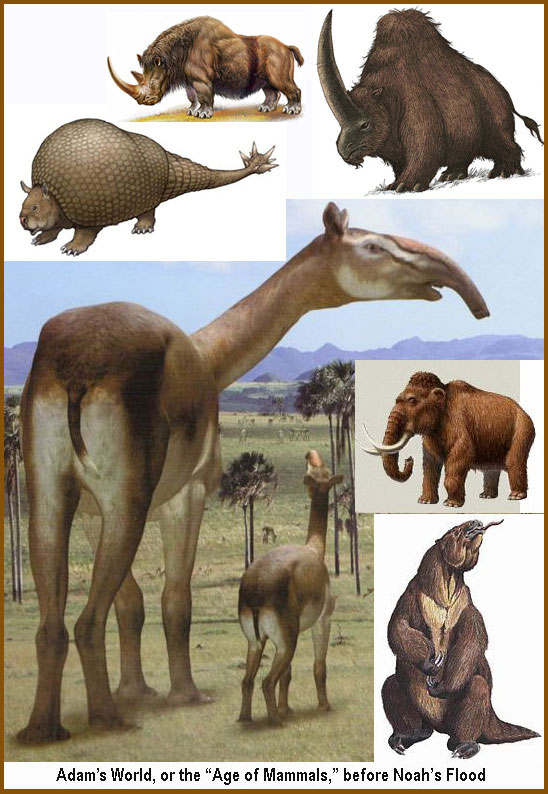
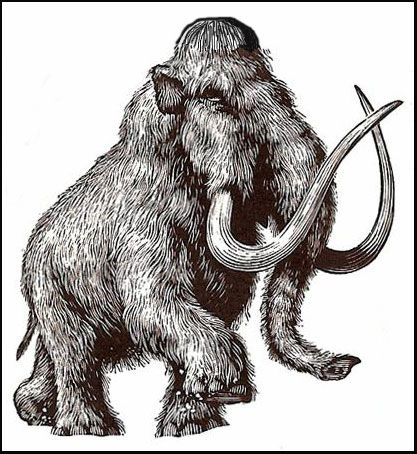

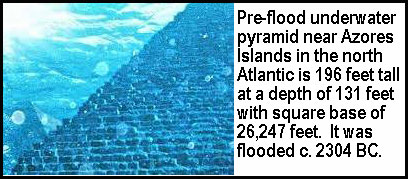

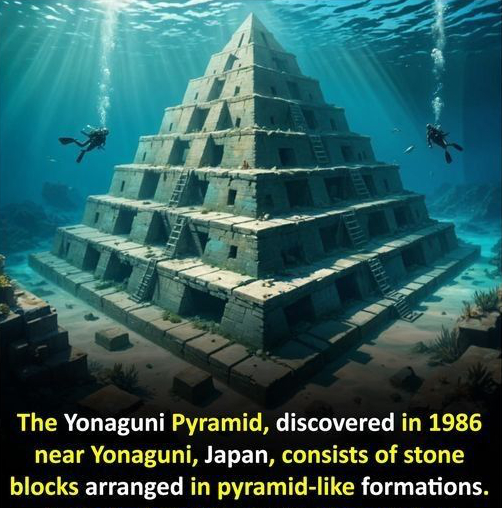
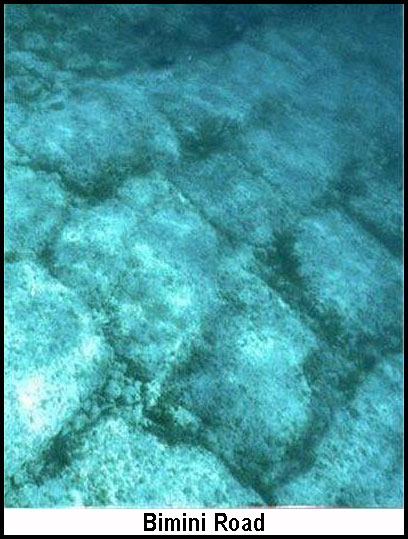
Woolly Mammoths Flash Frozen in "Ice Age" Commencing 2304 BC
Noah was told to take "of every living thing of all flesh, two of every sort shalt thou bring into the ark, to keep them alive with thee; they shall be male and female" (Gen. 6:19). This clearly reveals why so many mammals became extinct. Noah took representatives of various mammal groups -- but definitely not every variety. From the limited number of creatures in the ark, the world of today has been repopulated. The varieties of elephants existing today, for example, are much more limited than before the flood. The wooly mammoth and mastodon, relatives of the modern elephant, died in the flood. Representatives of elephants which Noah took on board the ark simply have not diversified back into those earlier varieties. The same can be said of other species. Where are the saber-tooth tigers, the glyptodonts, toxodonts, macrauchenia, ground sloths, and wooly rhinoceros?
A 300 degree below zero Farehnheit ice meteor came flying toward earth and either broke up in space or actually hit the earth first and then broke up. (There is water everywhere in space.) As it was breaking up, some of the fragments got caught and became the rings around the planets, or the craters on the moon, or the craters on some of the planets, and what was left over came down and was splattered on top of the north and south pole. The impact made the earth wobble around for a few thousand years afterward. Either that or the fact that the ice particles settled mainly around the poles caused the earth to wobble. This super cold snow fell mostly on the poles, burying the mammoths standing up. They were flash-frozen. Estimates are that 5 million mammoths perished in this catastrophe. They were frozen with undigested food in their mouths and stomachs. They died of suffocation -- no water found in their lungs but small ice crystals found in their blood indicate they probably froze in less than 5 hours. That requires a colder temperature than 300 degrees Farenheit below zero. "These fossils of the Siberian permafrost present an insuperable difficulty for a theory of slow, gradual geology ... no gradualistic process can result in the preservation of tens of thousands of tusks and whole individuals, even if they died in the winter. They must have been frozen suddenly" (Harold E. Lippman, "Frozen Mammoths," Science, Vol. 137, August 10, 1962, p. 449). Heaps of tusks were found in Siberia. For example, in the few decades preceding 1899, one report stated that about 20,000 tusks had been exported for the ivory trade. These were in perfect condition. Mammoths are not designed for cold weather. In Barrow Alaska a drilling rig drilled into a 300-foot tall tree under the permafrost. On the New Siberian Islands, they find frozen bobcats, frozen lynx, bison, mammoths, camels, etc. They find coal under the ice in Antarctica where there are no trees. Admiral Byrd found frozen palm leaves near the South Pole.
After the earth was hit by the ice meteor, or after the dumping of ice on the north and south poles, the crust of the earth cracked releasing the fountains of the deep (Gen. 7:11). (The pre-flood world had water under the earth also.) The earth broke up into plates at fault lines such as the San Andreas Fault, the New Madrid Fault, etcetera. The water under the crust was hot and came shooting to the surface and continued for 150 days killing everything within a few hundred miles immediately. Everyone drowned eventually but that process may have taken 6-8 months to kill everyone during that flood. A 200-foot tidal change every 6 hours and 25 minutes caused the sorting into layers during the flood. Psalm 104:7-8 mentions this tidal action. Genesis 8:23 mentions "going and returning" or sloshing tides. Noah stayed in the ark for six months because of this tidal action and the ground was probably still muddy.
The spreading ice caused the "ice-age" effect and the glacier effects we see. Ice came all the way down to Kansas City, Missouri (Extent of Ice Age, Scott Foresman, Earth Science, 1990, p.316). The ice age really happened -- at the beginning of the flood. It caused the flood. The ice caps at the poles sent off a cold wave. This cold air hitting warm air caused it to rain, and it rained for 40 days and 40 nights. The canopy collapsed. All fountains of the deep broken open in one day. (see Jasher 6:11) Fragments of the ice meteor made the canopy collapse that used to protect the earth. More UV light entered.
During the first few months of the flood, the dead animals would settle out and the dead plants would settle out. Once buried, they would become coal if plants and oil if animals. Natural gas deposits also formed during the flood. Those are still found today in huge graveyards. During the last few months of the flood, the unstable plates of the earth would shift around. Some places would lift up forming mountain ranges, other places sink down forming ocean basins. "The mountains rose, the valleys sank down to the place which thou didst appoint for them. Thou didst set a bound which they should not pass, so that they might not again cover the earth" (Ps. 104:8-9). The fact that Mt. Ararat has salt crystals at the 14000 foot level which only form under water, and the fact that pillow lava is also found high on Mt. Ararat which only forms under water, both indicate that this mountain was lifted up from under the water. The runoff from all the mountain ranges would cause incredible erosion in a couple of weeks -- like Grand Canyon.
Over the next few hundred years, the ice caps would melt back retreating to their current size. The added water formed the continental shelf. Oceans became deeper, wider and colder as the water level rose. The cold water would also absorb more CO2 (Carbon Dioxide) out of the atmosphere which would allow more radiation to get in shortening the life span of people (Joktan means "Shorten"-- Jasher 7:19-20). Some of the greenhouse protection was removed. In the days of Peleg it finally took effect. The earth was "Divided" -- the meaning of Peleg's name (Gen. 10:25). The continents were divided when the water level rose. Peleg was born about 100 years after the flood. He only lived to be 209. His father, grandfather and great grandfather lived to be in their 400s. Why are unique species such as kangaroos, wombats and koalas only found in Australia? They walked there. Because originally the continents were all connected for the first few hundred years after the flood. Populations spread out across the globe, and became "trapped" on their continents by the rising water. Non-aggressive and less aggressive animals were constantly being pushed to the migratory fringes. They would rather run than fight. While this was happening, the waters were rising up because the ice caps were melting back. All of a sudden, Australia -- which used to be part of the mainland -- was a protected island.
Not only that, there are ancient Egyptian cities discovered under 30 feet of water in the Mediterranean Sea. The sea level was lower at some point in the past. Cities have been discovered under water in Cabo de San Antonio, Cuba (1/2 mile down) and Mahabalipuram, India (several square miles) and Bimini Road, Bahamas. The underwater road off the coast of Florida was paved with magnesium oxide. Yona Guni, a city off the coast of Japan, is two football fields wide and about eight stories high. In the north Atlantic are carved rock columns 6000 feet under the ocean. Also, miles of pillared temples, buildings and statues. Wide curving boulevards and roads radiating out like spokes from a wheel. Gibraltar was a spillway when the Atlantic got too high. Then Sicily was the next spillway and then the Bosporus. Skeptics are "willingly ignorant" of this evidence (2 Pet. 3:5).
Scientists have reported discovering the first set of dinosaur fossils ever to be found in the interior of Antarctica. The fossils are said to be the remains of a plant-eating dinosaur, 25 to 30 feet long, that lived about 200 million years ago in what geologists call the early Jurassic age. The bones were spotted at a small section of exposed rock alongside the mountain, which lies about 400 miles from the south pole (Chris Raymond, "Scientists Report Finding Fossils of Dinosaurs in Antarctica's Interior," Chronicle of Higher Education -- March 20, 1991, p.A11). Also "the discovery of thousands of well-preserved leaves in Antarctica ... enjoyed a near temperate climate." Tropical plant-eating dinosaurs have also been found in northern Alaska. Mammoths are not designed for cold weather.
When climbers got to the top of Mount Everest, they found petrified clams -- in the closed position. When a clam dies, it opens. How would you get millions of petrified clams in the closed position on top of mountains all over the world? Mount Everest is quite a way from the beach. Clams don't climb mountains. They were buried alive in huge beds sometimes. Oysters 11.5 feet wide are found in Peru two miles above sea level (Holt, Modern Earth Science, 1983, p.207).
Any spinning top behaves in a peculiar way whenever it is struck by anything. If you throw a rock at a spinning top, it will wobble around for awhile (gyroscope) and then it will slowly recover and stabilize -- usually at a new angle or axis. "Scientists studying underwater volcanoes have found evidence the earth may have wobbled like an out-of-balance ball 84 million years ago, relocating the poles and shifting the location of Washington to the tropics." (By Randolph E. Schmid APO Washington MSNBC, Jan. 20, 2000). Today the earth is tilted 23.5 degrees. But was it always that way? Stonehenge is an interesting stone structure. It was built to worship the sun at summer solstice. It tracks the solar solstice shadow. But today stonehenge doesn't line up. The temple of Amen-Ra was drawn by Napoleon's savants in 1798. The colonnade aimed at the summer solostice -- longest day of the year. But it doesn't line up. Same with Eudoxus, etcetera.
The famous Australian astronomer George Dodwell conducted a study of the solstice shadows recorded by the ancients. Eudoxus, Amen-Ra, Stonehenge, etc. The recorded tilt of the earth made a wavy line on the graph that was a match of the wavy line a spinning top makes when struck by an object. It appeared to him that something struck the earth about 4350 years ago (Its A Young World After All by Ackerman) and caused the earth to wobble for several thousand years. Today the earth is stable. The north pole doesn't move much. But a graph of the earth's tilt as recorded by ancient astronomers indicates an impact 4350 years ago (2350 B.C.). Today the earth is tilted 23.5 degrees. This is what causes the seasons. The first mention of cold weather in the Bible is Genesis 8:22: "while the earth remaineth, seedtime and harvest, and cold and heat, and summer and winter ... shall not cease." (after the flood).
When a magnet floats above a superconductor, it is known as the Meisner Effect. A Japanese train operating on the Meisner Effect is suspended on superconducting coils causing magnetic levitation which gives no resistance and no friction. There are comets flying through space. These ice meteors are common in space and are normally -300 degrees to -400 degrees Fahrenheit (Holt, Modern Earth Science, 1983, p.51). An ice meteor flying through space would build up speed because of the inverse square law, as it got nearer earth. As it got going faster and faster, it would break up into a billion ice crystals. Those would then shower down on earth as a super cold snow. Huge polar ice caps formed at the time of the flood. Originally God formed the world to be inhabited (Isa. 45:18). But what we have today is uninhabitable in the arctic and antarctic regions.
Earth had a very strong magnetic field. At the time of the flood it was probably 15 to 20 times stronger than it is today. The magnetic field is weakening. Earth's magnetic field has lost 10% of its strength in the last 150 years (Astronomy and the Bible, Donald DeYoung p.18) and 40% of its strength in the last 1000 years. (If you go back 25,000 years, the magnetic strength would have been too strong for life to have existed here on earth, because of the heat generated, so evolutionists say it reverses.) The magnetic field would deflect most of the super cold ice crystals to the poles. Super cold ice is easily statically charged. The northern lights are caused because of the earth's magnetic field. The pre-flood world had a layer of ice or water suspended by the magnetic field using the Meisner Effect.
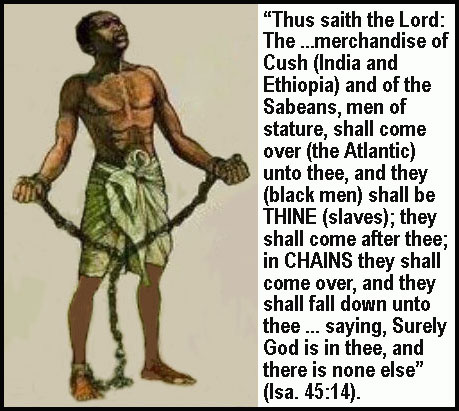
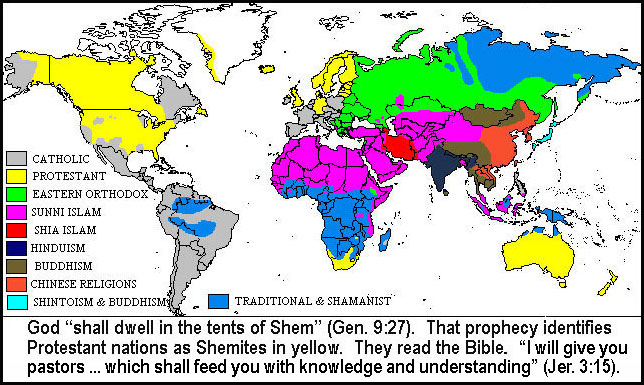
Noah's Prophecy and His Three Sons Mentioned in Secular History
"Then Noah took the three daughters of Eliakim, son of Methuselah, for wives for his sons, as the Lord had commanded Noah" (Jasher 5:35; Eutychus p.34). Which son was oldest? We can eliminate Ham since Noah "knew what his YOUNGEST son (Ham) had done unto him" (Gen. 9:24; NIV). Furthermore, Shem was 100 years old when he begat Arphaxad two years after the flood (Gen. 11:10). This indicates that Shem was 98 when the flood ended. But Genesis 7:6 and 11 both say the year-long flood began when Noah was 600 years old. So Shem would only have been 97 when Noah was 600. Therefore Shem was born when Noah was 503. Yet Noah began having his sons when he was 500 years old (Gen. 5:32); and Ham was Noah’s "YOUNGEST son" (Gen. 9:24; NIV). Therefore Japheth must have been the oldest brother, born when Noah was 500-years old. This supports translations of Genesis 10:21 which refer to Japheth as Shem’s ELDER brother. Early Aryans knew him as Djapatischta (chief of the race), Greeks referred to Japheth as Iapetos or Japetos (Aristophanes, The Clouds). Romans used Jupiter, the Saxons perpetuated his name as Iafeth. In the Hindu Bhagvat Geeta there is the account of a man named Satyaurata, preserved from the flood, who had three sons. The eldest was Jyapeti (Japheth), and to him Satyaurata gave all the area north of the Himalayas. The names of the other sons were Sharma (Shem), and Charma (Ham). The father became drunk and was mocked (VI, 1870, 6:251). East Indians called him Jyapeti or Pra-Japati. The name Jupiter was given to Ham in later ages (Jupiter-Amon) by the Greeks (Japethites), who were fond of foreign gods, to whose proper name they prefixed Jupiter, as in Jupiter-Belus, Jupiter Casius, etc. But this was incorrect since Jupiter (or Japheth) and Ham (or Amon) were brothers, not the same person.
Noah's prophecy was that "God shall ENLARGE Japheth, and He (God) shall dwell in the tents of Shem; and Canaan (Canaan's father -- Ham; the Arabic version says, "Ham the father of Canaan") shall be his SERVANT" (Gen. 9:27). "Semitic races have influenced, far more than others, the history of the world's mental progress; and the principal intellectual revolutions which have taken place are traceable in the main to them." -- George Rawlinson. He also said, "For the last three thousand years the world has been mainly indebted for its advancement to the Semitic and Indo-European races; but it was otherwise in the first ages. Egypt and Babylon, Mizraim and Nimrod -- both descendants of Ham -- led the way, and acted as the pioneers of mankind in the various untrodden fields of art, literature and science. Alphabetic writing, astronomy, history, chronology, architecture, plastic art, sculpture, navigation, agriculture, textile industry, seem all to have had their origin in one or other of these two countries," (Five Great Monarchies, vol. 1 p.75). Melchizedek (Sydyc of Sanchoniatho) was probably Shem. The Jewish and Christian religions both came through the Semitic race and both Jews and Christians "are the light of the world" (Matt. 5:14). Shem is distinguished by a knowledge of the TRUE RELIGION to this very day (the Bible). Shem was "more devout than his brothers" (p.61, Syncellus). Japheth was idolatrous and still is (Buddhist & Shinto). But Ghengis Khan and Tamerlane ENLARGED his empire. "Kronos (Ham) engaged in war, and drove Uranus (Noah) from his government" (p.50, Eusebius Prep. For Gospel). The children of Ham made little to no progress in civilization or religion and have remained the most primitive of the three branches (Hinduism & Voodoo). Noah actually cursed Ham. Ham transmitted the corrupt teaching of the giants (spells, potions, divination, etc.) down through his posterity. That is why these arts are called ALCHEMY or CHEMISTRY from CHAM or HAM. They are also known as BLACK arts. (p.19, Syncellus). Sanchoniathon speaks of the offspring of "Titans" (2:9) (Giants) as Amun" (the race of Ham -- 2:10) being associated with "Magus" (magicians -- 2:10) (see Ex. 7:11). He says their son was "Misor" -- (Mizraim or Egyptians -- Gen. 10:6). Sanchoniathon then explains that the son of Misor was "Taautus" whom "the Egyptians called Thoor, the Alexandrians Thoyth, and the Greeks Hermes" (3:1) (Mercury). The Bible calls him Cush. He was actually Mizraim's brother but successor in government. Sanchoniathon says Thoth or Hermes (Cush) "was the first who took religion out of the hands of the ignorant vulgar, and moulded it into a rational system" (corrupted the true patriarchal religion)(Sanchoniathon in Cory's Fragments, p.21).
Genesis 9:25 should be translated, "Cursed be Canaan's FATHER, a servant of servants shall he be to his brothers." Such relative words are often omitted and understood in Scripture, as in Matthew 4:21, James of Zebedee, for the SON of Zebedee; John 19:25, Mary of Cleopas, for the WIFE of Cleopas; Acts 7:16, Emmor of Sychem, for the FATHER of Sychem, as our English translation rightly supplies it from Genesis 33:19. Thus Goliath is put for Goliath’s BROTHER, as is evident by comparing 2 Samuel 21:19, with 1 Chronicles 20:5. So here Canaan may be put for the FATHER of Canaan, as the Arabic translation has it, that is, Ham, as the Septuagint here render it. Also Saadiah Gaon (882-942 AD) supplies it, as Aben Ezra relates. This makes sense since otherwise Noah addressed both Shem and Japheth while ignoring Ham his third son. Greek "mythology says KUMARBI or CRONUS (Ham) CASTRATED Uranus or Anu (Noah) so was cursed with being "a servant of servants" (Genesis 9:25-27).
We know that ALL of Ham's children became SLAVES, not just CANAAN. Egypt (Mizraim) is cursed in Ezekiel 29:15. God says, "I will DIMINISH them." Yes, after the Pharaohs were defeated, the Persians under Cambyses took over, then the Greeks under Alexander the Great, Romans, Mohammedans, Turks, French, and British. Egyptian rulers since 1953 have been Arabs. Egyptians (Mizraimites) are called 'SERVANTS" in Lamentations 5:8. Canaanites become "BONDMEN" in Joshua 9:23. Solomon also made them BONDSERVANTS (1 KI. 9:21). Later known as Phoenicians and Carthaginians, they were SUBJECTED by the Persians, Macedonians and Romans. Romans captured Carthage in 146 B.C. and made SLAVES of many thousands of Carthaginians. Canaan was bought and sold -- human "merchandise" -- the meaning of Canaan. The Phoenician Empire never rose to power again. Just as their father Ham had dishonored Noah's nakedness, so also Ethiopia (Cush) and Egypt (Mizraim) are made "NAKED ... with their buttocks UNCOVERED" as SLAVES according to Isaiah 20:4.
Libyans (Put) and Ethiopians (Cush) are UNDER the AUTHORITY of Antiochus Epiphanes in Daniel 11:43. "Thus saith the Lord: The ... merchandise of CUSH (India and Ethiopia) and of the SABEANS, men of stature, shall come over (the Atlantic) unto thee, and they (black men) shall be THINE (slaves); they shall come after thee; in CHAINS they shall come over , and they shall fall down unto thee ... saying, Surely God is in thee, and there is none else" (Isa. 45:14). Yes, the Bible predicted the slave trade. Not Canaanites, but CUSHITES are mentioned here.
Some commentators argue that Noah cursed Ham's fourth son because Ham emasculated his father to preserve his own inheritance. If Noah had had a fourth son or more, Ham would only get one quarter of the world or less rather than a third. The early Jewish commentator Rashi paraphrased Noah's rebuke of Ham: "You have brought it about that I cannot bear a fourth son to serve me; cursed, therefore, be your fourth son to serve under the descendants of these elder ones upon whom the duty of serving me will devolve from now on." It is related in the Padma-Pooraun that Satyavrata, whose miraculous preservation from a general deluge is told at large in the Matsya, had three sons, the eldest Jyapeti, or Lord of the Earth; the others were Charma and Sharma, usually pronounced Cham and Sham in the vulgar dialect. Satyavrata gave all the regions north of Himalaya, or the snowy mountains, to Jyapeti. To Sham he alotted the countries south of these mountains. But he cursed Cham, because when the old monarch was accidentally inebriated with strong liquor made of fermented rice, Cham laughed; and it was in consequence of his father's curse that he became a slave of slaves to his brothers (Hist. Hind. 2:45).
Noah was either the "eighth preacher of righteousness" (2 Pet. 2:4-5; 1. Seth 2. Enos 3. Cainan 4. Mahalaleel 5. Jared 6. Enoch 7. Lamech & 8. Noah -- Gen. 5) or "the eighth person" on the ark "a preacher of righteousness" (2 Pet. 2:5), or both, and therefore preached the commandments since "All thy commandments are righteousness" (Ps. 119:172). In India, Vishnu the Preserver is celebrated as having saved one righteous family when the world was drowned. He is identified with Noah himself since Vishnu is the Sanskrit form of "Ishnuh" -- "The Man Noah." Noah was "a just man" and "walked with God" (Gen. 6:9) when he was 480 years old -- 120 years before the flood -- and "Can two walk together, except they be agreed?" (Amos 3:3)
The Sibylline Oracles speak of Cronus (Ham), Japetus (Japheth) and Titan (Shem) as the three sons of Noah (Cory's Fragments, p.52). Similarly, in the Hindu Mythology, "Sama," (Shem) "Chama," (Ham) and "PraJapeti" (Lord Japhet) are said to be born of Menu (Noah) or Satyavarman (Noah) (Asiatic Researches, vol.8 p.255; Moor's Hindu Pantheon, p.173). The principal Titans are said to be "Saturn" (Ham or Cush), "Japetus" (Japheth) and "Typhaeus" or "Typhon" (Shem)(Lemprierre, Titanes). Horace calls men "Japeti genus" (Horace Ode 3). Hesiod represents Japetus as the father of Promethius who formed the first woman (Theogony vv. 507,515,543). Pindar also mentions the brazen "race of Japetus" (Olyn. v.66-82).
"The gods divided the universe into three shares, and each was content with that which fell to his lot." (Plut. Pomp. 53). This peaceful arrangement didn't continue for long because Ham's sons Cush and Canaan took possession of Babylon and Palestine; while the Arabian Hyksos invaded Egypt.
"There is, according to Homer, a threefold division of all things, the sea being assigned to Neptune (Shem), the dark and subterraneous parts to Pluto (Ham), but the heavens to Jupiter (Japhet)." (Max. Tyr. diss. 16)
According to Homer's Iliad, Neptune (Shem) says, "We are from Cronus (Saturn or Noah) and from Rhea sprung, Three brothers (Jupiter, Neptune and Pluto); When the universe was into three parts divided, each an equal share obtained, on casting lots. My lot it was thenceforth in hoary sea to dwell (middle regions to Shem which Canaan violated by settling in Palestine and Cush violated by settling in Babylon): to Pluto (Ham), next, did fall the gloomy shades below (southern regions: Africa & India. Egypt is called the land of Ham -- Ps. 105:23): Jupiter's (Japheth's) lot, the spacious sky in air and clouds." (northern regions: Asia & part of Europe) (Iliad 15:184-193). "The priests of Egypt, in the mysteries of Isis, call their country Chemia." (Ham) (Plutarch de Isis. et Osirid. 33) Abulfaragi the Armenian historian dates the actual division of the earth in the 140th year of Peleg. Noah "called his sons ... and he divided the earth by lot ... for Shem the middle of the earth ... the north of this is Japheth's ... And for Ham ... toward the south" (Jubilees 8:9-20). For "Japheth ... it is cold, but the land of Ham is hot, and the land of Shem has neither heat nor frost" (Jubilees 8:25). Perhaps Chedorlaomer, king of Elam made the Canaanite inhabitants of Sodom and Gomorrah pay tribute because of the very fact that they were Hamites in Shemite territory (Gen. 14).
Saturn in the primitive Egyptian and Grecian Theogony, denoted Adam, from whom time began to be computed; and afterwards Noah, from whom it was recomputed after the flood. Jupiter, Neptune and Pluto, the sons of Saturn, represented Japheth, Shem and Ham, the sons of Noah.
Bochart produces fourteen points of resemblance between Noah and Saturn (Faber's Horae Mosaicae 1:142). For instance, 1.) the suthr in Xisuthrus (Chaldee), the sithr in Sisithrus (Chaldee), and the satyaur in Satyaurata (Hindoos) is equivalent to satur in Saturn (Latin). So also is Seater (standing on the back of a fish) of the Germans. All these names are apparently connected with with Zutar, the ancient Chaldee name for a flood. 2.) Jupiter being the same as Japhet, shows that Saturn, the father of Jupiter, must be the same as Noah, the father of Japhet. 3.) The ancients state that in the days of Saturn all men were of one language, and that freedom and equality prevailed on the earth, for which reason they distinguish his reign as the Golden Age. Scripture tells us that in the time of Noah all men were of one language and that Noah was "a preacher of righteousness" (2 Pet. 2:4-5). 4.) Saturn is always represented as an old man with a scythe who taught his subjects agriculture. He introduced a new method of manuring the ground; hence he was called Stercutius by the Romans. Noah also is portrayed as a gardener who would "comfort us concerning our work, and the toil of our hands, because of the ground which the Lord hath cursed" (Gen. 5:28). Remarkably, the scythe was anciently spelled sithe -- like Si-sithr-us. Did Noah invent the scythe? The enriching manure which was thrown over the face of the habitable earth, at the time of the deluge would also make the ground productive. 5.) Alexander Polyhistor says that Saturn foretold that there should be great quantities of rain, and an ark built, in which men and animals should sail together. 6.) All high places were sacred to Saturn, and this agrees with Noah, for as he was saved in a ship which lodged against a mountain, so it is natural that high places would be dedicated to him. 7.) The ancient coins of Italy had stamped on one side a ship, in commemoration of Saturn, which agrees with Noah and his ark. 8.) Saturn made a law that nobody should see the gods naked. Ham saw Noah naked and was cursed. 9.) The seventh day of the week was named Seaterday, or Saturday just as the name Noah means "rest." Noah must have preached Sabbath-keeping.
The Persian account of the three sons of Noah are Oromasdes, Mithras (Mediator or middle) and Ahriman. They are again repeated in the mythology of the Scandinavians where Bore was the great father, and the three sons Odin, Vile and Ve (Edda, fable 3). The son of Ham (Ammon) was Cush (Saturn) and the son of Cush was Nimrod (Marduk)
Secular history refers to the Turanian or Tatar race (Ham), the Arian or Indo-European race (Japheth) and the Semitic race (Shem).
|
Since Noah lived 950 years (Gen.9:29: 2904-1954 BC), 1. he was contemporary with Fohi (Fuxi), the first emperor of China who began to reign 2952 BC and lived 932 years. (add 600 + 350 yrs - 7:11 & 9:28) Both died same year. 2. Fohi (Fuxi) had no father (Noah's ancestors perished in Flood), and 3. his mother was said to have conceived him encompassed in a RAINBOW (cp. Gen. 9:13). 4. He was born in the Yellow River just as Noah survived the Flood. 5. He raised SEVEN kinds of animals for sacrifices to the Great Spirit (cp. Gen. 7:2; 8:20). 6. Fohi (Fuxi) was "very virtuous"; he instituted marriage to avoid promiscuity; and a distinction between men's and women's clothing; no marriage between two of same name; and made humane laws; and put walls around cities; and invented Chinese Cangjie writing (Wiki; Bedford's Scripture Chronology, p.287). Noah was "just" and "a preacher of righteousness" (Gen. 6:9; 2 Pet. 2:5). 7. His wife and sister was named Nuwa (Noah). These were the original humans. 8. He "looked upward and contemplated the images in the heavens (zodiac), and looked downward and contemplated the occurrences on earth." (Wiki) (Bible star charts) 8. Fohi (Fuxi) settled in the province of Shensi, which is the most NW province of China (nearest to Ararat). The Bible says little about Noah's 350 years after the flood or the peopling of China. (Hist. Sinicam 1:21; Shuckford's Connections 1:44; Legge 1899, 41–42). The first two Chinese dynasties (Hea & Shang) commenced in 2207 B.C. and extended down to 1123 BC according to Confucius (Gutzlaff, A Sketch of Chinese History, pp.58-60). The Flood was said by Confucius to have occurred in the seven hundred and fifty-sixth year of the Kali-Yuga, which would be 2348 BC (Hamilton 1820, A Key to the Chronology of the Hindus 316). |
|
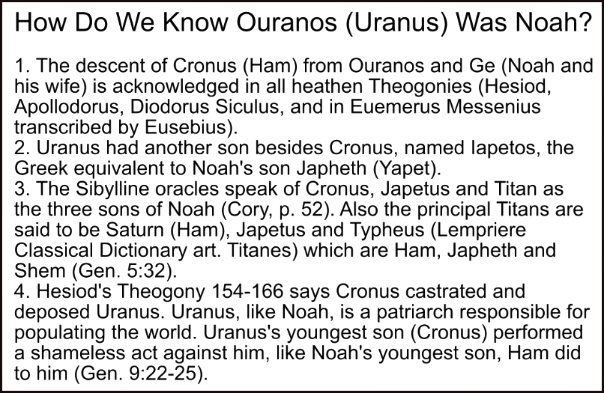
Was Naamah the Wife of Ham? Did She Make Noah Drunk? Did Ham (Thammuz) Castrate Noah?
The building of Babel, in which Cush was the ringleader, was no doubt the origin of the war of Cronus or Saturn (Cush) and the Titans against Ouranos (Noah) described by Sanchoniathon. This was the same as the war in Greek mythology of the Titans, who were Noah's descendants, against Ouranos (Noah), and in which Saturn (Cush) was ringleader (Lemprierre, Titanes and Saturnus). Cronus (Cush) won and Ouranos (Noah) fled away. They misrepresented him as "killing his children" simply because he prohibited demonic intercourse with humans and forbade demon-worship. Therefore Ham castrated Noah.
Cain was a sun-worshipper (p.236, Cumberland's Sanchoniathon's History). Naamah is singled out as a direct descendant of godless Cain and sister of Tubal-Cain (Gen. 4:22). This is because she is the wife of some person of importance. Ham is identified as Chronus (Diodor. Sic. 4:108). Plutarch says the wife of Cronus (Ham) was "Nemaus" which would be just the Greek form of the Hebrew "Naamah" (p.107, Cumberland's Sanchoniathon's History). "Noah went and took a wife, and he chose Naamah the daughter of Enoch" (Jasher 5:15). Originally she was Noah's wife (Bereshit Rabba, sect. 23, fol. 20.3 Jarchi in loc. Shalshalet Hakabala, fol. 1.2). But she made him drunk (Gen. 9:21; Rev. 17:4); and became his Naamah-Isis or NEMESIS as the wife of Ham. To "UNCOVER" his "NAKEDNESS" (9:21-22) means to lie sexually with his wife (Lev. 18:7; 20:11; Deut. 22:30; 27:20). This is what Ham had "done to him" (9:24). Ham had committed INCEST with Noah's wife. "The man who LIETH with his FATHER'S WIFE hath UNCOVERED his father's NAKEDNESS" (Lev. 20:11). Supposedly Ouranus (Noah) was "injurious to his wife, and that she therefore excited Cronus (Ham) to avenge her quarrel on his father" (p.153, Sanchoniathon). Saturn (Ham) CASTRATED Ouranos (Noah) (p.51 Eusebius Preparation For Gospel; pp. 34, 103-104, Sanchoniathon) and as a result, Noah bled to death (p.341, ibid.). Cronus used a sickle to CASTRATE Uranus who then died (Hesiod's Theogony 154-166). Ham committed "slaughters and murders ... against his brother and children, yea and his own father, and observing that from hence arose a pestilence, and the death of his subjects ... Cronus (Ham) offered up his only begotten son a burnt offering to the offended Manes (Noah) of his father" (p.149, ibid.). He began the practice of HUMAN SACRIFICE. Cain's religion of IDOLATRY was "RESTORED by Ham after the Flood" (p.259, ibid.). He "apostasized" from Noah's religion (p.236, ibid.) and became known as THAMMUZ (Universal History, 1:274). NEMESIS preserved IDOLATRY, MAGIC and OCCULT knowledge through the Flood so men could communicate with the spirit world. She corrupted the post-flood world (Rev. 17:4) just as Solomon's wives corrupted him (1 Ki. 11:4). "Ye shall not go in unto them, nor they to you, for surely they will turn away your heart after their gods" (1 Ki. 11:2; Ex. 34:16; Deut. 7:3-4). Ham's descendants were cursed (Gen. 9:25) because of their moral corruption. They practised religions that were SHAMELESS, REVOLTING, OBSCENE and DEPRAVED. Was Canaan the result of the incestuous union?
Naamah-Isis may have been known as Astarte (p.332, Sanchoniathon) (Astarte in Greek is Ashtereth in Hebrew), mentioned in Genesis 14:5 where Chederlaomer and his allies smote the Rephaims in Ashteroth Carnaim (from Cronus which is Ham), and the Zuzims in Ham. These giants were Ham's children, or descendants from him, and their two cities seem to bear their father's and mother's name. Thus they both -- Ham (Cronus) and Astarte (Naamah?) -- must have lived before Abraham's time.
BELUS, the chief god of the Assyrians and Babylonians, was the first king of Babylon according to Berosus (Chaldean Dynasties, Cory's Fragments, pp. 70-71). Castor says, "BELUS was the first king of the Assyrians, and after his death was worshipped as a god." (Castor, Cory's Fragments, p. 65). Who was BELUS? There is a passage of Eupolemus which states that BELUS (or Cronus) was the father of Canaan, Misr, Cous and of another son who later took the Chaldean title BELUS also when he succeeded his father on the throne (Praep. Evang. 9:17 p.419). The other son was Phut. This indicates that the first BELUS was Ham. The Tower of BELUS was the Tower of Ham, who was the first king of Babylon. Phut was the second king of Babylon. Bel signifies Sol, and Hesychius says the Cretans and others prefixed B to words beginning with a vowel. Hence Bel and Bal from El. So Balbec, Balbechis was Heliopolis. Sylburg on Pausanias says from Heraditus, that the Pamphylians turned Elios into Babelios. He seems to be the Balen of Eschylus, and the British Belin in Herodian, that is Bel Hen, venerable Bel; he was also Belain, the solar eye, and Penain the capital eye, and was represented by a precious stone on a sceptre, signifying perception and power ; whence the stone (Belain) in Pliny is termed "the eye of BELUS the Assyrian god" (37:10).
Myrrha, wife of Hammon, and mother of Adonis, having her son in her company, found Cynistas sleeping in his tent, all uncovered, and in an indecent posture. She ran immediately, and informed Hammon of it; he gave notice of it to his brothers, who, to prevent the confusion which Cynistas might be in to find himself naked, covered him with something. Cynistas, understanding what had passed, cursed Adonis, and pursued Myrrha into Arabia; where, after having wandered nine months, she was changed into a tree which bears myrrh. Hammon and Ham are the same person. Adonis and Canaan are the same person. (Calmet's Dictionary, art. "Ham")
The fermentation of grape juice into wine takes about one to three weeks at about 75 degrees Farenheit when combined with active dry baker's yeast in a glass bottle that is sealed with an airlock lid. This means no air can get in but pressurized CO2 can escape out or expand. A balloon will allow the expansion without letting air in. Add the yeast when the juice is at room temperature. Do not stir active dry baker's yeast. Just pour it in. The juice will start to bubble. When done, transfer the wine to bottles in one smooth motion without disturbing the impure sediment. Or use a siphon hose. Chemically fermentation involves the change of glucose sugar (C6H12O6) into ethyl alcohol (C2H5OH -- 12-15%) (ethanol) and carbon dioxide (CO2). This fermentation process continues until all the sugar is transformed into alcohol, resulting in the production of dry wine. If sweet wine is to be made, winemakers halt the process in between to prevent the entire sugar from converting. The total fermentation process can take about a week to a month and even more.
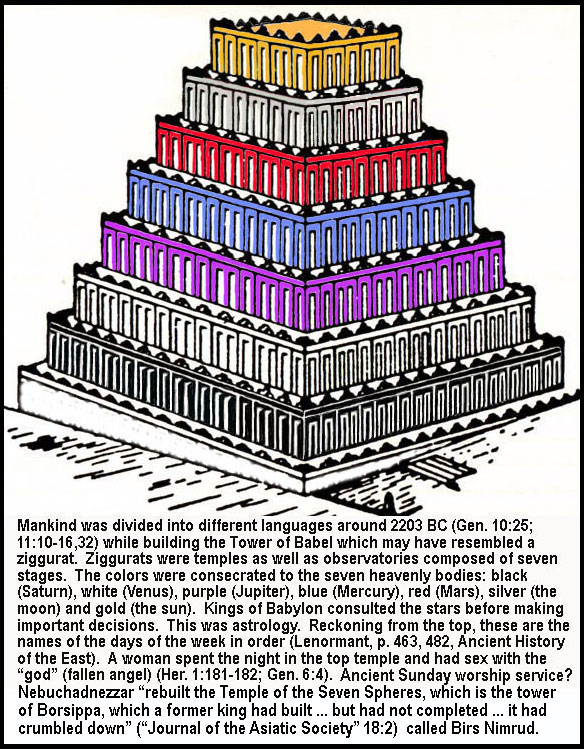
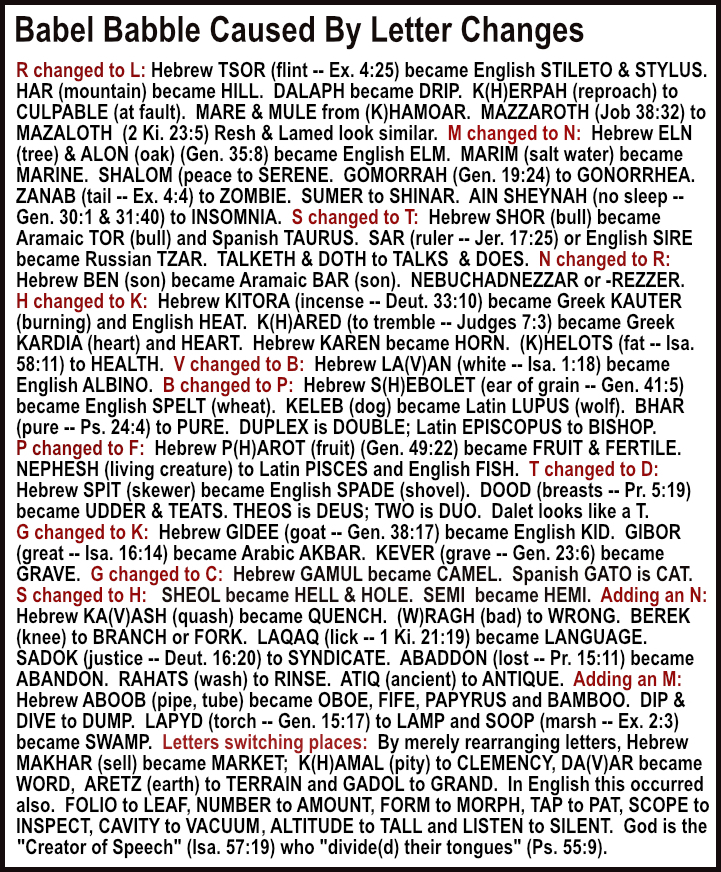
Cush Caused Chaos at the Tower of Babel -- He Bred Giants and Practised Cannibalism -- Resulting in Confusion of Tongues (c. 2203 BC)
Some Were Prevented From Articulating One Letter, Some Another; A Small Alteration Causing Words To Carry a Very Different Sense
No mention of Noah at Shinar indicates he went somewhere else. Otherwise Babylon would not have become so evil. The Chaldean account of Xisuthrus makes him disappear soon after coming forth from the ark. He may have settled in NW China as Fohi, their first king. But Xisuthrus's sons journeyed towards Babylonia or Sumer. According to the Sumerian King List, line 40, "After the flood had swept over, and the kingship descended from heaven, the kingship was in Kish." (named after Cush) After this well-known line, the section goes on to list 23 kings of Kish who ruled between 1500 and 300 years for a total of 24,510 years. The exact numer of years varies between copies. Belus or Evechous (Cush) was the first Chaldean (Babylonian or Assyrian) king after the deluge (Cory's Fragments pp.44,65,70-71; Syncellus, p.90). Saturn (Cronus or Cush) is said to have obtained the kingdom of Coelus or Ouranos (Noah's world empire), by the consent of his brother Titan (Shem or Set), on the condition that he did not bring up any more male children, and that, in order to conceal them, he DEVOURED them as soon as they were born. We know that it was the universal custom for the priests to EAT the sacrifices. "Are not they who EAT of the sacrifices partakers of the altar?" (1 Cor. 9:12-13; 10:18). In order to saftisfy his demon gods, and probably in obedience to their teaching, he offered his sons in sacrifice to them, and since he was the sacrificing priest, ATE the sacrifice thus offered. HUMAN SACRIFICE and CANNIBALISM originated with Cush (p.37, Sanchoniathon) and spread to the Phoenicians, Carthaginians, Hindus, Mexicans and Celtic nations. The author of Nimrod says, "The tyrant Zoroaster (Nimrod), of the line of Cham (Ham), was one of the founders of the Tower of Babel; he sacrificed innumerable victims to the demons" (Nimrod, vol.1, p.146). Therefore we find that the sacrifice of the FIRSTBORN to the Sun-god Osiris was one of the most notorious of the Egyptian rites (Transactions Victoria Institute, vol.14, p.113). Baal and Moloch were other titles for Nimrod. Moloch is where we get the word MOLESTER (Moloch in Celtic is Molestus). The Greek story of Saturn devouring his CHILDREN goes on to say that Rhea (Semiramis), the wife of Saturn (Cush), in order to save her CHILD, gave him a stone instead of Jupiter, when he was born. Jupiter, like Osiris, was the son of Saturn. Since babies were first killed, then burned, it was not difficult to deceive the father. She presented Cush with a stone bound in swaddling bands to represent a CHILD. (Hesiod Theogonia, lines 485, etc. pp.,38,41). When Shem discovered the birth of Nimrod, he made war against Nimrod and overpowered him (Lempriere, Titan). Cush lost his kingdom (Egypt) and escaped to Latium, Italy.
| "Titan (Shem) made Saturn (Cush) swear, Not to usurp Titan's lawful heir. No son to nourish which by reigning might Take the place of him who had the right." (Sibylla) |
"Saturn (Cush) descended from the heavens high, Fearing the arms of Jupiter (Nimrod) his son, His kingdom lost, and banished thence doth fly. Rude people on the mountain tops he won To live together, and by laws: which done, He chose to call it Latium." (Virgil) |
Ah wretched they that worship vanities, And consecrate dumb idols in their heart, Whom their own maker (God on high) despise, And fear the work of their own hands and art. What fury? What great madness doth beguile Men's minds? That man should ugly shapes adore, Of birds, or bulls, or dragons, or the vile Half-dog half-man on knees for aid implore. (Sedulius) |
The first two kings of the Egyptian monarchy, Menes "the Thebanite" (in south Egypt near Ethiopia) (Mizraim) and Athoth (Cush) began a dynasty of Theban kings (p.81, Sanchoniathon). Menes (Mizraim) was worshipped as a god called Meon (Nu. 32:38; 1 Chr. 5:8; Ez. 25:9; Jer. 48:23). Meon was the first king of Lydia and Phrygia (Diodorus; p.468, Sanchoniathon). Manes was the founder of the Lydian monarchy (Herodotus, p.45). Minos was the first king of Crete also. Every nine years he made king Aegeus pick seven young boys and seven young girls to be sent to the labyrinth to be EATEN by the Minotaur. Plutarch mentions a Phrygian hero named Manis. All these "Menes" were the same person (p.471, Sanchoniathon). who planted many colonies (p.79, Sanchoniathon). One of these colonies was therefore Lydia from the Ludim of Mizraim. Cush was also known as Belus, Hermes, Cronus, Seb, Saturn and Janus. Berosus calls the founder of the first dynasty of Chaldea Evechous (man of Cush -- p. 349, Lenormant). Nimrod was known as Ninus, Osiris, Tammuz, Bel Merodach, Marduk, Bacchus and Mars. According to Herodotus, "The priests said that Menes was the first king of Egypt" (Hist. 2:99). According to Syncellus, "The first king (of Egypt) was Mestraim, also known as Menes" (p.127, Chronography). Diodorus and Eupolemus also call Mizraim by the name Menes. Josephus calls the first Pharaoh, the founder of Memphis, Minaeus. The Turks call Memphis by the Hebrew name Mitzir rather than to the Greek Menephis (p.452, Sanchoniathon) (see also Herodotus 2:99). In Hebrew, M=600, I = 10, N=50, and V=6 in Hebrew. Minu = 666.
There is a passage of Eupolemus which states that Belus or Cronus (derived from the root Keren, a horn, his Phoenician title) was the father of Canaan, Misr, Cous (or Chum) and of another son (Praep. Evang. 9:17 p.419), who must have been Phut who succeeded to the Chaldean office with the title of Belus (or Baal meaning lord, his Chaldean title) after his father died. But Cronus (Ham) was the first Belus. Therefore both Ham and Phut were called Belus as a title. Wilkinson says that the different gods "take eachother's characters and attribues" (pp.9-10, Egyptians). Eusebius well says, "It must be confessed the ancient writers have very much confounded these ancient names with one another." In addition to titles of office used successively, this may be due partly to the custom among the ancients of speaking of all the direct descendants of an important person as his SONS. Also, the word BROTHER was anciently used to describe all parallel branches of a family. For instance Typhon (Shem) was called the BROTHER of Osiris (Nimrod) (Lempriere).
"For many ages men lived under the government of Jove (Jehovah) without cities and without laws, and all speaking one language. But after Mercury (Hermes means "son of Ham" -- Cush) interpreted (divided) the speeches of men, the same individual distributed the nations. Then discord began" (Hyginnius, p. 114). Thus the name of Cush became synonymous with "CONFUSION" -- Chaos. Proof that Cush was also known as Bel can be found in Jeremiah 1:2 where we read, "Bel is confounded" or "CONFUSION is CONFUSED." This father of the gods, also known as Janus, says, "The ancients called me CHAOS." (Ovid, Fasti book 1, verse 104; vol.3 p.19). "CHAOS is CHAOTIC" (Jer. 1:2). It was called BABEL because God did there BALAL (Heb. confound) the language of all the earth (Gen. 11:9). In the Syriac tongue, BALBEL means "to confound" and BOBLA or BABEL "confusion". "Through defect in the vocal organs, several letters were altered in original words: K for P; L for R; Z for Dh; B for D; T into B,L or N; D into R, L or N; S into L, R, T or N; L or M into N: besides labials, dentals and gutterals into their like." (p. 202, Primitive History From Creation to Cadmus by Williams)
Was Sanchoniathon a counterfeit? Philo Byblius, Porphyry and Eusebius, who were better able to judge than any modern scholar, never called into question his being genuine. Sanchoniathon was the transcriber of the Cosmology of Taautus or Thoth (Cush), who was (second) King of Egypt, and began his Cosmology with a "dark" "chaos" and a "watery mixture" (Gen. 1:2) of "mud" . The "waters" were "separated" (Gen. 1:6), plants and animals were formed, and humans began to worship plants; and to worship the sun, moon and stars. Other fallible humans were also worshipped; and even demons (1 Cor. 10:20). No credit is given to a Creator God. No mention of a Creator God (Rom. 1:28). This is Cain's line of heathen worship, not Seth's line of true religion. Atheism was thereby instilled by Cush. Phoenicians and Egyptians therefore "worshipped the creature rather than the Creator" (Rom. 1:19). Two mortals called "Protogonus ["First begotten"] and Aeon" (Adam & Eve) were formed by the Wind and his wife Baau [the "bohu" of Moses meaning "Chaos"] (Gen. 2:7) and "Aeon (Eve) found out the way of taking food from trees" (Gen. 3:6). No acknowledgment of her sin. Then in the second generation, Genus [meaning "Generate" or "Gain"] and Genea (Cain & his wife) lived. Eve said, "I have gotten a man, the Lord" so "Cain" meant "Get" or "Gain". [G easily changes to C as a grammatical rule; Greek suffix "us" added]. They worshipped the "Sun" (Gen. 4:16; Deut. 4:19) as Baal-Samen (Lord of Heaven). Their children in the third generation were called "Light, Fire, and Flame" (Enoch) since they "found out the way of generating fire by rubbing two sticks of wood together". In the fourth generation, their sons were giants (Cassius, Libanus, Antilibanus and Brathys) (Gen. 6:4). The fifth generation consisted of "women ... who, without shame, lay with any man they could light upon" (Gen. 6:5,12). The next generation of sons was called "Agreus and Halieus who invented the arts of hunting and fishing". In the seventh generation, two brothers were begotten who invented iron and forged iron. One was called Chrysor or Hephaestus (Greek) or Vulcan (Latin) [who was worshipped as a god after his death] (which corresponds to Moses' eighth generation where he mentions Tubal-Cain [Vulcan] -- Gen. 4:22). This close agreement, but not exact agreement, may be explained by the fact that the father often begins in his generation what his son brings to perfection in the next generation. Therefore Moses took notice of the son, while Cush took notice of the father. Both agree that metallurgy was invented by Cain's line. In the eighth generation, two brothers called Technites (the artist) and Geinus Autochthon "found out to mingle stubble, or small twigs, with the bricky earth, and to dry them by the sun and to make tiling". (Cain's line has eight generation till the Flood) In the ninth generation were begotten Agrus (Field) and Agrotes (Husbandman) (Noah the "husbandman" -- Gen. 9:20) who "owned" a much-worshipped statue, and a temple carried about by one or more yoke of oxen in Phoenicia (Noah was venerated by the Phoenicians as the greatest of the gods -- probably portrayed with two faces, one looking into the old world and the other into the new, like the Roman god Janus -- Euseb. Prep. Evang. 1:10 -- who was associated with a ship -- Quaest. Rom. p. 274; and who derived his name Janus from "jain" or "wine" -- Berosus Ant. 3:25.). They are also called Titans (Ham-Cronus-Vishnu, Shem-Typhon-Brahma & Japheth-Jupiter-Siva). In the tenth generation, Amynus and Magus showed men how to constitute villages and flocks. "Amun" (Ham -- 2:10) being associated with "Magus" (magicians -- 2:10) (see Ex. 7:11; see Pseudo-Clemens). He says their son was "Misor" -- (Mizraim or Egyptians -- Gen. 10:6). Sanchoniathon then explains that the son of Misor was "Taautus" whom "the Egyptians called Thoor, the Alexandrians Thoyth, and the Greeks Hermes" (3:1) (Mercury). The Bible calls him Cush. He was actually Mizraim's brother but successor in government. Sanchoniathon says Thoth or Hermes (Cush) "was the first who took religion out of the hands of the ignorant vulgar, and moulded it into a rational system" (corrupted the true patriarchal religion)(Sanchoniathon in Cory's Fragments, p.21). No mention by Cush of the worldwide Flood that destroyed sinful men. In the eleventh generation came Misor (Mizraim) and Sydyc (Noah himself since he was "just" or "sadik" [Gen. 6:9] and in Seth's eleventh generation). These found out the use of salt. In the twelfth generation "from Misor (Mizraim) came Taautus (Cush), who found out the writing of the first letters, whom the Egyptians called Thoor, the Alexandrians Thoyth, and the Greeks Hermes". "Ouranus ... married his sister Ge, and had by her" a son "called Cronus". With the help of Hermes (Cush), Cronus (Ham) fought against his father Ouranos (Noah) "and drove him out of his kingdom, and succeeded in the imperial power or office". The concubine of Ouranos (Noah) was taken by Cronus (Ham) and given in marriage to Dagon (Cush). Then Cronus (Ham) founded Byblus "the first city in Phoenicia". Then Cronus (Ham) "cut off" Noah's "privities" (castrated Ouranus) (Gen. 9:21-27). Cronus (Ham) "gave all Egypt to the god Taautus (Cush), that it should be his kingdom". Since Cronus (the elder -- Noah) is the same person as Sydyk ("the Just" -- Noah), the seven children of Cronus called Titans are the same as the seven children of Sydyc called Cabiri. They are the seven members of the ark besides Noah himself. They are said to have built the first ship that was ever navigated. Pherecydes has preserved a tradition of the Cabiri, which exactly agrees with the scriptural account. According to this writer, Vulcan (that is Noah worshipped in conjunction with the solar fire) espoused Cabira, the daughter of the marine deity Proteus, and by her became the father of the three Cabiri, and the three Cabirae. Pherec. apud Strab. Geog. lib. x. p. 472. According to the author of the works ascribed to Orpheus, the names of the seven arkite Titans were Ceus, Creus, Phorcys, Cronus, Oceanus, Hyperion, and Iapetus. (Orph. apud Proc. in Tim. lib. .v. p. 295.) The seven Titans besides Cronus or seven Cabiri besides Sydyc are also the same as the seven Rishis of the Hindoo mythology, who are said to have escaped in a boat along with Menu the head of their family (Asiat. Res. vol. v. p. 246). They are the eight Egyptian primordial deities worshiped in Hermopolis (the ogdoad) in Egyptian mythology. The Cabiri were also worshipped under various other names such as Dioscori, Corybantes, Curetes, Idei, Dactyli, Anactes, and Telchines. Sanchoniatho himself ascribes to them the two first of these names; and he is corroborated by the testimony of Strabo (Geog. lib. x. p. 472.), and Clemens Alexandrinus (Clem. Alex. Cohort, ad Gent. p. 16.). Julius Firmicus, speaking of the murder of one of the Corybantes by his two brethren, asserts, that he was a Cabirus (Jul. Firm, de Error. Prof. Rel. p. 23); and Suidas says that the term Curetes was only another name of the Corybantes (Suid. Lex. Vox. --They were reckoned the guards of Jupiter, and like the Titans, were the children of Rhea) Pausanias informs us, that the inhabitants of Amphissa in Phocis celebrated mysteries in honour of the Anactes, who were supposed to be the Dioscori, the Curetes, or the Cabiri (Phoc. p. 896). Aratus declares the Curetes, the Corybantes, and the Idei Dactyli, to be the same (Schol. in Arat. Phoen. p. 9); and Nonnus joins together the Corybantes, the Cabiri, the Idei Dactyli, and the Telchines.This is a brief summary of Sanchoniathon's Cosmology of Taautus, pp.1-39.
"There were FALLEN ONES in the earth in those days (before the Flood), and also after that (after the Flood), when the sons of God (the FALLEN ANGELS) came in unto the daughters of men (temple priestesses) and they bare children to them; the same became mighty men which were of old, men of renown" (Gen. 6:4). How did this happen? Is there any secular historical confirmation? According to Herodotus, on top of the tower of Belus at Babylon was the temple of Belus (Cush) in which was "a handsome couch and table of gold." "No mortal" he says, "passes the night there, except one woman chosen by the god (FALLEN ANGEL) out of the whole nation. He adds that the priests "assert that the god (FALLEN ANGEL) himself comes to the temple and reclines on the bed in the same manner as the Egyptians say happens at the temple of Thebes in Egypt, for there also a woman lies in the temple of the Theban Jupiter, and both are said to have no intercourse with men." So also he says that the priestess of the oracle at Paterae in Lycia is "shut up during the night in the temple with the god." (FALLEN ANGEL) (Herodotus 1:181-182). The purpose of these tower temples may have been to BREED nephilim GIANTS -- "greater in power and might" (2 Pet. 2:11). "The angels which kept not their first estate, but left their own habitation, he hath reserved in everlasting chains under darkness unto the judgment of the great day" (Jude 6). They "went after strange flesh" (Jude 6). Greek "mythology" is full of accounts of affairs between gods and mortals. Babel originally meant "Gate of God." Pausanius mentions in his Attics finding men's bones in Milesia that were 15 feet long. Anciently Milesia was called Anactoria after the Anakim (p.477-478, Sanchoniathon). Noah and his immediate descendants were referred to as TITANS meaning "EARTH-BORN" ("white clay men" -- Greek Titanos) probably in contempt and to contrast them with the Nephilim "HEAVEN-BORN." TITAN (Celtic) for TIT (earth) and DEN (man) hence the Greeks very properly also called them "terriginae" or "EARTH BORN". According to Josephus' Antiquities book 18:3:4: "There was at Rome a woman whose name was Paulina ... of a beautiful countenance ... of great modesty. She was married (but) ... Decius Mundus (not her husband) fell in love with this woman ... he was not able to bear ... Paulina's sad refusal ... (and resolved) to kill himself ... (But instead he bribed the) Isis's priests (one of whom) ... went immediately to Paulina and ... told her that he was sent by the god Anubis, who was fallen in love with her, and enjoined her to come to him. Upon this she took the message very kindly ... and told her husband that she ... was to ... lie with Anubis; so he agreed to her acceptance of the offer ... she went to the temple ... the priest shut the doors of the temple; when in the holy part of it, the lights were also put out. Then did Mundus leap out (for he was hidden therein) ... (she supposed) ... he was the god ... when he was gone ... Paulina came early to her husband ... on the third day after what had been done, Mundus met Paulina, and said ...'I took to myself the name of Anubis' ... Tiberius ... ordered (the priests) ... to be crucified ... demolished the temple of Isis (at Rome)... (and) banished Mundus."
The resulting CONFUSION produced certain strange races of GIANTS in Palestine, the Rephaim, Enim, Anakium and Zuzim. They were not Canaanites, as there is no mention of them in the geneologies in Genesis 10:15-19. They were the result of intercourse between fallen angels and women of Canaan. They were irredeemably evil since "the man that wanders out of the way of understanding shall remain in the congregation of the Rephaim" (Pr. 21:16) and the woman "which forsaketh the guide of her youth and forgetteth the covenant of her God, inclineth to the Rephaim" (Pr. 2:17-18). Spiritually dead. "The Rephaim shall not rise" (Isa. 26:14). The KJV doesn't do justice to these verses. Look in a Hebrew-English Interlinear.
HUMAN SACRIFICES were offered to Baal and the word "CANNIBAL" is derived from Cahna Bal -- the priest of Bel (Cush). Cush was the originator of HUMAN SACRIFICES. Belus (Cush) was the first king of Babylon and Assyria (Cory's Fragments, pp. 65, 70-71). "The tyrant Zoroaster, of the line of Cham (Ham), was one of the founders of the Tower of Babel; he sacrificed innumerable VICTIMS to the demons" (Nimrod vol.1, p.146). "It was the custom among the ancients in time of great calamity, in order to prevent the ruin of all, for the rulers of the city, or nation, to SACRIFICE to the avenging deities the most beloved of their CHILDREN as the price of redemption" (Sanchoniathon, from Porphyry, Cory, Fragments pp. 16-17). Aristomenes sacrificed 300, one of whom was the Spartan king, to Jupiter. The Carthaginians, when defeated by Agathocles, offered 200 youths to Saturn. 20,000 human victims annually polluted the altars of Mexico. Elian records a happy mother's joy at sight of a divine crocodile devouring her honored child. The Druids offered several human victims inclosed together in a vast statue composed of wicker.
| Secular History Confirms the Tower of Babel Confusion of Tongues (c. 2203 BC) |
The Book of Jubilees (dating from the second century BC) says: “And they built it [Babel]: forty and three years ... were they building it” (Charles 1913, 10: p.21) then the Dispersion occurred. In the Irish Book of Invasions, construction of the Tower of Babel is mentioned, then after 42 years, Ninus came to rule the world (Macalister 1941, §13). This independently confirms the 43 years of the Book of Jubilees and also confirms that Ninus started his reign as the only king immediately after the Dispersion. The Russian Primary Chronicle says, “Thus they gathered together in the plain of Shinar to build the tower and the city of Babylon round about it. But they wrought upon the tower for forty years, and it was unfinished” (Cross and Sherbowitz-Wetzor 1953, p.52). Nebuchadnezzar left a dedicatory inscription in Borsippa which “is now certainly identified with the Temple of Nebo at Borsippa.... This temple of the ‘Seven Lights of the Earth’ was rebuilt by Nebuchadnezzar” (“Historic Errors and Doubts: How They Originate, and How They Are Perpetuated” by Jeffery 1869, p. 116) “The dedicatory inscription of that king [Nebuchadnezzar], lately discovered among the ruins, contains the following passage, as deciphered by Oppert: ‘A former king built it, they reckon forty-two ages, but he did not complete its head.... Since a remote time” (Jeffery 1869, pp. 116-117). The 42 years or ages to build probably refer to the Tower of Babel since it was not completed and was most ancient (Empires of the Bible by Jones 2004, p.3).
Many nations have accounts of the "Tower of Babel." Although they don't always agree in minor details, they do agree in major themes. The tower is linked in most accounts with the dividing of mankind into different languages. The similarity of these legends and traditions indicates an ancient common shared experience. Notice some of these tower stories from sources outside of the Bible:
The Sumerian Account
The entire Sumerian account and a discussion of it can be found in the article “The ‘Babel of Tongues’: A Sumerian Version,” Journal of American Oriental Society 88 (1968, pages 108-11) :
In those days, the lands Subur (and) Hamazi, Harmony-tongues (?) Sumer,. . .Uri,... The land of Martu, ... The whole universe, the people in unison spoke, To Enlil in one tongue ... Then ... Enki, the lord of abundance, (whose) commands are trustworthy, The lord of wisdom, who understands the land, The leader of the gods, Endowed with wisdom, the 1 (ord) of Eridu, Changed the speech in their mouths, set up contention into it, Into the speech of man that (until then) had been one
Yes, people in unison spoke one tongue until the Lord of Wisdom changed the speech and created contention.
The Assyrian Account
George Smith, well-known Assyriologist and explorer for the British Museum in the last century, translated an Assyrian inscription in 1875. This document had some fragments missing but gave an unmistakable account:
...His heart was evil ...against the father of all the gods was wicked ... of him his heart was evil ... Babylon brought to subjection, (small) and great he confounded their speech. Their strong place (tower) all the day they founded; to their strong place in the night entirely he made an end ... Bitterly they wept at Babi- ... very much they grieved ... [The Cbaldean Account of Genesis, pp. 160-1621].
He counfounded their speech at Babylon. Notice the partial word Babi-, due to a fragmented text. Professor Smith felt there was only one word it could be: Babil or Babel! So the Assyrians talked of a “confusion of tongues” as the Sumerians did. Work on a “strong place” or tower is made to end.
The Greek Accounts
Plato mentions that at one time all men had one speech but were confused and scattered when they sought immortality. The Titans of Greek mythology tried to ascend to heaven and fight against the gods but were overthrown. Yes these are garbled accounts. But the Babel tradition is still there. A better account is found in Josephus who mentions the record of the Sibyl:
When all men were of one language, some of them built a high tower, as if they would thereby ascend up to heaven, but the gods sent storms of wind and overthrew the tower, and gave everyone his peculiar language; and for this reason it was called Babylon. [Antiquities, 1, 4, 3. He further cites Hestiaeus’ mention of certain priests going to Shinar after the flood.]
Eusebius in the Praeparatio Euangelica quotes ancient authorities extant in his time. He gives Abydenus’ account contained in the work Of Assyrian History:
But there are some who say that the men who first arose out of the earth, being puffed up by their strength and great stature, and proudly thinking that they were better than the gods, raised a huge tower, where Babylon now stands: and when they were already nearer to heaven, the winds came to the help of the gods, and overthrew their saucture upon them, the ruins of which were called Babylon. And being up to that time of one tongue; and afterwards war arose between Cronos (Saturn) and Titan
(416b-c).
Eusebius goes on to quote from Alexander Polyhistor’s Of the Jews:
Eupolemus in his book Concerning the Jews of Assyria says that the city Babylon was first founded by those who escaped from the Deluge; and that they were giants, and built the tower renowned in history. But when this had been overthrown by the act of God, the giants were dispersed over the whole earth (418c).
The Tower of Babel was overthrown causing dispersion.
The Mexican Accounts
A native Cholula gave the following account, which first appeared in Duran’s Historia Antigua de la Nueva Esputia (1585 A.D.) .
In the beginning ... all was a plain ... and immediately after the light and the sun arose in the east there appeared gigantic men of deformed stature and possessed the land.. . they determined to build a tower so high that its summit should reach the sky. Having collected materials for the purpose, they found a very adhesive clay and bitumen, with which they speedily commenced to build the tower; and having reared it to the greatest possible altitude, so that they say it reached to the sky, the Lord of the Heavens, enraged, said to the inhabitants of the sky, “Have you observed how they of the earth have built a high and haughty tower ...? Come and confound them. ...” Immediately the inhabitants of the sky sallied forth like flashes of lightning; they destroyed the edifice and divided and scattered its builders to all parts of the earth.
A further account is given by the native Mexican historian Ixtlilxochitl, from the legend of the Toltecs:
...after men had multiplied [after the flood], they erected a very high “zaculai,” which is today a tower of great height, in order to take refuge in it should the second world (age) be destroyed. Presently their languages were confused, and not being able to understand each other, they went to different parts of the earth. The Toltecs, consisting of seven friends, with their wives, who understood the same language, came to these parts, having first passed great land and seas, having lived in caves, and having endured great hardships in order to reach this land; they wandered 104 years through different parts of the world before they reached Hue Hue Tlapalan, which was in Ce Tecpatl, 520 years after the Flood.
The Toltec account agrees with the Biblical account, even though given from an entirely different perspective and obviously independent. The reason for the agreement lies in the fact that the Toltecs came almost immediately to Mexico and thereby maintained an accurate record of the original eyewitness account.
"According to the ancient traditions collected by Bishop Francis Nunez de la Vega, the Wodan of the Chiapenese (Mexicans) was the grandson of that illustrious old man, who, at the time of the Great Deluge in which the greater part of the human race perished, was saved on a raft together with his family. Wodan co-operated in the construction of the great edifice which had been undertaken by men to reach the skies; the execution of this rash project was interrupted; each family received from that time a different language; and the great spirit Teotl ordered Wodan to go and people the country of Anahuac (Mexico)" (Humbolts Mexican Researches, vol.1, p.320).
Similar traditions are found among the Chinese, the Hindus, the Persians, the Romans, the Irish, and even the Estonians. In his 1918 book, Folklore in the Old Testament, Scottish social anthropologist Sir James George Frazer documented similarities between Old Testament stories, such as the Flood, and Tower of Babel and indigenous legends around the world. He found in Lozi mythology that wicked men built a tower of masts to pursue the Creator-God, Nyambe, who has fled to Heaven on a spider-web, but the men perish when the masts collapsed. He further related similar tales of the Ashanti that substitute a pile of porridge pestles for the masts. Frazer moreover cited such legends found among the Kongo people, as well as in Tanzania, where the men stacked poles or trees in a failed attempt to reach the moon. He further cited the Karbi and Kuki people of Assam as having a similar story. The traditions of the Karen people of Myanmar, which Frazer considered to show clear 'Abrahamic' influence, also relate that their ancestors migrated there following the abandonment of a great pagoda in the land of the Karenni 30 generations from Adam, when the languages were confused and the Karen separated from the Karenni. He notes yet another version current in the Admiralty Islands, where mankind's languages are confused following a failed attempt to build houses reaching to heaven.
The reason for the similarity of the stories is a shared experience -- the Tower of Babel. The differences are because each nation has preserved details particularly relevant to its own national interests, which other mations may have regarded as unimportant. The closer to the site of the actual event the nation or people were, or the more civilized the nation which kept the account, the more like the Genesis account it is !
In any case, there are at least three major points on which all accounts are remarkably similar:
1) All humans originally spoke only one language which was understood by all.
2 ) A tower was built contrary to God’s will and was never completed. The bulk of mankind participated in that building.
3) God generated many different, unrelated languages at one time.
Why did God stop construction? Probably in order to prevent the people from advancing too swiftly and reaching the brink of cosmocide prematurely. God confounded and divided the people by linguistic, racial and geographical means. Evidence for the Tower of Babel is found in historical records around the world.

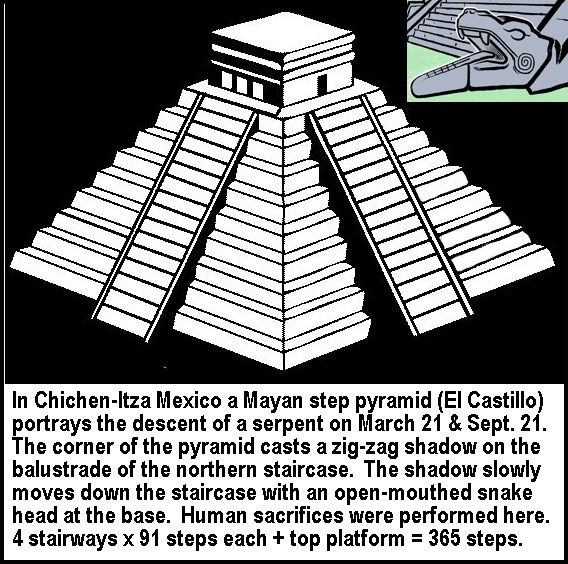
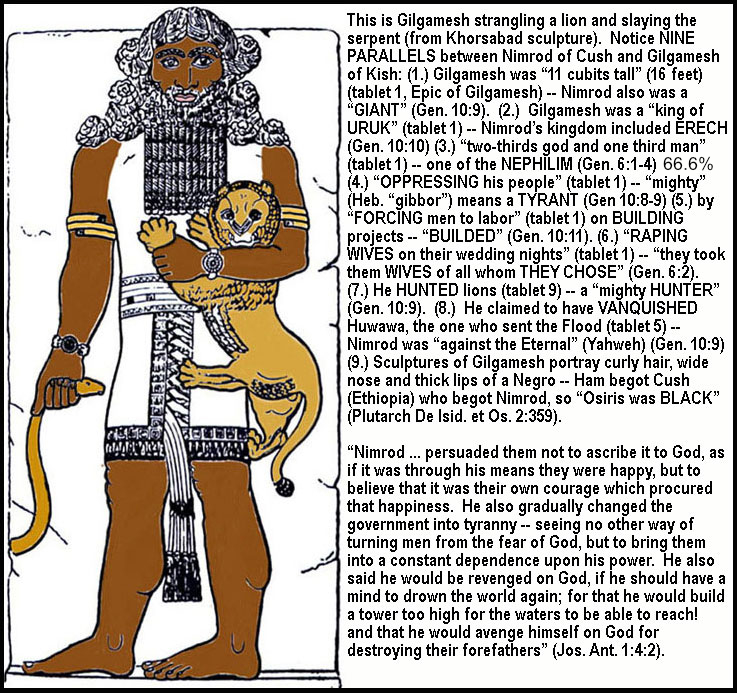
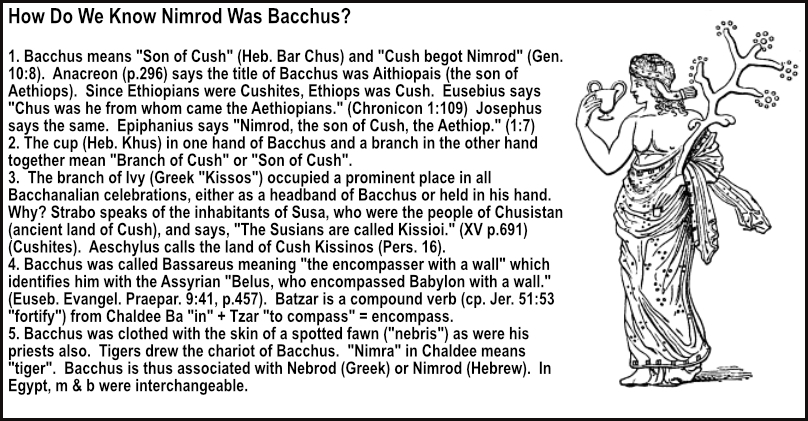
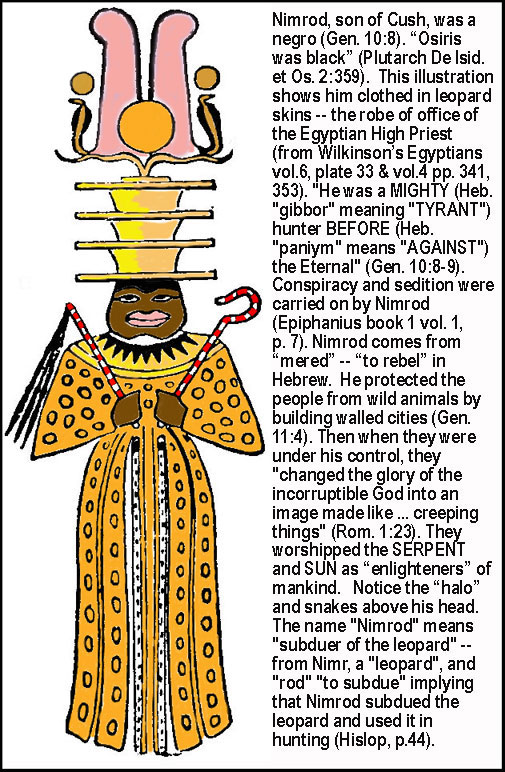
Nimrod (En Marduk) Built Babel in 2233 BC -- He Was A Black Ethiopian Giant and A Tyrant Who Rebelled Against God and Taught Integration (Gen. 11:6)
Varro reckons the interval between the Flood (2304 BC) and the first Olympiad (776 BC) to be about 1600 years (p.84, Sanchoniathon). Josephus also says that "more than one thousand three hundred years" elapsed from Menes (Mizraim) until Solomon (Ant. 8:6:2). If Solomon was born in 990 BC, then 1300 years before that, brings us to 2290 BC. and Misraim reigned 62 years making Cush's accession about 2228 BC. More precisely, several independent methods of reckoning place the beginning of Cush's reign at 2234-2233 B.C. (Garnier's Worship of the Dead, pp. 280-285; see also Pliny NH 7:56 and Rawlinson's Herodotus vol. 1, essay 6, pp.434-435). Simplicius and Porphyry both relate that Callisthenes, a relation and disciple of Aristotle, who accompanied Alexander the Great on his eastern expedition, was told by the priests of the temple of Belus in Babylon, that they had preserved a series of Chaldean astronomical calculations, which extended over a space of 1903 years before that time. Alexander conquered Babylon in 330 BC. Adding 1903 years, these records therefore must have begun 2233 BC. Pliny, Book 7, Ch. 56 states that Epigenes (quoting from Berossus) taught that among the Babylonians observations about the movements of the stars have been preserved on baked clay tablets for 720,000 years (which is 200 saroses or 200 decades of 360-day years). So 3600 days x 200 = 720,000 days divided by 365.25 = 1971 Julian years. Adding 1,971 Julian years from the accession of Theos in 262 BC (since Berossus dedicated his writings to Antiochus Theos [Ussher 2003, 364, §2826]) takes us back to 2233 BC. Also from Ninyas (son of Nimrod and Semiramus) to Sardanapalus, the Assyrian Empire continued 1360 years (Diodorus Siculus 2:77). Since Sardanapalus died in 747 BC, that would place Ninyas reign at 2107 BC.
There were in fact two Assyrian Empires: Ninyas to Sardanapalus was the first. It was divided between Arbaces of Media and Belesis of Babylon; and from then till the destruction of Nineveh by Nabopolassar was the second. Diodorus Siculus 1:29 says that after the time of Menes (Mizraim) 52 kings reigned a space of over 1400 years (actually 1370 years from Menes to Sesostris according to Sir John Marsham's tables of the Theban Kings) where nothing historically noteworthy occurred. That time period ended with Sesostris or Shishak raiding Jerusalem (2 Chr. 12:9) in the fifth year of Rehoboam (926 BC) since Diodorus says Sesostris performed the most illustrious actions, far exceeding all before him (1:34). For Herodotus says "the other kings, they gave no account of their deeds, nor ... were in any degree of renown, except one, the last of them, Moeris" (2:100-104) -- who constructed a lake. Moeris was the immediate predecessor of Sesostris. Then Herodotus talks in detail about the conquests of Sesostris. Josephus agrees that Sesostris was Shishak (Antiq. 8:4 p.368).
Syncellus (and Ctesias -- 400 BC) says the reign of Ninus (Nimrod) was 52 years in Babylon. Manetho gives Athothes (Cush) a reign of 57 years, and Eratosthenes gives Athothes (Cush) a reign of 59 years in Egypt. If we subtract 57 years from 2234 BC we get 2177 BC for the end of Cush's reign and the accession of Shem as Shepherd king in Egypt. Scaliger, speaking of the Babylonian kings, says that "Belus (Cush) reigned sixty-two years, Ninus (Nimrod) fifty-two years, and Semiramis, called Rhea, on account of her manifold atrocities, forty-two years" (Cory, Fragments, p.76). In accordance with this, we find in the list of Egyptian kings, that both Manetho and Eratosthenes give Menes (Mizraim), like Belus (Cush), a reign of sixty-two years, and Athothes (Cush), is given a reign of fifty-seven years by Manetho and fifty-nine years by Eratosthenes (Egyptian Dynasties, Cory, pp.84,94). In Babylon, Semiramis was slain, in the forty-second year of her reign, by her son, for courting him in her embraces (Justin 1:1-2).
Combine the prefix EN (meaning "king" in Babylonian) with the Semitic root "marah" (MR) in Hebrew which means BITTERNESS as well as DISOBEDIENCE. From this root is derived "marad" (MRD), or REBELLION, which is the origin of the Israelite slang term Nimrod ("rebellious king")(the Babylonian Nin-Mir-Rud), or (NMRD). They were insulting King Marduk/Merodach (EN MRDK). In Egypt, where the Septuagint was translated, "m" and "b" were often interchangeable (Bunsen, 1:449), and Nimrod would thus become NIBROD or NEBROD in Egypt, and the Greeks no doubt adopted the name from the Egyptians (Hislop, p.47 note). The Septuagint calls him NEBROD. Sir Henry Rawlinson remarks in confirmation of this that Babylon, is called in the inscriptions "The City of Bilu NIPRU" and Arab tradition calls Babylon NIFFER (See Rawlinson's Herodotus 1:596-598). The original meaning was probably "the Subduer of the Leopard" from NIMR (leopard) and RAD (subdue). The name by which Mars was known by the Oscans of Italy was "Mamers," which signifies "the REBEL"; and the name of the Babylonian god "Bel Merodach" appears to have the same meaning -- "Bel the REBEL."
"Out of that land he (Nimrod) went forth into Assyria (or being made strong) and builded Nineveh" (Gen. 10:11). Dicearchus in Stephanus says that "Babylon was built by the fourteenth king after Ninus the founder of Nineve." Dicearchus shews that Nimrod was the primitive Ninus; since he calls the founder of Nineveh by that name. Nimrod (or En Marduk) conquered all nations as far as Libya (Bryant, Mythology vol.2, p.377). This means that Egypt was included since it was between Babylon and Libya. Nimrod protected the Sumerians (Miller's Ancient History in Bible Light, p.51) from wild animals by building walled cities (Gen. 11:4). One such city was NINEVEH meaning "the habitation of NIN" (Gen. 10:11). "Ninus is Nimrod" (Appollodoros, Fragments 68). Diodorus, Pompeius and Berosus also confirm that the biblical Nimrod was Ninus, the first of the kings of Assyria (Babylon included). Aemilius Sura, via Velleius Paterculus, states that Ninus founded Assyria 1,995 years before Rome conquered Philip, King of Macedonia, which occurred in 197 BC (Shipley 1924, 15). This gives the date for the founding of Assyria as 2192 BC with an error of six months. In the Jerusalem Targum it is said, "he was a hunter of the children of men in their languages, and he said unto them, Depart from the religion of Shem, and cleave unto the institutes of Nimrod."
Josephus says, "Now it was Nimrod who excited them to such an AFFRONT and CONTEMPT of God. He was the grandson of Ham, the son of Noah, -- a bold man, and of great strength of hand. He persuaded them not to ascribe it to God, as if it was through his means they were happy, but to believe that it was their own courage which procured that happiness. He also gradually changed the government into TYRANNY, -- seeing no other way of turning men from the fear of God, but to bring them into a CONSTANT DEPENDENCE upon his power. He also said he would be REVENGED on God, if he should have a mind to drown the world again; for that he would BUILD a tower too high for the waters to be able to reach! and that he would AVENGE himself on God for destroying their forefathers!" (Ant. 1:4:2). Nimrod taught INTEGRATION of the races whereas God wanted SEGREGATION of the races.
Notice NINE PARALLELS between Nimrod and Gilgamesh. (1.) Gilgamesh was "11 cubits tall" (16 feet) (tablet 1) -- Nimrod was a "GIANT" (Gen. 10:9 Septuagint), (2.) Gilgamesh was a "king of URUK" (tablet 1); Nimrod of Erech (Gen. 10:10), (3.) Gilgamesh "two-thirds god and one third man" (tablet 1); Nimrod was one of the NEPHILIM -- Gen. 6:1-4 -- 66.6%. (4.) Gilgamesh was "OPPRESSING his people" (tablet 1) while Nimrod was a tyrant -- Gen. 10:8-9 (5.) by "FORCING men to labor" (tablet 1) on BUILDING projects; Nimrod also "builded" -- Gen. 10:11 (6.) Gilgamesh engaged in "RAPING WIVES on their wedding nights" (tablet 1) while the nephilim (including Nimrod) "they took them wives of all whom they chose" -- Gen. 6:2. (7.) Gilgamesh HUNTED lions (tablet 9) while Nimrod was a "mighty hunter" (Gen. 10:9), and (8.) Gilgamesh claimed to have VANQUISHED the one who sent the Flood (tablet 5) according to the Epic of Gilgamesh. Nimrod was "against the Eternal" (10:9). (9.) Sculptures of Gilgamesh portray curly hair, wide nose and thick lips of a Negro. Ham begot Cush (Ethiopia) who begot Nimrod, so "Osiris was black" (Plutarch, De Isid. et Osir. 2:359).
Ninus and Semiramis were the first rulers of the Babylonian Empire (Cory's Fragments p.66). "Ninus is Nimrod" (Appollodoros, Fragments 68). "The wife of Ninus and his successor in the kingdom was Semiramis" (p.431, Eusebius, Prep. For Gospel). He became the HUSBAND of his MOTHER (Bunsen's Egypt vol.1, pp.438-439; Rawlinson's Herodotus vol.1 essay 10, pp. 625,626). Semiramis was first the wife of the Syrian (Assyrian) chief Oannes (aka Dagon) from whom Ninus took her (Diodorus Siculus Bibliotheca 2:6). Oannes was probably Nimrod's own father, Cush, from whom he took her. The story agrees exactly with the Grecian myth of Vulcan, Venus and Mars where Venus was first the wife of Vulcan (ie Cush), and was taken from him by Mars (ie Nimrod). According to another tradition, he dethroned Djemschid (Cush) and married his sister (p.76, Worship of the Dead). "Cush begat Nimrod" (Gen. 10:8). If both Cush and Nimrod married a Nephilim-born woman, this perhaps would account for the fact that Djemschid, who married the daughter of a demon, is in the traditions, seemingly identified with both father and son. If so, Semiramis may have been the mother, as well as the wife, of Nimrod, which would account for his gigantic strength being of Nephilim descent, as well as make him in fact "the son and husband of the mother" (an often repeated statement of mythology regarding the various gods under whose names he was deified). Furthermore, is it possible that Semiramis was the daughter of Naamah by a Nephilim father? Or that Naamah was the mother of Cush, from whom he obtained his occult knowledge of pre-flood magic? Does "Anobrot" ("heavenly mortal" -- Sanchoniathon) imply daughter of a Nephilim father? Persians say he (Ghemschid - Nimrod) married the daughter of a demon implying Semiramis had a Nephilim father, and that from this marriage sprang "the BLACK and IMPIOUS RACE" (Smith's Dict. of the Bible, "Giants"). Is the Ethiopian race black due to Nephilim parentage, as stated by Persian tradition? Ghemschid is stated to be the fourth king of Iran, and ancient Iran extended from the Caucasus to the Indus, including the valley of Shinar (empire of Nimrod), who was fourth from Noah. The Persian account says that the father of Ghemschid founded the cities of Babylon and Nineveh, which agrees with the records of the dynasties of the Assyrian Empire. These nearly always place Belus or Cush as as the first king, and Ninus or Nimrod as succeeding him. The Zendavesta says that "Ghemschid, that wonderful king of Iran, built a place of enormous extent in the form of a square, and within it was a tower or castle and also a conspicuous palace." (tom. 2 p.275). This is clearly Babylon so Ghemschid is Nimrod.
Egyptian tradition shows that their god Osiris was BLACK (Plutarch's De Isid, et. Os. vol.2, p.359), not reddish like the Misraim population generally. He was clothed in LEOPARD skin (Bunsen vol. 1, p.425). The name "Nimrod" means "subduer of the LEOPARD " -- from Nimr, a "LEOPARD", and "rod" "to subdue." This name seems to imply that Nimrod subdued the LEOPARD and used it in hunting (Hislop, p.44). In India hunting with leopards has been a custom (Wilkinson vol.3, p. 171). Persian legends show that Hosang (Cush) the father of Tahmurs (Nimrod) who built Babylon, was the "first who bred dogs and leopards for hunting" (Sir William Jones' Works vol.4, pp. 341,353). The Egyptian high priest's robe of office was the LEOPARD'S skin. Nimrod, by the same spotted covering, is identified as being the Greek god Bacchus (Bar = son + Chus = Son of Cush). Leopards were employed to draw Bacchus' chariot. He was represented as attired in leopard skins and his priests were attired in the same manner or with the spotted skin of a fawn. This latter seems to have come from Assyria (Vaux's Nineveh, ch. 8, p.233).
Diodorus Siculus said, the rites of the Egyptian Osiris and the Grecian Bacchus are the same, and those of the Egyptian Isis (Semiramis) and Greek Ceres (Semiramis) exactly resemble each other (Bibliotheca book 1 p.9). Nimrod instigated the discord and the apostasy after the Flood. "He was a MIGHTY (Heb. "gibbor" meaning "TYRANT" or "GIANT") hunter BEFORE (Heb. "paniym" means "AGAINST") the Eternal" (Gen. 10:8-9). Nimrod was AGAINST God. The Septuagint calls him a GIANT. Conspiracy and sedition were carried on by Nimrod (Epiphanius book 1 vol. 1, p. 7). He was a "hunter" of men's souls (cp. Jer. 16:16).
Diodorus Siculus says, "Ninus, the first of the Assyrian kings mentioned in history, performed great actions. Being naturally of a warlike disposition, and ambitious of glory that results from valour, he armed a considerable number of young men that were brave and vigorous like himself, trained them up a long time in laborious exercises and hardships and by that means accustomed them to bear the fatigues of war and to face dangers with intrepidity" (Diodorus, Bibl. vol.2, p.63). Trogus Pompeius says, "Ninus, king of the Assyrians, first of all changed the contented moderation of the ancient manners, incited by a new passion, the desire for conquest. He was the first who carried on war against his neighbors, and he conquered all nations from Assyria to Lybia, as they were as yet unacquainted with the art of war" (Justin's Trogus Pompeius, Hist. Rom. Scrip. , vol. 2, p.615). Nimrod invented MAGIC arts and ASTROLOGY used them to impress his converts (Epiphanius Adv. Heres. 1:1:1: p.7; Justinius Historia book 1 volume 2, p.615). Justin says, "Ninus was the first that made war on his nearest neighbors, [finitimis] and having subdued them, made use of their aid to conquer, in succession, all the nations of the west, as far as Libya; and of the east, as far as India; that he died shortly after the reduction of Bactria, where he slew the king of that country, Zoroaster, the inventor of Magism and of Astrology: that he left a young son Ninyas, under the guardianship of Semiramis his wife; that she assumed the crown, built Babylon, invaded India, and at last, was slain in the 42nd year of her reign, (when she was an old woman) by her son, for courting him to her embraces" (Justin i.1,2).
Diodorus Siculus says that " Ninus of Assyria in conjunction with Ariaeus king of Arabia, subdued the Babylonians, and slew their king. Next, Barzanes of Armenia submitted to him. Then he subdued the Medes, and crucified Pharnus their king; and in 17 years subdued all Asia, except Bactria and India, and conquered Egypt. He then founded on the Euphrates (the Mesopotamian city) Nineveh, 150 Stadia in length, and 90 in breadth. The walls were so broad as to admit three chariots abreast to go over them, and 100 feet high; having 1500 towers, each 200 feet high: his former residence being Telane, the most ancient city of Assyria, according to Stephanus. He next marched into Bactriana, where he married Semiramis, whose mother Derceto was an inhabitant of Ascalon:" Which being founded by Ascalus the brother of Tantalus, proves that Semiramis was not earlier than these persons. Diodorus proceeds, "Derceto ashamed of having this child exposed her, and drowned herself; hence the fable of her becoming a fish;" which however proves her to be Venus Urania, according to the poet Pisce Venus latuit. " Doves nourished the child by pecking the cheeses of farmers; who next educated her, and then delivered her to Simma the king's agent ; who named her Semiramis, from the benevolent Doves; Semiramis in Syriac meaning a Dove." So Diodorus mentions that the youngest Cybele was exposed, till relieved by sheperdesses. Menon the governor of Syria married her, and had by her two sons, Hypates and Hydaspes, at Nineveh. Meantime Ninus led 1,700,000 foot, 200,000 horse, and 10,600 chariots armed with scythes against Bactriana, in several divisions. Oxyartes, with 400,000 men, cut off a part of his forces: but Ninus sending succours routed the Bactrians, and besieged Bactra, a strong place. Semiramis came to her husband then in the army of Ninus, in a dress so commodious, though it disguised her sex, that it was long a pattern among the Medes and Persians. Being a woman not only of great beauty, but excellent parts, she remarked that the Bactrians relying on the natural strength of the citadel, had in it a slight garrison : and with a select band of soldiers, took it by surprise. Ninus fell in love with her, and unable to persuade Menon to resign her, threatened to pull out his eyes: on this Menon hung himself, and Ninus married Semiramis. By her he had a son Ninus; and, soon after dying, left her the realm. His Sepulchre at Nineveh was nine furlongs high; forty, in circuit. Menon is the Meon of Xanthus ; his wife is Callirhoe daughter of Ocean, or the Meon who was the Titan Saturn. (pp.240-241 Primitive History by Williams).
The duration of the Assyrian Empire, according to Diodorus Siculus, was 1360 years (from Ctesias) or 1400 years (from others), counting backward from the end of Thonos Concolerus' reign in Ctesias, BC 821, thus commencing 2181 BC for the former 1360-year total or 2221 BC for the latter 1400-year total. Diodorus concludes that "the Assyrians had been lords of Asia above a thousand years before the commencement of the Trojan War." (book 2, ch. 1-2). In other words, 1000 + 1230 BC = 2230 BC. But "it is needless to recite the names of the rest (other than Ninus, Semiramis and Ninyas), or how long each of them reigned, since none of them did any thing worth remembering; save only that it may deserve an account, how the Assyrians assisted the Trojans, by sending them some forces, under the command of Memnon, the son of Tithonus."
Because of a lack of distinction between the Assyrian and Babylonian empires, needless confusion results from the following information. Diodorus adds that "Herodotus, who lived in the time of Xerxes, says, that the Assyrians (Babylonians) were conquered by the Medes, after they had held the empire of Asia for the space of five hundred years" in round numbers. Herodotus says, "the Assyrians (Babylonians) held the sovereignty of all Upper Asia not more than 520 years before the defection of the Medes" (in 710 BC) (Herodotus 1:95). Thus 710 BC - 520 years = 1230 BC. Appian says that the Assyrians (Babylonians), Medes and Persians successively ruled Asia 900 years. (Proem. c.9) But the Persian Empire ended with the death of the last Darius, 330 BC. Counting backward 900 years, we get the commencement of Assyrian (Babylonian) dominion in 1230 BC. Appian agrees with Herodotus. Dionysius of Halicarnassus apparently also agrees with Appian and Herodotus when he says, "The Assyrian (Babylonian) empire, though ancient indeed, and carried up to the fabulous times, yet held the dominion of Asia but a short while." (Antiq. Rom. Lib. i. p.2). Our conclusion is that the Assyrian Empire was conquered by the Babylonian Empire in 1230 BC.
What was the origin of the Mexican religion? "According to the ancient traditions collected by Bishop Francis Nunez de la Vega, the Wodan of the Chiapenese (Mexicans) was the grandson (Cush) of that illustrious old man, who, at the time of the great Deluge in which the greater part of the human race perished, was saved on a raft together with his family. Wodan cooperated in the construction of the great edifice which had been undertaken by men to reach the skies; the execution of this rash project was interrupted; each family received from that time a different language; and the great spirit Teotl ordered Wodan to go and people the country of Anahuac (Mexico)" "He came from the East." He brought seven families with him. (Humboldt Mex. Res., 1:320
). He built a great city in America called "Nachan," City of the Serpents (the serpent that tempted Eve was Na-hash), from his own race, which was named Chan, a serpent. This Nachan is supposed to have been Palenque. Therefore, the Mexican religion of human sacrifice came directly from Cush. (In Mexico from twenty to fifty thousand human victims were said to have been offered yearly.) Cush also founded three tributary monarchies, whose capitals were Tulan, Mayapan, and Chiquimala. According to the research of Sir William Jones, Odin and Buddha are probably the same person. It is curious to see the names of Budhvaar, and Wodansdag designating in India, and the Netherlands the day Wednesday.
There is little doubt that the Buddhist tope (a dome structure containing relics that is used as a place of meditation) is the origin of the Roman Catholic Church, whose main feature is its high altar containing beneath it some relic of the patron saint. (Neither tope nor church is a place of worship used as a cemetery, but a cemetery utilized as a place of worship.) But the two religions have many other things in common, among which are the crozier, mitre, dalmatic (robe), cope (cloak), and censer swinging on five chains, priestly celibacy, worship of saints, fasts, processions, litanies, holy water, the tonsure, confession, relic-worship, the use of flowers, lights and images on the altar, the sign of the cross, Queen of Heaven worship, the Rosary, the aureole (halo or nimbus), the mystic fans of peacock's feathers carried on either side of the Popes and Lamas on grand festivals, the orders of the ministry, and the architectural details of the churches. Both religions are daughters of Babylon as shown by their strong family likeness.
The Dagon-Oannes (FISH-GOD) MITER, worn by the pope, began in Babylon. Sacred temple prostitutes called NUNS originated in Babylon (Her. 1:199). In Rome they were called vestal virgins, appointed by Numa to keep a fire always burning in honour of the goddess Vesta: it was only lighted once a year by the rays of the sun, and if one of them allowed it to go out she was severely punished as it was thought the safety of the state was thus endangered. The church STEEPLE with BELL began as phallic worship in a high place. HOROSCOPES predicted what would happen to a person based on which of the twelve sign that person was born in, and the positions of the planets at the time of his birth (ASTROLOGY). All the signs which showed the humiliation, suffering and death of the promised Seed were called unlucky; while those that show his second coming in glory were reckoned fortunate. Modern astrologers do not allow for the precession of the equinoxes from when the globes and maps were first made. Semiramis probably sat in a temple at the top of a seven-stage ziggurat (seven concentric hills) and fornicated with a fallen angel (Her. 1:181-182; Gen. 6:4), parallelling "a woman" (church -- Eph. 5:23) who now sits on seven hills (Rome -- Rev.17:9,18; Pliny NH 3:66) and has the number 666 (Filii Vicarvs Dei) (Rev.13:8). She has Protestant-daughter harlot churches (Rev.17:5). Her Babylonian cardinals wear bright RED GARMENTS (Dan. 5:16; Ez.23:14-15) or are BLACK-ROBED Baal-worshippers (Zeph.1:4) wearing vestments (2 Ki.10:22). Forbidden to marry (CELIBATE) and eating fish on Friday rather than meat (1 Tim.4:3), called "FATHER" as a religious title (Judges 17:10; 18:19; Matt.23:9), cutting bald TONSURES upon their heads (Lev.21:5), they worship the "QUEEN OF HEAVEN" (Jer.44:17-19) using HOT CROSS BUNS (Jer.7:18-20), GRAVEN IMAGES (Ex.20:4; Deut. 4:16) and PICTURES (Num.33:52). They kiss Baal STATUES (1 Ki.19:18) and carry them around (Isa.46:6-7). They give money for their dead in PURGATORY (Deut.26:14) and recite "VAIN REPETITIONS" (Matt.6:7) such as "Hail Mary." But only Jesus is mediator between God and man (1 Tim. 2:5; Heb. 4:14). After CONFESSING every thought to an instructor who asks VILE QUESTIONS to the young and innocent which frequently cause their ruin, they are sprinkled with holy water. Why confess to a priest (cp. James 5:16)? Why worship angels (Col. 2:18)? God is our Rock -- not Peter (Ps. 18:31). They celebrate ISHTAR SUNRISE SERVICES (Ez.8:16) and pollute God's name with their X-Mass (Ez.20:39) and X-MASS TREE (Jer.10:1-5). The 40 days of weeping for Tammuz at LENT (Ez. 8:14) symbolize the 40 years that Tammuz lived. LENT ends with EASTER when it is tradition to eat ham. This is in remembrance of Tammuz who was killed by a wild boar at age 40. Ash Wednesday is when the mark of Tammuz is placed on foreheads. The CROSS is a "t" for Tammuz. They have changed God's festivals and oppressed Jews and Protestant Christians (Dan.7:8,25). The mother of a male child was purified 40 days after giving birth (Lev. 12:1-4) so 40 days after Jan. 6th (birth of sun god) was Feb. 15th beginning previous evening on the 14th. VALENTINE'S DAY since "valens" means "mighty" in Latin and Cupid is depicted with bow and arrow because Nimrod was "a mighty hunter" (Gen. 10:9). The word for "HEART" in Chaldean was "bal" (Strong's #1168) just as Nimrod was Baal (Lord). God says, "Sit thou silent, and get thee into darkness, O daughter of the CHALDEANS; for thou shalt no more be called, The lady of kingdoms ... But these two things shall come to thee ... in one day (360 years): the loss of children (Protestant Reformation in 1517), and widowhood (Loss of Papal States in 1870) (Isa. 47:5,9).
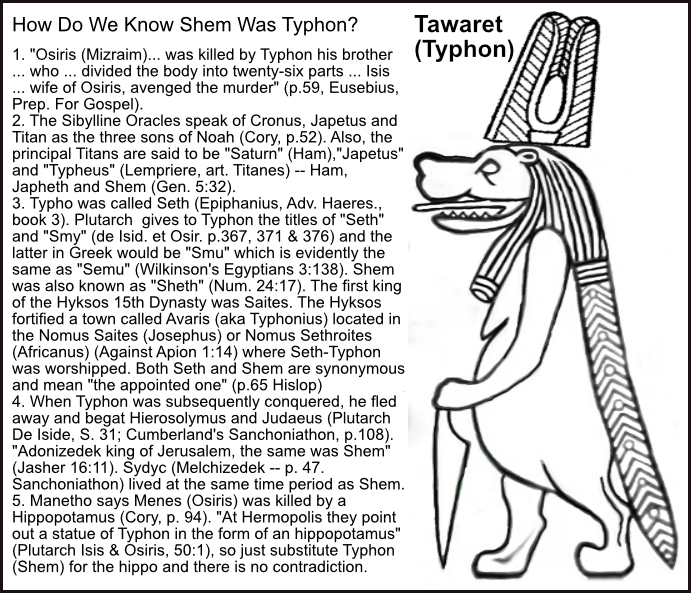
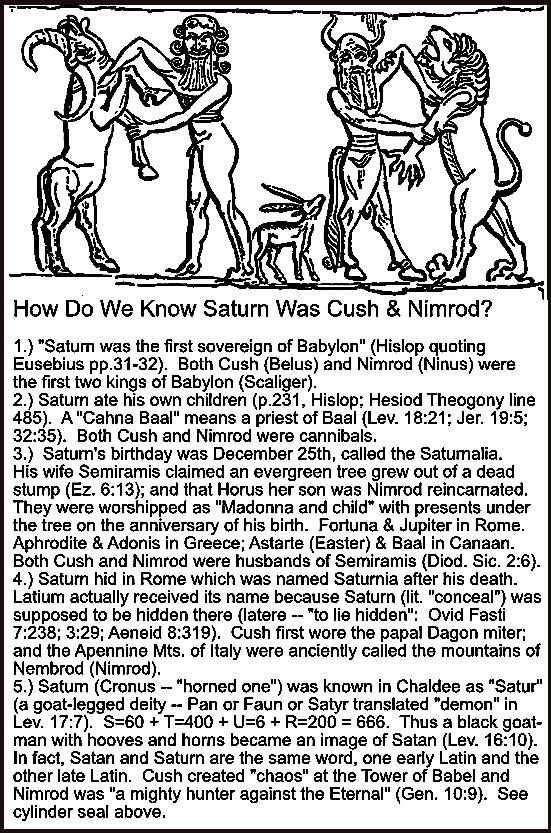
.jpg)
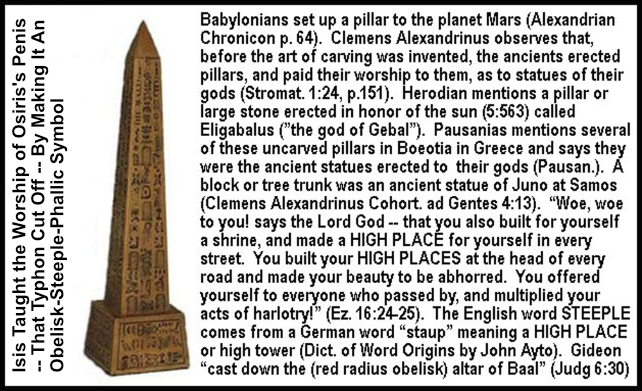
..jpg)
Shem (Typhon, Set, or Melchizedek) Executed Osiris (Mizraim) for Idolatry and Cut His Body into Pieces
At the Tower of Babel different ethnic groups were given different languages. Since nobody could understand eachother, Nimrod, Semiramis and Horus were each given a different name in each different language. What thereafter appeared to be polytheism was actually just the same ruling family of Babylon under multiple names. Many nations around the world -- Japan, China, India, Scandinavia, Ireland and Iceland -- each WEEP for their dead god (Marduk, Osiris, Balder, Tammuz, Bacchus, Nin, Mithra) hoping for him to be restored to life. This practice is still found today in the LENT season. Bacchus actually means "the BEWAILED One" or "LAMENTED One" (Hislop, pp. 55-57). Even Israelites in their time wept for the death of Tammuz: "There sat women WEEPING for Tammuz" (Ez. 8:14).
The Sibylline Oracles speak of Cronus, Japetus and Titan as the three sons of Noah (Cory, p.52). Also, the principal Titans are said to be "Saturn" (Ham) "Japetus" and "Typheus" (Lempriere, art. Titanes). The term "Titans" means "earth-born" (unaffected by Nephilim intercourse) in contradistinction to "heaven-born" (nephilim). "After the Flood ... Titan (Shem) undertook a war against Kronos" (Ham) (p.75, Cory's Fragments). When Typhon (Shem) killed Osiris (Mizraim), Thoth (Cush) was appointed king in his place by Cronus (Ham). Cush (Saturn) was made king over Egypt by his father Cronus (Ham). Typhon (Shem) raised sedition and inflamed the minds of the people against Cush (Hermes), thus overcoming the influence of Cush (Lemprierre: Osiris & Typhon). Cush fled to Italy (Lempriere Saturn). Latium actually received its name because Saturn (lit. "conceal") was supposed to be hidden there (latere -- "to lie hidden"; Ovid Fasti 7:238; 3:29; Aeneid 8:319). The ancient name of Rome before it was rebuilt in 753 BC was Saturnia -- the site of Cush's hiding place. (In Chaldean, Saturn is pronounced Satur and consists of only four letters: S=60, T=400, U=6, R=200; total 666). The Apennine Mountains of Italy were anciently named the mountains of Nembrod (or Nimrod) leading some to believe that it was Nimrod who actually hid out in Rome. The Persian author Rashid al-Din in his History of the Franks mentions that Nimrod extended his hunting expeditions even to Italy. He was a "Lupercus" (wolf-hunter) and a valentine (from "valens" meaning strong) -- "a mighty hunter" (Gen. 10:9). The word for "heart" in Chaldean was "bal" just as Nimrod was Baal (Lord). Shem was regarded as the foe of Osiris (Mizraim) and all the gods of Egypt (Bunsen's Egypt 1:456). "When the false prophet named Thammuz preached to a certain king that he should WORSHIP the seven STARS and the twelve SIGNS of the ZODIAC, that king ordered him to be put to a terrible death ... And hence arose the custom every year, on the first day of the month Thammuz, to mourn and to weep for Thammuz" (Maimonides, More Nevochim, p. 426).
Typhon, (the Greek name for a serpent), the name given to Shem, was also the name given to the ocean (Typhoon) which destroyed the antediluvians, and was represented by a hippopotamus with crocodile tail (see image above) among the Egyptians. We consequently find Manetho saying that Menes (Osiris), whose kingdom was overthrown by Shem, perished by a wound from a Hippopotamus (Cory, p. 94). "At Hermopolis they point out a statue of Typhon in the form of an hippopotamus" (Plutarch, Isis & Osiris 50:1). Substitute the name Shem for Hippopotamus and the contradiction disappears. Typhon was the Ahriman, or Satan, of the Egyptian theology. "Down to the time of Rameses, B.C. 1300, he was one of the most venerated and powerful gods. After about 970 B.C. he was regarded as the foe of Osiris and all the gods of Egypt" (Bunsen's Egypt's Place 1:456)
Who executed this giant Mizraim? One of the names of Hercules was "Sem" (Wilkinson, vol.5, p.17) who killed Mizraim "by the power of God" and then cut his body into pieces (vol.4, pp.330-332) or tearing him limb from limb (p.81, Sanchoniathon). Shem was also known as "Sheth" (Num. 24:17). Typho was called Seth (Epiphanius, Adv. Haeres., book 3). Plutarch (de Isid. et Osir. p.367, 371 & 376) gives to Typhon the titles of "Seth" and "Smy", and the latter in Greek would be "Smu" which is evidently the same as "Semu" (Wilkinson's Egyptians 3:138; Bonwick, p.133). Therefore, another account reads: "Set, the brother of Osiris (Mizraim), rebelled against him and cut his body in pieces" (Rawlinson's Egypt and Babylon). Both Seth and Shem are synonymous and mean "the appointed one" (p.65, Hislop). The Egyptians called him Set (in Hebrew Satan; p.86, Bonwick) and painted him red, the color of sin (Isa. 1:18; Num. 19). The goat, over whose head the Egyptian confessed his sin, was devoted to Typhon. The Greeks called him Python (p. 137, Egyptian Belief and Modern Thought by Bonwick). They assigned the red jackass (or red saluki hound dog) as his sacred animal. They labeled him "the almighty destroyer and blighter." They said he filled the world with forms of evil -- serpents and crocodiles and hippopotami, beetles and dragons and asps. They said the hot wind that blasted the trees was the breath of Set -- the mildew and the blight were flung by his hands upon the gardens and orchards. This "trial of cruel mockings" (Heb. 11:36) was what Shem, "the king of righteousness" (Heb. 7:2), endured who "subdued" the idolatrous "kingdom" (11:33) of Egypt and "of whom the world was not worthy" (11:38).
Philo called him "Sydyc the Just" (Melchizedek -- p. 47. Sanchoniathon). "Adonizedek king of Jerusalem, the same was Shem" (Jasher 16:11). According to Ludovicus Vives, Ninus was torn in pieces (Commentary on Augustine 6:9 note, p.139). Just as Nimrod was torn in pieces in Babylon by the hand of Shem when his body was dismembered and the pieces distributed throughout the cities of Nimrod's dominion, so also Orpheus was torn to pieces in Thrace (Ludovicus Vives 6:9 note p.239), and Bacchus was torn to pieces in Greece, and Osiris (Mizraim) was torn to pieces in Egypt and a similar fate was suffered by Lycurgus (Hyginus Fab. 132, p.109) whom the Phrygians identified with Bacchus (Strabo 10:3 p.17). In the rites of Bacchus a spotted fawn was torn in pieces in commemoration of the death of the god, and the spotted fawn was called Nebros, and was the symbol of Nebrod, the name of Nimrod in Greece. To further confirm this fact, the father of Bacchus was Ammon (Thymaestes 33) or Ham.
"Osiris ... was killed by Typhon (Shem) his brother ... who ... divided the body into twenty-six parts ... Isis ... wife of Osiris, avenged the murder ... having slain Typhon (Shem) ... became queen of Egypt ... found all except one part of the body of Osiris ... and gave them to the priests throughout all Egypt to be worshipped." (p.59, Eusebius, Prep. For Gospel) This was the beginning of RELIC WORSHIP. "The member which had been cast into the river by Typhon was deemed worthy by Isis of divine honors no less than the rest. For she set up an image of it in the temples (OBELISK or STEEPLE) and instituted worship ... as the Greeks received their orgiastic rites and Dionysiac festivals from Egypt, they also worship this member in their mysteries, and in the initiatory rites and sacrifies of this god, and call it Phallus." (p.60, Eusebius, Prep. For Gospel; Lempriere: Isis, Phallica) This was the beginning of PHALLIC WORSHIP. In Greek mythology, In consequence of this, there were many burial places of Osiris in Egypt, at each of which a shrine was erected containing one of the relics of Osiris. There were several cities in the middle of Egypt called "BUSURIS" meaning the burial place of Osiris (Osburn Monumental History of Egypt, 1:328-329; Hesychius says the Cretans and others prefixed B to words beginning with vowels ; hence Bel and Bal for El; Busuris for Osiris). Typhon is also called Typhoeus. The gods were so frightened by his victory that they fled away to Egypt where Pan (Cush) told them to assume the shapes of various ANIMALS to conceal their identity (Ovid Fasti1:393-404; Hyg. Fab. 196; Lempriere, Typhoeus, Pan, Gigantes). In other words, the dead king and his father Cush were idolatrously worshipped in the shape of ANIMALS using secret MYSTERY religions to avoid exposure. The complete defeat of Semiramis by the king of India and the destruction of her army prevented any assistance from Babylon (Lenormant, Ancient History of East 1:364,367).
This is why the priests of Baal cut their bodies (1 Ki. 18:28) in imitation of what Osiris "suffered at his death" (Julius Firmicus p.18). Herodotus speaks of the Carians doing the same (2:61). Egyptians who died were, in a manner, identified with Osiris, and were called by his name, and therefore their mourners also cut themselves. Hence the command: "Ye shall make no cuttings in your flesh for the dead" (Lev. 19:20).
Just as Isis (Semiramis) slew Typhon (Shem), so also in a similar way, Minerva (Semiramis) is represented as slaying the giant Pallas (Shem) in the war of the giants against against the gods (Smith's Class. Dict. Athena); and the goddess Parvati (Semiramis) slays the giant Durga (Shem) and "the gods regained their former splendor" (Wilkins, Hindu Mythol. pp. 247,249). Another account says that "Mahesha, king of the giants," overcame the gods in war and they had to wander about as beggars, but Vishnu formed a woman called "Maha Maya" (i.e. Parvati or Semiramis) who slew Mahesha (Shem) (ibid. pp. 249,250). Another account says that heaven was invaded by men who overcame the (pagan) gods and the latter were forced to wander about, and "sacrifices, ascetic practices and ordinances ceased." (ibid. pp.272-273). Nitocris (Semiramis), queen of Babylon and Egypt, revenged (Ninus) her brother's death, who was king of Egypt and had been put to death by his subjects (Herod. 2:100). Neith and Athena are other names for Semiramis.
As further proof that Typhon was Titan, or Shem, it is related by Plutarch that when Typhon was subsequently conquered, he fled away and begat Hierosolymus and Judaeus (Plutarch De Iside, S. 31; Cumberland's Sanchoniathon, p.108). That is Hierosalem, or Jerusalem, and Judea. This is a mystical way of saying that he was the founder of Jerusalem and the ancestor of the Jews. This tends to identify Shem with Melchizedek, whose name means "righteous king," and "all thy COMMANDMENTS are RIGHTEOUSNESS" (Ps.119:172). He was king of Salem or Jerusalem. As "priest of the Most High God" (Heb. 7:1), he was evidently the origin of the name Jerusalem, or Hierosalem, "Hieros" or "Hiereus" meaning "priest."
Typhon overcame Osiris "not by force or open war, but, having entered into a conspiracy with SEVENTY-TWO of the LEADING MEN of Egypt, he got him into his power and put him to death, and then cut his body into pieces and sent the different parts to so many different cities throughout the country" (Wilkinson's Egyptians 4:330-332). This agrees with Diodorus who reported that Egypt was divided into SEVENTY-TWO Nomes and each had a JUDGE (Diodorus 1:48-58; Hislop, p.64 note). Cutting up the dead body and sending it to different cities was an ancient method of expressing both warning and command, as in the case of Saul when he cut up a yoke of oxen and sent the pieces to the 12 tribes with the warning that "Whosoever goeth not forth with Saul and Samuel so shall it be done to his oxen" (1 Sam. 11:7). Ancient Greeks recognized Shem as Typhon of Egypt and he was also recognized as such by Herodotus (485-425 B.C.) and Plutarch (46 B.C.). Plutarch says that Shem was a fair person with a red complexion. “TYPHON HAD RED HAIR” (De Iside et Osiride , 362. xxx). Shem (Typhon -- a derogatory name applied to him by the Egyptians) “was red in complexion” and “had red hair.” For an account of Mizraim’s death at the hands of Shem (Typhon) see Diodorus of Sicily, Vol. I, Book 1, para. 21, and para. 88. Notice the following interesting quote: “RED oxen, however, may be sacrificed, because it is thought that this was the colour of TYPHON (Shem), who plotted against Osiris [Mizraim] and was then punished by Isis for the death of her husband. Men also, if they were of the same colour as Typhon, were sacrificed, they say, in ancient times by the kings at the tomb of Osiris; however, only a few Egyptians are now found RED in colour, but the majority of such are non-Egyptians” (Diodorus of Sicily, Book I, para. 88). "Typhon RED in complexion, and Horus FAIR, and Osiris DARK-skinned" (p.96, Eusebius, Prep. For Gospel).
The overthrow of the chief of primitive idolatry is also a prominent feature of other nations. In the Scandinavian traditions Balder was slain through the treachery of the god Loki, who like Typhon, is the spirit of evil, while the empire of heaven (pagan gods) depended on the life of Balder. His father Odin or Woden (Cush), is said to have learned the terrible secret (the means of establishing relations with demons) from the book of destiny (Scandinavia 1:93-94). In India it is said that a giant named Durga "dethroned Indra and the other gods, and abolished sacrifice. the Brahmans gave up reading the Vedas; fire lost its energy, and the terrified stars disappeared" (Wilkins, Hindu Mythol., pp.247,249)
. This parallels the defeat of the gods in Grecian mythology by the giant Typhoeus or Typhon, which, in other words, was the overthrow of the worship of fire, and of the stars and the practice of human sacrifices.
Diodorus (2004, Book I, Ch. 2., 29) learned from the priests of Thebes that “From Osiris (Mizraim) and Isis to the reign of Alexander the Great . . . the Egyptian priests reckon above ten thousand years, or (as some write) little less than three-and-twenty thousand years (lunations)." Multiplying 23,000 lunations or months by the 29.53 days in a synodic month and dividing by 365.25 days per year gives 1859.52 Julian years. Adding this to Alexander’s conquest of Babylon 331 BC yields 2190 BC. However, if counting from his conquest of Egypt in 332, it gives 2191 BC to Osiris and Isis.
"All scripture (including the Old Testament) is given by inspiration of God, and is profitable for DOCTRINE, for REPROOF, for CORRECTION, for INSTRUCTION in RIGHTEOUSNESS" (2 Tim.3:16) and the only "scriptures" known to Timothy were the Old Testament scriptures. And "whatever things were written aforetime (in the Old Testament) were written for our LEARNING" (Rom.15:4). "Now these things (we read about in the Old Testament) were our EXAMPLES" and "they are written for our ADMONITION, upon whom the ends of the world are come" (1 Cor.10:6,11).
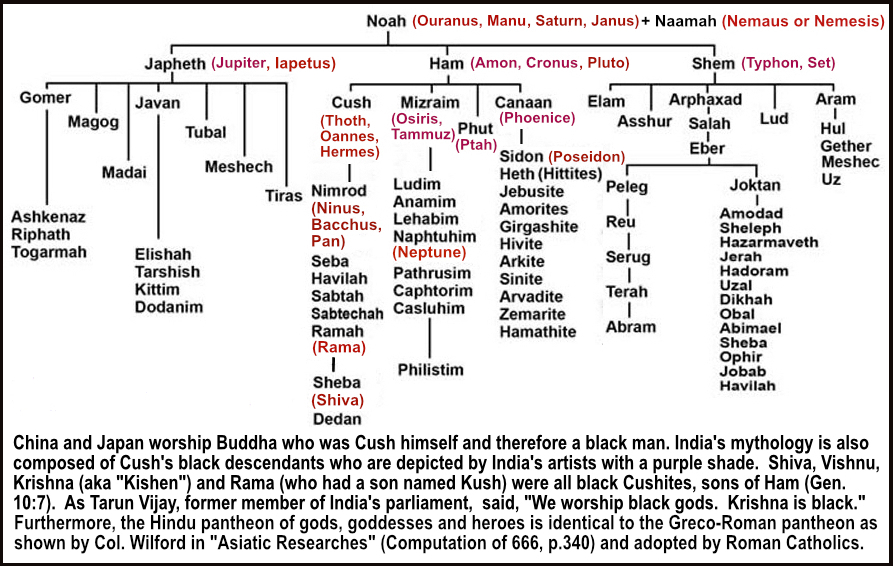
Secular History Confirms Tower of Babel Dispersion When "Earth Divided" (Gen 10:25) At Peleg's Birth (2203 BC)(Ant. 1:6:4)
or "Four Years After" His Birth (Syncellus, p.75) or in "the 140th Year of Phaleg" (Abulfaragi, Hist. of Dynasties, p.11)
The Tower of Babel is said to have been built in “a plain in the land of Shinar” (Gen 11:2) also known as Sumer. The whole of Babylonia is designated Sumer and Accad, and among their other titles the Babylonian and Assyrian monarchs always are called "king of Sumer and Accad". Sumer comes from Heb. Shingar. But ng is frequently changed in Accadian into m. Thus their word Dingir (God) becomes Dimmer, and Dingira (a surname of the goddess Istar) becomes Dimir. In this way Singar or Sungar became Sumer or Shumer in which form it is met constantly on the monuments. Sennaar of Babylon is mentioned by Hestiaeus the Milesian (Ant. 1:5 & Eusebius de pr. ev. 9:15) and the city of Singara in Mesopotamia is mentioned by several (Ptolemy table 4; Pliny Nat. Hist.; Amm. Marc.). As for the difference between the words Shinaar and Singar, it is very small, considering in the Hebrew, the same character stands for the Ain and the Ghain. For instance either Gomorrah or Amorrah is correct. Either Gazah or Azzah (Gen. 10:19).
The first names in the Bible, whether given to men or places, were all Hebrew. The explanation or meaning of those names was also in Hebrew. Thus, Adam ("Red Mud"), Eve ("Living"), Cain ("Get"), Seth ("Appointed"), Noah ("Rest"), Nimrod ("King Rebel"), Babel ("To Confound"), Abraham ("Father of a Multitude") etcetera all had Hebrew names. The wonderful names by which God has revealed Himself to us -- Jehovah-Jireh ("The Lord Will Provide" -- Gen. 22:13), El Shaddai ("Lord God Almighty" -- Gen. 17:1), and El-Roi (Gen. 16:13 -- "The One who Sees") -- were also Hebrew. Jerusalem is a combination of Jireh, when Abraham offered Isaac, and Shalom, the residence of Melchizedek (Beresh. Rabbah 9). The confusion of tongues occurred among those who had forsaken God, leaving the original language with His obedient Heber children who were "separate from sinners" in Babylon. Hence it was called Hebrew. The Hebrews retained the original language unaltered from creation. The confusion was in "pronunciation" (Young's Literal Trans.; Hebrew "saphah", translated "language" in Gen. 11:1,6-7, literally means "lip") by variations of the labial letters (p,b,f,v), which accounts for the existence of Hebrew roots in every language. Pronunciation, not words or roots, were altered. The characteristic letters of words remained unchanged. Some languages are full of gutterals or consonants, while others have scarcely any. The Chinese find difficulty in the letter R, and the Arabs in P. The Hurons in America have no labials at all in their language, and therefore when they speak have no occasion ever to shut their lips. But a child whose tongue is not stiffened by long habits of a particular utterance finds it easy to form strange sounds.
"They journeyed eastward" (miqedem) (Gen. 11:2) is the correct translation based on the same phrase found in Genesis 13:11 where Lot journeyed "eastward" (miqedem) from Bethel to the Jordan plain. Henry Rawlinson shows that the chronology of Ctesias makes the beginning of the reign of Ninus (Nimrod) 2231 B.C. (Rawlinson's Herodotus vol.1, pp.434-435). In the days of Yoktan ("Small") the "lives of ... men were ... lessened" (Jasher. 7:20) eventually to "three score and ten" (Ps. 90:10). Then at the Tower of Babel mankind was divided into linguistic groups around 2203 BC when Peleg ("Division") was given his name, "for in his days was the earth divided" (Gen. 10:25). Psalm 55:9 uses the same root to describe a moral division -- not a physical one. Undaunted by the dispersion of his followers, Nimrod obstinately remained upon the spot, when a violent wind overthrew the tower, and crushed the tyrant as it fell (Syncellus, Chronog., p.42; Cedrenus Comp. Hist., p.11). Then the "square pyramid" (Strabo) Tower of Babel ziggurat became the model for Hindu pagodas, solar temples of Mexico, the pyratheia of Persia and even the pyramids of Egypt. A perpetual signal fire at the top provided a LANDMARK "lest we be scattered abroad" (Gen. 11:4) -- to prevent dispersion of mankind and aid in navigation. They were after all living in a vast, undistinguished plain and needed to travel far and wide for pasture, etcetera. The name "shem" should not be rendered "name", but "SIGN," so the passage reads, "Let us make us a SIGN (beacon), lest we be scattered." The ziggurat tower fire was used to worship the sun, moon and stars. The king studied their movements before making any important decision or going to war (ASTROLOGY). In fact, "a tower whose top may reach unto heaven" (Gen. 11:4) may be better translated "a top with signs of the zodiac." Calisthenes sent to Aristotle a register of astronomical observations, made at Babylon, extending back from the taking of that city by Alexander the Great, 1903 years, near to when the tower was built. It was, however, chiefly devoted to the worship of Bel or Baal, whose temple contained immense treasures, including several statues of massive gold, one of which was forty feet in height. Here was deposited the sacred golden vessels brought from Jerusalem (2 Chr. 36:7; Jer. 51:44). The ritual of HUMAN SACRIFICE was performed at the top, while royal BURIAL CHAMBERS were hidden deep inside. A woman spent the night in the top temple and had SEX with the "god" (fallen angel) (Her. 1:181-182; Gen. 6:4) TO PRODUCE GIANTS. The Babylonian harlot sat on seven hills (cp. Rev. 17:9). The tower, it is supposed, afterwards became the tower of Belus in that city. Herodotus visited this tower, and described it as a square pyramid 660 feet in length and breadth, or half a mile in circumference at the base, from which arose eight towers one above another, decreasing in size to the summit, which was reached by a broad road winding up around the outside, wide enough for carriages to pass eachother, and even to turn. Strabo says it rose to the same height -- 660 feet. Its ruins are supposed to be Birs Nimroud, six miles southwest of Hilleh, the modern Babylon. It is an immense mound of sun-dried bricks, laid with bitumen, strewn with fragments of pottery, etc., fused by some intense heat. It is 190 feet high, with a tower on the top 35 feet high and 90 feet in circumference, rent at the top as if by lightning.
The king's palace was in an enclosure of six miles in circumference, in which were the hanging gardens, sustained by arches upon arches four hundred feet high, terraced off for trees and flowers, and watered from the river by concealed machinery. A "goodly Babylonish garment" (Josh. 7:21) was luxurious and coveted.
Berosus, as quoted by Abydenus, informs us: "They say that the first inhabitants of the earth, glorying in their own strength and size, and despising the gods, undertook to raise a tower, whose top should reach the sky, in the place in which Babylon now stands; but when it approached the heaven, the winds assisted the gods, and overthrew the work upon its contrivers: and its ruins are said to be still at Babylon: and the gods introduced a diversity of tongues among men who, till that time, had all spoken the same language" (Cory's Fragments, p.34). Eupolemus wrote to the same effect: "The city of Babylon owes its foundation to those who were saved from the catastrophe of the Deluge. They were the giants, and they built the tower which is noticed in history. But the tower being overthrown by the interposition of God, the giants were scattered over all the earth" (ibid., p.57; Euseb. Praep Evang. 9:18). Ancient Sibylline oracles also testified: "When the tower rose to the skies upon Assyria's plain, and all mankind one language only knew; A dread commission from on high was given to the fell whirlwinds, which with dire alarm beat on the tower, and to its lowest base shook it, convulsed. And now all intercourse, by some occult and over-ruling power, ceased among men: by utterance they strove perplexed and anxious to disclose their mind; but their lip failed them, and in lieu of words, produced a painful babbling sound: the place was hence called Babel; by the apostate crew named from the event. Then severed far away, they sped uncertain into realms unknown: thus kingdoms rose, and the glad world was filled" (Bryant's Ancient Mythology, vol. 4, p.103; Antiq. 1:5). Hestiaeus says, "The priests who escaped" (from the Deluge) "took with them the implements of the worship of the Enyalian Jove, and came to Senaar in Babylonia. But they were again driven from thence by the introduction of a diversity of tongues; upon which they founded colonies in various parts, each settling in such situations as chance or the direction of God led them to occupy" (Cory's Fragments. p.50). Josephus cites a declaration of one of the Sibyls to the following effect: "When all men spoke one common language, some of them built a most lofty tower, as if with an intention of scaling heaven: but the Gods, sending a violent wind, overthrew it, and gave a different mode of speaking to each person; for which reason the city was called Babylon" (Ant. 1:4; Euseb, Praep. Evan. 9; Syncel. 44).
Nimrod, (the Belus of profane history) the grandson of Ham, built Babylon on the Euphrates and Asshur, son of Shem, built the city of Nineveh (capital of Assyria) on the Tigris. Menes (Mizraim) was the first king of Egypt. Sometime later Shepherd Kings ruled for 259 years in Egypt. Justin mentions "Phoenicians driven to Tyre by an earthquake" (Philip. 18:3) which probably subverted Babel. These emigrants were descendants of Canaan, who, as Eupolemus informs us, was the founder of the Phoenicians. The Phoenicians (Canaanites) colonized Greece, Sicily, Sardinia, Spain and western coast of Africa.
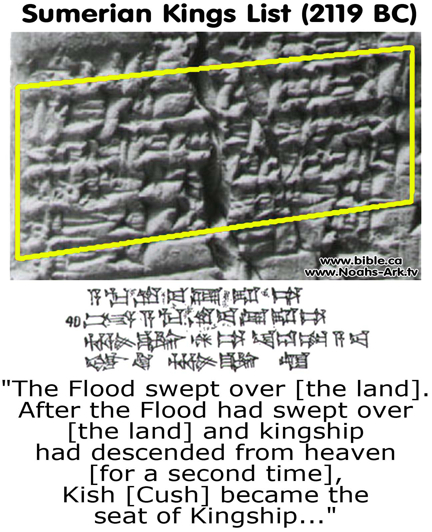
.jpg)
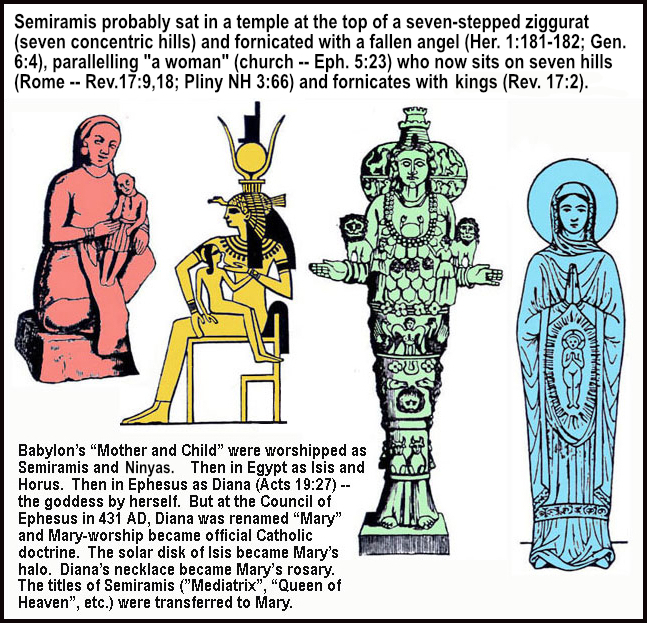

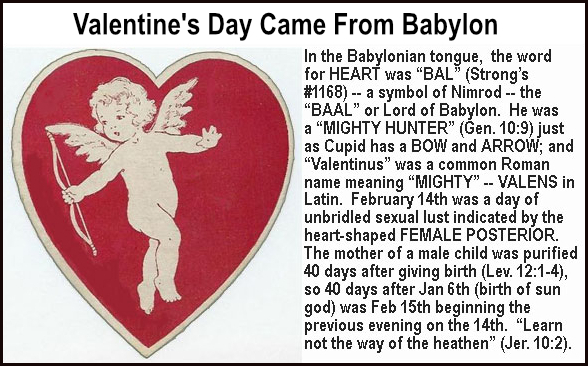
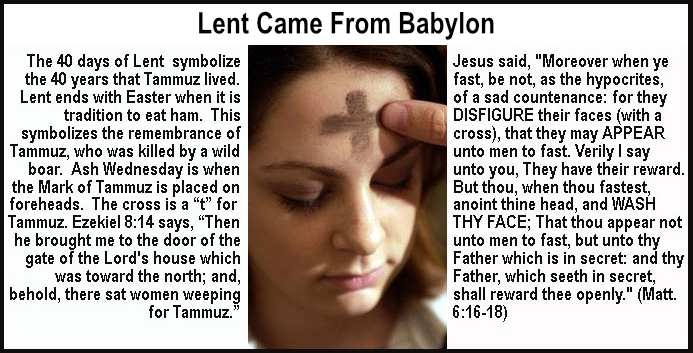
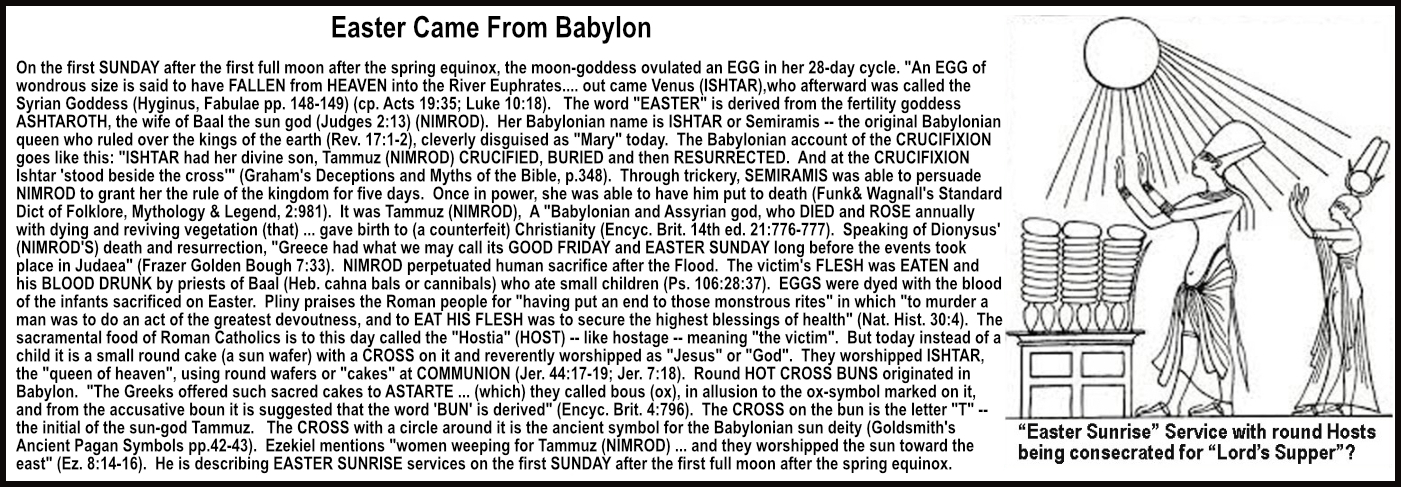
| The Colonization of India in 2254 BC |
According to the Hindu traditions the world was divided after the Flood, and the Indian ancestors were given their portion. After 150 years of ruling themselves, a foreigner named Pradyato usurped the throne and established his own dynasty over them (A Key to the Chronology of the Hindus: In a Series of Letters, in Which an Attempt is Made to Facilitate the Progress of Christianity to Hindostan by Proving That the Protracted Numbers of All Oriental Nations When Reduced Agree with the Dates Given In the Hebrew Text of the Bible: Vol.1 and 2 by Alexamder Hamilton; p.124). They date the Usurpation of Pradyato to the one thousandth year or year 1,002 of the Kali Yuga depending on the source (ibid, pp.123,126,153). The Kali Yuga was 3,725 years before the Hijirah of Mohammed in AD 622 (A New Analysis of Chronology and Geography, History and Prophecy, in Which Their Elements Are Attempted to Be Explained, Harmonized and Vindicated Upon Scriptural and Scientific Principles by William Hales 1830, p.197), therefore, 3104 BC. However, Indian calculations from the Middle Ages dated the Kali Yuga two years later in 3102 BC. Using the astronomically corrected date for the Kali Yuga, the usurpation of Pradyato occurred in 2104 BC, and the division of the earth 150 years before that, in 2254 BC.
| The Colonization of Tyre in 2203 BC By Phoenicians |
Justin mentions "Phoenicians driven to Tyre by an earthquake," (Histories Philippic 18:3:2-3) which was probably the same earthquake that subverted Babel. If so, then it probably occurred around 2203 BC. These emigrants were descendants of Canaan, who as Eupolemus informs us, was the founder of the Phoenicians. The tower erected by the first Postdiluvians was demolished (2203 BC) which caused the dispersion of mankind.
| Colonization of China: The First Three Chinese Dynasties Prior To A Solar Eclipse of 776 BC Add Up To 2197 BC Confirming Bible Chronology Of The Dispersion At The Tower of Babel in 2203 BC |
The Shu King informs us the reign of Emperor Yâo, began the year after the Flood (Legge 1879, 34–36) (or 2303 BC). Yao, their most ancient sovereign, acknowledged by Confucius, is introduced abruptly as saying to his ministers, "Alas! the deluging waters are spreading destruction. They surround the mountains. They overtop the hills. They rise high, and extend wide as the spacious vault of heaven." (Chou-king by Confucius, translated by De Guignes, pp.1-2; and Dr. Morrison's citation from it, in his preface to the Chinese Dictionary. Also Records of the Grand Historian by Sima Qian) Fong-sou-long says, "Niuhoa conquered the waters by wood, and made a vessel fit for a long course." (Mem. Ch. i.p.157) It was during the reign of Emperor Yao that the Great Flood of Gun-Yu began (about 2300-2200 BCE), a flood so vast that no part of Yao's territory was spared, and both the Yellow River and the Yangtze valleys flooded (Wu, 1982, p. 69, The Chinese Heritage).
One Chinese writer "Kong-in-ta adds that the waters overwhelmed the animals and all habitations" (Ib. 158). Another Chinese writer, Mong-tsee, remarks, "Under Yao, the empire was not yet formed. The stagnant waters of the Deluge still covered the plains, and what was not under water was covered with trees." (Ib. 159). By cutting large canals, Yao made the country habitable (Ib. 160).
Since Noah lived 950 years (Gen.9:29: 2904-1954 BC), 1. he was contemporary with Fohi (Fuxi), the first emperor of China who began to reign 2303 BC. (add 600 yrs - 7:11) Both died same year. 2. Fohi had no father (Noah's ancestors perished in Flood), and 3. his mother was said to have conceived him encompassed in a RAINBOW (Gen. 9:13) 4. He was born in the Yellow River just as Noah survived the Flood. 5. He raised SEVEN kinds of animals for sacrifices to the Great Spirit (cp. Gen. 7:2; 8:20). 6. Fohi (Fuxi) was "very virtuous" (Bedford's Scripture Chronology, p.287) just as Noah was "just" and "a preacher of righteousness" (Gen. 6:9; 2 Pet. 2:5).; he instituted marriage to avoid promiscuity; and a distinction between men's and women's clothing; and made humane laws; and put walls around cities; and invented Chinese Cangjie writing (Wiki). 7. His wife and sister was named Nuwa (Noah) and repaired the sky. There was great flooding, and Heaven had collapsed. Newa was the one who patched the holes in heaven. These were the original humans. 8. He "looked upward and contemplated the images in the heavens (zodiac), and looked downward and contemplated the occurrences on earth." (Wiki) (Bible star charts) 8. Fohi (Fuxi) settled in the province of Shensi, which is the most NW province of China (nearest to Ararat). The Bible says little about Noah's 350 years after the flood or the peopling of China. (Hist. Sinicam 1:21; Shuckford's Connections 1:44; Legge 1899, 41–42).
Confucius relates that during the reign of the Emperor Yew Wang an eclipse took place. ("And now the sun became faint.") The Emperor reigned between 781 and 771 BC, and it has been generally thought that the eclipse of 776 BC is the one referred to (Chambers, G. F. 1912, The Story of Eclipses; New York: D. Appleton and Company).
Chinese records reveal the lengths of the first three Chinese dynasties prior to the solar eclipse of 776 BC as: 441 years for the Xia Dynasty; 644 years for the Shang Dynasty and 336 years for the Western Zhou Dynasty till the Solar eclipse in 776 BC. If we add these figures together, the sum takes us back from 776 BC to 2197 BC for the founding of the Xia Dynasty by Yu, the successor of Shun (Shem?).(See Legge, James. trans. 1879. The Sacred Books of China: The Texts of Confucianism. Part I The Shu King, the Religious Portions of the Shih King, the Hsiao King. Oxford, United Kingdom: Clarendon Press.) The 50-year reign of Shun (Shem?) and 100-year reign of Yao (Noah?), take us back to the Flood, which is dated by the Chinese to the seven hundred and fifty-seventh year of the Kali-Yuga Era, which was dated 3104 BC by Chinese calculations in the nineteenth century making the Flood 2347 BC. But there may have been overlap due to a co-reign of Shun with his predecessor Yao bringing the Flood down to 2304 BC.
Gutzlaff says the first two Chinese dynasties (Hea [Xia] & Shang) commenced in 2207 B.C. and extended down to 1123 BC according to Confucius (Gutzlaff, A Sketch of Chinese History, pp.58-60). But he doesn't use the solar eclipse of 776 BC as a benchmark, so his dates are slightly less accurate.
The Flood was said by Confucius to have occurrd in the seven hundred and fifty-sixth year of the Kali-Yuga, which would be 2348 BC (Hamilton 1820, A Key to the Chronology of the Hindus 316).
| The Colonization of Peru By Viracocha (Noah) in 2154 BC |
Acosta, in his History of the Indies 1:25, says, "They (American Indians) make great mention of a Deluge which happened in their country.... That all men were drowned in this Deluge. And they report that out of the great lake Titicaca came one Viracocha (Noah), which staid in Tiaguanaco, where at this day there are to be seen the ruins of ancient and very strange buildings, and from thence came to Cusco; and so man began to multiply." (A Treatise on the Deluge by Catcott). Fernando Montesinos was a Spaniard who collected the songs and legends of the Indians of Peru and Ecuador in the sixteenth century. His record of these legends is called the Quito Manuscript. In it, he records the Peruvianoral tradition of their ancestors being led by Noah, called Viracocha, to colonize Peru in the distant past (Hylands, Sabine. 2010. The Quito Manuscript: An Inca History Preserved by Fernando de Montesinos; p. 121). This is a collection of the poems and ancient songs of the Indians, and it is according to what great authors say, that one hundred and fifty years after the deluge, there were so many people who grew and multiplied in those lands of Armenia, that seeing the Patriarch Noah so much number of people, moved by the urgent need and divine plan that the men of God had to fill the world, he commanded his children a.nd grandchildren to go with his families to look for land to populate; and there is no lack of those who say that the Patriarch himself, Noah, went to show and distribute the land, and that he gave back to everyone. One hundred and fifty years after the Deluge (2304 BC) is 2154 BC. Both the Chinese and Peruvians date their first kingdom to 150 years after the Flood, while the other precisely triangulated dates fall around 2192/1 BC. It seems possible that some of the Semitic tribes may have departed from Babel about seven years before the confusion of tongues definitively ended the project.
The Founding of Trier, Germany, By Nimrod's Son Trebeta in 2053 BC
The city of Trier claims to be the oldest city in Europe, founded about 2053 BC. According to the Gesta Treverorum, the city was founded by Trebeta, a son of Ninus prior to Ninus’ marriage to Semiramis I. After Ninus died c.2068 BC, when Semiramis took over the Kingdom, Trebeta left Assyria and went to Europe. Hoeh states: (1967, Ch. 19) “The inhabitants of Trier maintain that their city is the oldest in all Europe,” writes Josef K.L. Bihl in his textbook “In Deutschen Landen”, p.69. “Trier was founded,” he continues, “by Trebeta, a son of the famous Assyrian King Ninus. In fact, one finds. . . in Trier the inscription reading, ‘Trier existed for 1300 years before Rome was rebuilt.’” According to tradition, Rome was founded by Romulus and Remus in 753 BC. 753 BC + 1300 years = 2053 BC. Another source (Dornberg, John. 1997. “Rhineland-Palatinate: Trier— Germany’s Oldest and ‘Most Splendid City’.” German Life, April/May: 19–21. https://web.archive.org/web/20101215220338/http://germanlife.com/Archives/1997/9704_01.html.Dornberg 1997) suggests 2,000 years before Caesar. 79-60 BC + 2,000 years= 2079-2060 BC. Hoeh (1969, Ch. 1) suggests that the German chronicles, based on Tumair’s writings, state that Tuisto left for Europe 153 years after the Flood (2304 BC) in 2151 BC. Assyria Proper was known as Aturia where the capital of Nineveh was situated (Ridpath's History of the World p. 164) and so apparently another colony was planted in Europe with the name Austria and capital Vienna (Nineveh backwards).
| The Colonization of Ireland By Partholan in 1991 BC |
Three ancient Irish sources, nearly agree with one another, but differ somewhat for the date of founding of the country by Partholan. They generally agree that Partholan colonized Ireland about three centuries after the Flood.
The Annals of Clonmacnoise place Partholan’s arrival in the first year of Semiramis, 313 years after the Flood (2304 - 313 = 1991 BC), but date his occupation of Ireland from the twelfth year of Semiramis (1979 BC), and the invasion of Milead in the twelfth year of King David (Murphy, Denis. J. (ed.) 1896. The Annals of Clonmacnoise: Being Annals of Ireland From the Earliest Period to A.D. 1408. Translated in 1627 by Conell Mageoghagan. Dublin, Ireland: Royal Society of Antiquaries of Ireland) or 998 BC. According to the Annals of the Four Masters, from the first year of Partholan’s reign in Ireland to the invasion of Milead was 980 years (Ryan, Emma. ed. 2002. Annals of the Four Masters. Translated by John O’Donovan. Cork, Ireland: CELT. https://celt.ucc.ie/published/T100005A/index.html). The Book of Invasions dates the arrival of the Milesians as 440 years after the Exodus (1446 BC), (Macalister, R. A. S. (trans. and ed.) 1941. Lebor Gabála Érenn: Book of the Taking of Ireland. Part 1. Dublin, Ireland: Irish Texts Society), which gives 1006 BC, the fourth year of David.
Using these dates for the Flood (2304 BC), the Exodus (1446 BC), and the accession of King David (1010 BC), the first year of Partholan’s occupation of Ireland, 12 years after his arrival, would be 1979 BC, from which the 980 years were counted to Milead in 999 BC, and the first year of Semiramis I would be 1991 BC. Due to having three sources that do not precisely agree, this calculation has an error of about ± 5 years.
The difference between Partholan’s arrival 313 years after the Flood, and his occupation 12 years later may mean that he spent a little over decade exploring the land and living in tents until breaking ground on his first settlement in 1979 BC.
| "To this came next, in course, the brazen age: A warlike offspring, prompt to bloody rage." (Ovid's Metam. 1:160) "Jove sent a flood to destroy the men of the brazen age" (Homer's Iliad 1:10. Didym.) (this was Deucalon's flood c.1548 BC - Parian Chronicle; Herodotus 7:129; Aristotle's Meteorology 1:12; Apollonius Rhodius 3:1085-9; Pindar Olymp.v.76; Ovid's Metam. 1:187; Apollodor., i., 7, 2.) "The sire of earth and heaven created then A race, the third, of many-languaged men; Their thoughts were bent on violence alone, The deed of battle and the dying groan; They by each other's hands ingloriously fell, In horrid darkness plunged, the house of hell." "you remember one deluge only, whereas there were many of them" (Plato, Critias 111). (1.Moses' 2.Ogyges', (Varro de Re Rust. lib. iii. cap. i.), 3. Deucalion's 4. Dardanos's) Cedrenus quotes proof, and Syncellus. confirms it, that the Ogygian flood was 248 years before Deucalion's : which Apollodorus sets in the time of Cranaus the successor of Cecrops. (p.233 Primitive History by Williams). "Babylon brought to subjection, [small] and great he confounded their speech. their strong place [tower] all the day they founded; to their strong place in the night entirely he made an end. In his anger also word thus he poured out: [to] scatter abroad he set his face he gave this? command, their counsel was confused" (Assyrian fragment col. 1:7-14; Smith, Chald. Acct of Gen., p.160). |
|
"He (Jupiter) seized him (Vulcan-Ham) by the foot, and headlong threw From the high tower of Belus" (Homer's Iliad 591) "Giants ... built the tower... But when this had been overthrown by the act of God, a diversity of tongues was introduced among men, and the giants were dispersed over the whole earth" (Eus. Praep. 9:17; Syncel. Chron. 44; Eusebius Chron. 13) |
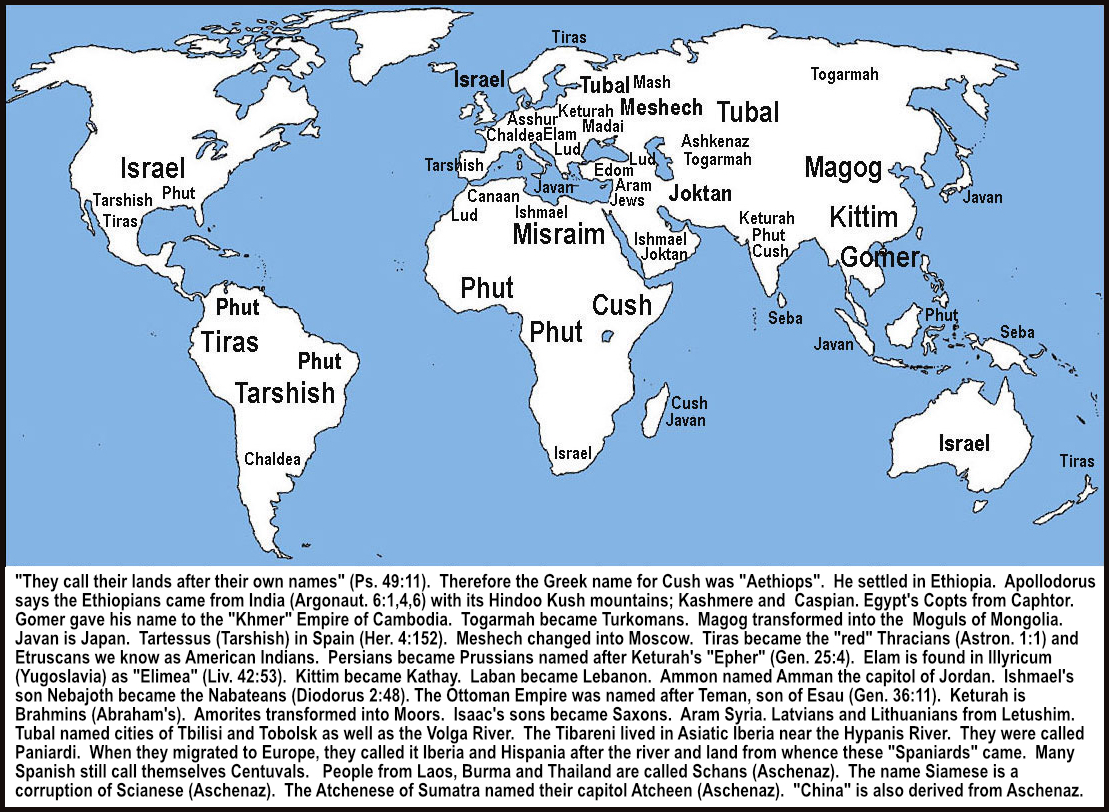

Seventy-Two Nations Correspond to Seventy-Two Israelites
There are SEVENTY-TWO nations mentioned in Genesis 10 (see LXX) (not counting the three sons of Noah who were not alive at the partition of the earth). Japheth's 14; Ham's 30; and Shem's 28. Horus Apollo says, "It is reported that the world was formerly in SEVENTY-TWO divisions:" Epiphanius adopts SEVENTY-TWO nations. Hippolytus' Chronicle refers to SEVENTY-TWO nations (pp. 50, 52, 331). Syncellus mentions SEVENTY-TWO languages. Clement of Alexandria says there were only SEVENTY-TWO languages (Strom. 1:21; 142:2). Enoch agrees to SEVENTY-TWO languages of the world (3 En. 17:8; 18:2; 20:2). The Chinese suppose the number of nations to be SEVENTY-TWO. As Moses said, "When the Eternal divided to the nations their inheritance; when he separated Adam's sons, he set the boundaries of the people, according to the number of the children of Israel" (Deut. 32:8) because there were also
SEVENTY-TWO Israelites. "And the sons of Joseph, who were born to him in Egypt, were TWO souls: all the souls of the house of Jacob, who came into Egypt, were THREESCORE and TEN" (Gen. 46:27) -- a total of SEVENTY-TWO. "He cast out the heathen also before them, and divided them an inheritance by line, and made the tribes of Israel to dwell in their tents." (Ps. 78:55).
Other instances where the Bible mentions this number are:
SEVENTY left the camp and TWO remained in the camp (Nu. 11:16). SEVENTY-TWO cattle (Nu. 31:38) and lambs (1 Esd. 8:65). Later, the number SEVENTY-TWO would also be the number of Hebrew scholars who translated the Scriptures into Greek, six from each of the twelve tribes requested by King Ptolemy II Philadelphus (282-246 BC), which they accomplished in SEVENTY-TWO days. (Letter of Aristeas 32) Also "The Lord appointed SEVENTY-TWO others and sent them two by two" (Luke 10:1).
After the Flood, Noah and Japheth settled in northern Armenia at the banks of the Araxes, in a town named Nachshevan (Noah's settlement). He married a nymph named Asia. Shem settled in Sham (Damascus) and may have been Melchizedek (King of Righteousness) and the founder of SUMerian civilization (BA, 9/1976, p. 84); and Ham settled in Babylon as its first king -- Belus. Ham was also called by the ancients Indus, which not only names a great river, but also the whole Indian continent. Hindoostan was peopled by the descendants of Ham.
Ham means "burnt" (black).
At the dispersion of mankind, Cush (meaning "black" -- Jer. 13:23) retained possession of Babylon, and his descendants populated Chusistan (called Cusha Dwipa within by the Hindus), Arabia, the southern shores of Persia, and southern India. Kush's descendants in India are called Kshtriya. Cush and Midian dwell together in tents (Hab. 3:7) indicating Arabia. Arabs border on Cushites ( 2 Chr. 21:16) indicating Arabia. For more proof see Ez. 29:10, 2 Ki. 19:9, 2 Chr. 14:9. Hindoos are descended from Cush and Phut (Hindoo Kush mountains; Kashmere; Caspian; Brahma-Putra). The Arabians divide the country of the Hindus into two parts: Sind (west - Indus) and Hind (east - Ganges). The Greek name for CUSH was "AETHIOPS" (cp. Jer.13:23). Egyptian monumental inscriptions call the land south of Egypt "KEESH" (modern Geez). Tell el Amarna tablets call this land "KASHI" (Ethiopia). The Meroitic Ethiopians are called KASU (9:847a). The "Ethiopians ... are even at this day, both by themselves, and by all men in Asia, called CUSHITES" (Ant. 1:6:2). Eusebius says the Ethiopians came and settled in Egypt in the time of Amenophis (Chron. ad Num. 402). He places Amenophis's reign so as to end about 431 years after Abraham's birth. According to Philostratus, there was no such country as Ethiopia below Egypt until this migration (Vit. Apollon. Tyanei 3:20); these people came, according to Eusebius, from the river Indus (Chron. ubi sup.), and planted themselves in the parts beyond Egypt southward. Thus began the kingdom of Ethiopia. Homer mentions two Ethiopian nations "in twain are divided ... Some toward the setting sun, and some toward the land of his rising" (Odyss. 1:23). See also Herodotus 7:70. Apollodorus says the African Ethiopians came from India (Argonaut. 6:1,4,6). Eustathius hints that the Ethiopians came from India (Dionys. p. 35). "'Abyssinian' ... is derived from the Arabic Habesh, 'mixed' and was a derisive name applied by the Arabs to the heterogenous inhabitants of the Abyssinian plateau.... The majority ... may be described as a mixed Hamito-Semitic people ... hair long and straight or somewhat curled and in colour dark olive, approaching to black" (1:88ab). Nimrod's descendants were giants (p.65, Syncellus; cf. Gen. 10:8-9). Sheba is found in Arabia as Sabeans whose capital was Saba in Yemen. Balkis, who visited Solomon, reigned there and Christ called her the queen of the south, for yamin with the Jews, as well as yaman with the Arabs, signifies the south; and Saba is in that part of Arabia called Yemen.
Misr migrated to Egypt (Gen.13:10; Isa. 19:6). Sanchoniatho shows that Misor or Mazor is the true name of the father of Misraim. Bochart shows that Egypt was called Misor and Masor in Scripture.
Josephus says they all called Egypt, Mezre. Bochart 1.7. says "the Arabs now call Alcairo, Meser; the prime Egyptian Month is Mesori." Sanchoniatho says, "Misor is liberal" being from the Syriac Mesoro. Misor or Menes had several cities dedicated to him, as Mendes in the Delta; Menae in Sicily, having a sacred well of that name near it; Manaim in Judea; Mendae in Thrace; Mendes the Egyptian Pan, the oldest God of Arcadia, being Menes or Misor. Diodorus Siculus says an inscription of Osiris recorded that he penetrated into India, and the Artic regions, and to the Springs of the Danube. From Misr came the Caphtorim (Gen. 10:14) who named Egypt "Ai capt" or "covered land" because according to Herodotus "the delta was originally a marsh covered with water, and so was all the lower Egypt" (Her. 2:4). They became the Copts. Pathrusim became inhabitants of Pathros. The Naphtuhim moved to Algeria. "Neptune they (the Greeks) learned from the Libyans, for no people except the Libyans originally possessed the name of Neptune, and they have always worshipped him" (Her. 2:50). Ludim became Lydia and Phrygia because Meon or Manis (Mizraim) was their first king (see Diodorus or Herodotus or Dionysius Halicarnassus) and Manis was a Phrygian hero (Plutarch De Iside) and Lydian and Phrygian solemnities of the Mater Devrum agree with the Egyptian solemnities to Isis. Lydians were first called Maeones. Also Menes (Mizraim) did "pass into Phrygia, and the nations adjoining" (Lydia)(Eusebius, Prep., p.46). Diodorus says Osiris (Mizraim) did pass through most of the then known and habitable world; and because he taught them to sow corn, plant trees, and build houses, was everywhere received as a deity. Tyrrhenus led away a great colony out of Lydia into Tuscany Italy. Philistines are called Cerethites (1 Sam. 30:14,16; Ez. 25:16; Zeph. 2:5). The Septuagint translates that word Cretes. They settled in Crete. Phut possessed the northern coast of Africa, specifically Libya (Ant. 1:6:2). According to Ptolemy there is a river in Mauretania which goes by the name Phut, What we in our translation render Libyans is in the original sons of Phut. Jerome notices a district in Libya, called Regio Phutensis, or "the land of Phut." A river in Mauretainia with the adjacent region is named Phut (Jerome's Hieronym in tradit. Hebrew) Phut migrated to northwestern parts of India -- in Rajah Putana; on the banks of the Puddah or Ganges; in Bhutan; and in Bhuto or Tibet. Canaan settled in Phoenicia and Palestine. The cities of Sodom and Gomorrah were Canaanite. Tyre and Sidon were also cities of Canaan. "And all the people that were left of the Amorites, Hittites, Perizzites, Hivites and Jebusites which were not of the children of Israel, their children that were left after them in the land, whom the children of Israel were also not able to destroy, upon those did Solomon levy a tribute of bond-service unto this day" (1 Ki. 9:20-21). They became part of Israel. And at the return from captivity, there is mention made of the children of Solomon's servants: "And all the Nethinims, and children of Solomon's servants, were three hundred ninety-two" (Ezra 2:55,58; Nehem. 11:3; Jos. Ant. 8:2). "The Phoenicians themselves say, that they formerly dwelt on the Red Sea, and passing from thence, stationed themselves on the sea coast of Syria. All this region of Syria, up to Egypt, is called Palestine." (Herodotus 7:89) Sanchoniatho says that Chna was the first who was called a Phoenician (Apud Euseb. praep. evang. 1:10 p.39). Stephanus relates that Azotus (Ashdod) was built by fugitives who fled from the Red Sea. "The Phoenicians, therefore, came from the Red Sea ... when David conquered the Edomites (1 Ki. 11; 2 Sam. 8), and made them fly every way from the Red Sea ... And this flight gave occasion to the Philistines to call many places Erythra, in memory of their being Erythreans or Edomites, and of their coming from the Erythrean Sea: for Erythra was the name of a city in Ionia; of another in Libya; of another in Locris; of another in Boeotia; of another in Cyprus of another in Aetolia; of another in Asia, near Chius: and Erythia Acra was a promontory in Libya, and Erythreum a promontory in Crete, and Erythros a place near Tibur, and Erythini a city or country in Paphlagonia; and the name Erythea, or Erythrae, was given to the island of Gades, peopled by Phoenicians ... Edom, Erythra, and Phoenicia are names of the same signification, the words denoting a red color; which makes it probable, that the Erythrians who fled from David settled in great numbers in Phoenicia; that is, in all the seacoasts of Syria, from Egypt to Zidon; and by calling themselves Phoenicians in the language of Syria, instead of Erythreans, gave the name of Phoenicia to all that seacoast, and to that only" (Chronology of Ancient Kingdom, pp. 108-109). "The elder shall serve the younger" was verified in the times of David, when the Edomites were subdued by him (2 Sam. 8:14), and afterwards (2 Chr. 25:11-12); and after that by the Maccabees, in the times of Hyrcanus, when the Edomites or Idumeans became one people with the Jews, and embraced their religion (Ant. 13:9:1), rather than to be dispossessed of their country; and will have a further accomplishment in the latter day, when the prophecies in Obadiah 1:18 shall be fulfilled. The Arvadite settled in Arwad (Arados) Island, Syria. Arkites and Zemarites in Tripoli Libya (p.66, Syncellus). Girgashites in Gargareis, whom Strabo (11:5:1) associates with the northern foothills of the Caucasus (p.69, Syncellus). "IRELAND was colonized by the Phoenicians" -- Abbe Brasseur de Bourbourg (in a note to his translation of the Popul Vuh). Canaanites are known as CELTS today who comprise the IRISH, WELSH and HIGHLAND SCOTS. But they are also FRENCH, SPANISH, PORTUGUESE and ITALIAN. Hittites drew their own figure and represent themselves as short, stout, and with a protuberant face and often beardless. Their features are not Semitic or Japhetic. Their language is Hamite.
Elam was Shemite and became allied with Japhetic Persians (Ant. 1:6:4). Elymis, the capital city, was later called Persepolis (2 Macc. 9:2). Southern Persia was called Elymais, a district of Susiana. Asshur was driven out of Shinar by Nimrod and moved to Assyria where he built Nineveh (Gen. 10:11; Ant. 1:6:4). At present called Curdestan. These Karman Persians became known as Germans (Her. 1:125) who migrated to Europe and were called Prussians. The Egyptians called the Assyrians Rutennu. This name may have been derived from the "great city" of Resen built by Asshur (Gen. 10:11), with the commonplace interchange of a dental and a sibilant frequent in Shemitic languages. In the Sanscrit and Persian languages there is no need to translate some of the words into German: pader (father), mader (mother), sunn (son), dokhter (doctor), brader (brother), denta (tooth), nasa (nose), hrti (heart), stara (star), asthi (bone), eyeumen (eye), brouwa (eye-brow), dhara (earth), arrivi (river), nau (ship), ghau (cow), sarpan (serpent), etc. Arphaxad (Urfa Chesed) settled in the province of Arrapachitis as Chaldeans (Ant. 1:6:4). The Assyrian "S", when it comes before a "D", was generally pronounced as an "L". The Hebrew Khasdim became Assyrian Khaldi. Xenophon's Anabasis generally calls them Khalubes, but when negotiating with the men of Sinope (5:5:17) he terms them Khaldaioi, and Strabo expressly identifies the two races as one (12:3:19). The ancient capital of Armenia was named Artaxiasata and the Arpatchai River is in the south Caucasus. The father of Abraham went forth with his family "from Ur of the Chaldees, to go into the land of Canaan; and they came unto Haran and dwelt there" (Gen. 11:31) "from the other side of the (Euphrates) River" (Josh. 24:3) so it wasn't the southern Ur near the Persian Gulf which was on the west side of the Euphrates, but the northern Ur on the east side of the Euphrates. Haran was the karrhai of Ptolemy, which lay between the Khabour and the Euphrates, in the district called Padan-aram (Gen. 25:20). As Canaan was southwest of Haran, it follows that Ur was northeast. In this direction, in the highlands drained by the eastern arm of the Euphrates, was a place called Ur (Amm. Marc. 25:7-8), and in its neighborhood were settled the Khalubes of Xenophon, who, as Strabo tells us (12:3:19), were the same people as the Khaldaioi. Hence we have "Ur of the Chaldees." Abraham and Isaac (Saxons) descended from this branch mixing with Arameans of Shem. Lud founded the Lydians of Asia Minor (Ant. 1:6:4) and Herodotus calls them Etrurians. Arabic legends found in Abulfeda's Historia Ante-Islamica say that Amalekites ruled in Egypt, that Joseph's pharaoh was an Amalekite and that Amalekites descended from Lud (Abulfeda, Hist. Ante-Islamica, p.16). This is why Amalek was "first of the nations" (Hyksos) (Nu. 24:20). Amalekites were called Maachath (Malaka -- 2 Sam. 10:6-8 Onomasticon & LXX) or Makedones (Esther 9:24 LXX) who settled in Lydia and Thrace (pp.202, 222, Origines Celticae; Strabo 13:4:5; Pliny 5:31) (Macedonia). Haman is called the Agagite (Esther 8:3; 3:1) and Josephus makes him an Amalekite by descent (Ant. 2:6:5). The Septuagint in Esther 9:24 calls him the Makedon. Asclepiades the Egyptian historian published a book on Ogygian Egyptians (Hyksos?). The Oguges of Greek legend and Agagi in Persia (Origines Celticae, p.242) in all probability represent the Scriptural name of Agag (Nu. 24:7). Hence we may infer that the name Agag, which is twice given to the first and last kings of the Amalekites (Nu. 24:7; 1 Sam. 15:8), meant simply the Amalekite. Steph. Byz. informs us that Boeotia and Thebes were called Ogugia from Oguges son of Termera, who also gave the Lycians the name Ogugioi. The same writer quotes the Chronicles of Charax as his authority for saying that the whole of Attica was once called Ogugia. The Ludoi under Tursenos their leader, sailed from Smyrna, and after traversing many countries landed among the Ombrikoi where they were called Tursenoi (Her. 1:94). -- the Etrusci of Roman history. Virgil gives the Etruscans the name of Tyrrheni, according to the later Roman fashion (pp.254-255, Origines Celticae). How could they descend from Esau (Gen. 36:12) when Chedorlaomer "smote the country of the Amalekites" (Gen. 14:7) before Esau was even born? Further, Israel was commanded to be at peace with Esau (Deut. 2:1-8; 23:7) but to "blot out" Amalek (Deut. 25:17-19; Ex. 17:14; 1 Sam. 15:2-3). They were two different peoples. Esau's Amalek wasn't above two generations of descent older than Moses, and could not possibly in so short a time, grow to be so powerful a nation as to attempt openly a war with 600,000 Israelite men. Aram migrated to Padan-Aram; and crossed the Euphrates westward inhabiting Syria (Aram) (Ant. 1:6:4); and inhabiting Aramenia (or Armenia). Homer's Iliad mentions Arameans (2:783). Strabo says those we call Syrians call themselves Arameans (Geog. 1:42). Hence the Arami, Arimi, Erembi, and the like. Aram had four sons: Uz founded Trachonitis and Damascus; Chul founded the Chaldeans; Kurds (Carduchians -- Targum of Onkelos; corrupted into Gordiaeans and Cordyaeans -- Ant. 1:3,6); northern Syrians (around the ancient city of Chalybon -- now Aleppo, and the river Chalus); Cholobatene and Colthene, provinces of Armenia; and the Chalybians and Colchians; also Magardoi (p.63 Syncellus). Gether founded Bagetria, or Bactria (Ant. 1:6:4). They became Armenians. Pliny says "the Massagetae were originally Arameans" (6:17). He became the Getes; Agathersi; Massagetes; Goths; and Scythians; finally becoming the Gothic peoples of Europe: Norwegians, Swedes, Danes and English. Mash founded the district of the Masian mountains in central Armenia; the province of Moxoene, or Moush, in Armenia. Called Meshech in 1 Chr. 1:17 or Messenians (p.63, Syncellus).. Joktan is the Midianites (p.63, Syncellus), some of whom may have migrated to Yucatan Mexico. Joktan is called Kahtan by the Arabs. They descend from him. Their country of Arabia derives its name from Jerah, one of his sons. Abimael became the Hyrkanians (p.64, Syncellus). Almodad became the Indians (p.63, Syncellus). Ishmael's son Nebajoth became the Nabateans (Diodorus 2:48). Peleg may be the Pelasgians of Greece and Italy as well as Bactrians (p.63, Syncellus). Eber is Hebrews. The south of Spain was at a very early period inhabited by a people called IBERIANS and an EBRO River in Spain -- both taking their name from Eber. Also the Gaudalquiveir River (anciently called Wadi-al-HIBRI), as well as the island of HIBERNIA (Ireland today) and HEBRIDES (off Scotland) may take their names from him. Nebuchadnezzar "made an expedition against ... Iberia, and having subdued them, settled a part of their inhabitants on the right shore of Pontus" (p.405, Eusebius, Preparation For Gospel). Reu built Rages in Media and Serug may have built Saruj, the capital of Divar Modar.
Japheth became the Latin Jupiter or the Greek Iapetus. Gomer gave his name to the Umbri of Italy (later called Latins when Aeneas and his Trojans united with them) and the ancient town of Comari, or Comara, in Galatia (Ant. 1:6:1). Then around the Caspian Sea, on the Jaxartes, in Tartary and in Sogdiana as Gomerians. Ptolemy 6:17 calls them Comerians between Paropamisus and Mount Imias and between the confluence of the rivers Oxus and Oby. Their capitol was Chomar. Ashkenaz gave his name to a river and bay called Ascanius in Bithynia. See Iliad 2:862 for a place called Askania. Pontus Euxinus (Black Sea) was originally called Axinus by the Greeks; and the city of Tashkend and Assaceni and river Etchine sound similar. An ancient city near the Caspian Sea is called Askabad and means "the abode of Askenaz." According to the Tartars and Orientals, the Chinese are descended from Tchin, the son of Japheth, and brother of Tarag, or Turk, from whom came the Turkmans (Togarmah). Tchin is therefore Ashkenaz. The orientals call all grandsons, sons. The proper name of the Siamese and the Schan States, or Laos, is Schans -- derived from Aschanaz. The name Siamese is corrupted from that of Scianese (Askenaz). The people of Cochin-China and Siam, as well as the Arabs, call China, Tcin, from which Europeans call it Sino-, and the people Sinese. The Atchenese of the empire of Atcheen, in Sumatra, are the descendants of Aschenaz. The capitol was Atcheen. Japan is named Sacaia (Pausan. 6:519). The letters T and S are often substituted for eachother. Riphath moved first to Paphlagonia (Ant. 1:6:1). Meala (book 1) assures us that anciently the people of Paphlagonia were called Riphataei, or Riphaces. He is called Diphath in 1 Chr. 1:6 because the resemblance of Resh and Daleth is very close. Pliny speaks of the Riphaei as the inhabitants of Paphlagonia. Bochart finds the river Rhebas, Rhebaus, or Rhebanus near Paphlagonia. North of Hungary are Carpathian mountains. Rhone River in France. Syncellus says Riphath became the Sauromatai (p.68).
The name Togarmah must have been transposed mistakenly since the r comes before the g in the Septuagint: Thorgama; and in Josephus: Thruggramma. And Trocmi in other writings. Also the Turkmans and some of the Tartars (Turkomania in Tartary and Scythia) state that they are descended from Torg, the son of Japheth and brother of Tchin, who founded the Chinese. The monkish historian Moses of Chorene derived the Armenians from Haik, son of Togarmah. Furthermore, the ancients state that some of the inhabitants of Scythia were descendants of Targitaus, son of Jupiter. The Orientals, Persians and others state that the Turkomans and Turks are descendants of Tarag, son of Japheth. All have r before g. Togarmah first migrated to Phrygia (Ant. 1:6:1) and Galatia (Her. 7:73). Thrygamians probably became corrupted into Phrygians. A river in Phrygia was the Gallus, so the people were called Galli. These Phrygians and Galatians migrated to the south coast of France (Phraggoi) or Gaul and Belgium as Galati or Celts (or Gaels or Keltoi). In the 9th century, King Joseph of Khazaria wrote: "We have found in the family registers of our fathers that Togarma had ten sons, and the names of their offspring are as follows: Uigur (the Uighurs of W. China -- Brit. 27:469c; 20:359c), Dursu (the language of NE China is "Daur"), Avars (known as Avari peoples of Russian Georgia today), Huns (of Hungary), Basilii (named the Basilan Islands, Philippines?), Tarniakh, Khazar (Kazakhstan -- Brit. 15:774c; some Ashkenazi Jews came from Khazaria), Zagora, Bulgars (Bulgaria), Sabir (Siberia)." (Koester's Thirteenth Tribe, p.64). "It was from the ... Ugrian Finns that the Magyars came ... who in 889 and onward finally settled in ... Hungary (Ugri, Wengri, Ungri, Ungari, Hungari, Hungary) (p.260, Bliss, Peopling the Earth). Wise Feridun repressed idolatry and divided his empire between his three sons in his lifetime. A division of considerable importance, because it still exists in Oriental Geography. To Irage his youngest, he gave Persia, thence called Iran. To his eldest, Tur, he gave Tartary, thence called Turan and afterward Turkestan, whence the Turks derive their name. To his second son, Salme, he gave Mogreb. Feridun also gave his sons titles which have been handed down to the present day. To his youngest, Schah, the title of the Persian monarch to this day. To his oldest Fagfour, which is still retained by the porcelain China ware in the Levant, corruptly called farfouri. To his second, Kaisar, or Caesar, still assumed by the emperor of the West.
Josephus says, "Gomer, the eldest son of Japhet, was father of the Gomerites, called by the Greeks Galatians" who were the Gauls of Asia Minor, inhabiting a part of Phrygia. Eustachius of Antioch says, "Gamer (i.e. Gomer) was founder of the Gamerians, whom we now call Galatians or Gauls." (Commentary on Hexameron, p.51). St. Jerome says the Galatians are descended from Gomer (Trad. Hebr. in Graec.). "The Celts or Galatae are the descendants of Gomer" (Origin. 9:2) explains Isidore. The Chronicle of Alexandria says the same. The Gauls of Asia Minor inhabited part of Phrygia and later moved to France (as Phraggoi) or Gauls. "The children of Gomer ... were the Francum, who dwelt in the land of Franza ... by the river Senah (Seine) (Jasher 10:8). Galatia was occupied by the Trogmi, Tectosages and Tolistoboii. Bochart observes that certain Gauls, under the conduct of Trocnus, made a settlement in Cappadocia, and were called Trocmi, or Throgmi. The Toorgmans inhabit the country beyond the Caucasus mountains extending from the river Kuban to the Caspian Sea. The river Terek runs into the Caspian Sea.
Also the city and province of Astrakan. Another division of the Toorgmans, or Trukhmans, inhabit the territory east of the Caspian Sea, extending southwards to the river Attruck. The largest division of Toorgmans inhabit Turkestan proper, bounded on the west by the Aral Sea. Its chief cities are Turkestan and Tashkend. Tartars say their proper name is Toorgman, or Turk, otherwise Trukhman. All Tartar and Turkman races say they are descended from Toorg or Turk, the son of Japheth, who was first khan or king of all the nations now known as Turks, Turkomans, and Tartars; that he reigned in Central Asia, or Turkestan, and lived to the time of Abraham. The Armenians call the propagator of their nation, and the first ruler of their country, Haig or Haik whose father they believe to have been Torgama. A manuscript chronicle in the Georgian language, compiled by order of Tachtang, late Prince of Georgia, from the archives preserved in the mountains of Galatia, near Cutais, says, "In the year of the world 1792, BC 2208, there dwelt in a fortress on Mount Ararat, a man named Targamos. He lived 600 years, and was father of eight sons: 1. Aos, from whom descended the Armenians; 2. Kartelos... Georgians; 3. Baidos ... Shirvan; 4. Moakan ... Erivan; 5. Lekas ... Lesguis; 6. Eros ... Mingrelians; 7. Kaukas ... Caucasians; and 8. Egros ... Imeretians and Caketians."
Magog became the Scythians (Ant. 1:6:1), Georgians, Caucones, Kirghizes (Kyrgyzstan), Mogols or Mongols (Mongolia), Manchus (Manchuria) and Magyars (Hungary). North of the Great Wall of China are the Mogul Tartars from Magog -- whom Arabs call Majuj and Yajuj. Madai became the Medes. Pliny mentions "the river Don, where the inhabitants are the SARMATAE, said to be descended from the MEDES" (6:7) (UKRAINE). Herodotus tells us that "originally the Medes were called by all people Aryans" (7:62). Meshech migrated first to Cappadocia in Asia Minor (Ant. 1:6:1). Then into Muscovy where he built the city of Moscha, now called Moscow, on the river Moscha, now Moskwa. Associated with Meshech is Rosh because in the isthmus between the Euxine and Caspian Seas near the Moschici dwelt the Rhossi on the River Cyrus according to Joseph Ben Gorion, or rather on the Ros, Ras, or Aras, called by the Greeks Araxes. Tiras became the Thracians. His descendants also settled in Samothrace and Dacia. Tiras gave his name to the river Tyras (Dniester). He also gave his name to the river, bay and haven of Atyras in Thrace (now Glycynero); the town Tiristasis, the river Trausus, and a people called Trausi on its banks, in Thrace; the promontory Tiristria, and the town Trissae; and the river Tearus. Tiras became the "red" Thracians (Ant. 1:6:1; Astron. 1:1) and Etruscans we know as American Indians.
Javan became Ionia. Homer mentions the Iaones (Iliad 13). Javan in Scripture is translated Greece (Dan. 8:21; Joel 3:6). He had four sons. The first was Elisha (Elis, Hellas, Hellen; Halizones, Lycians, Aeolians, Alisium). Olympia was a city of Elis where the Olympic games began in 776 BC and repeated every four years thereafter. Ezekiel mentions the isles of Elisha (Peloponnesia -- which contained a city and province called Elis.). The second was Tarshish (Tarsus Cilicia, Tartessus Spain, Tartary). The (Spanish) coast is called Tarseion by Polybius (L.3. Rosen. p.83). Holofornes went into Cilicia and destroyed all the children of Tarshish (Judith 2:12-13). Tarshish became Iberians (p.68, Syncellus). The third was Kittim (Cyprus with capital Citium, Macetae of Macedonia, two town in Latium called Cetia and Echetia, a river near Cumae called Ketus). "Chittim are the Romim who dwell ... by the river Tibreu" (Jasher 10:16). Homer mentions a people called "Cetii" (Odyssey 11:520; Strabo 13) (from the river Cetius). Eusebius says that the Latins sprang from the Kitioi, and the Romans also. Kitioi are also called Latins and Romans by Syncellus (p.68; p.346 also includes Albanians). Macedonia is called "land of Chetiim" (Maccabees 1:1; 8:5). Suidas mentions the "Latini, now Romans; for Telephus, the son of Hercules, who was called Latius, changed the name of those who before that were dominated Ketii into Latini" (Suidas, Voc. Latinoi, vol.2, p.13). The ships of Chittim (Dan. 11:30) refer to the Roman fleet persuading Antiochus to desist his plans against Egypt. In Ptolemy, we find two provinces in Cilicia called Cetis and Citis. Josephus says Cyprus is Kittim with town called Citium (Ant. 1:7). Korea's capitol was King-Kitao from Kittim. Strabo's Cathea, though west of the Ganges, seems to be China. The fourth son of Javan was Dodan. The letters d and r are scarcely to be distinguished in the Hebrew. (eg Syrian king Hadadezer = Hadarezer; Josephus calls Ben-Hadad by the names of Adad, Adar and Ader) Dodan or Doran settled in a country called Doris in Asia Minor and on the island of Rhodes off the southern coast of Doris. Dodona Greece was named after him. Dorians colonized the Peloponnessus and Sicily and the sea coast of Italy, the latter hence called Magna Grecia. The river Rhone in France -- anciently called Rhodanus -- may be named after him.
According to Varro and Dionysius Hal. Italy was first colonized from Greece, and the first Greeks who settled there were from Arcadia. And Reineccius and Sir Walter Raleigh are inclined to think, from several passages in Strabo, Dion. Hal., Pliny and Justin, that Italy derived its name from a colony of the Aetolians, who settled there: for the Greek name Aitolia, in the Aeolic dialect, used by the Aetolians, and which is the basis of the Latin tongue; was pronounced Aethalia (as Aetolians) whence Italia was easily formed; and the lower part of Italy, in the neighborhood of Tarentum, which was founded by a colony from Lacedaemon, was called Magna Graecia, in which the Greek language prevailed for a long time.
Tubal settled in Armenia, Albania, Iberia, Colchis and Pontus -- all in Asia. The Tybareni, or Tibareni mountains, were so called from Tubal. Also the country of Tibarene (eastern Pontus) and Iberia derived from Tubal. He gave his name to Thabilaca, a town of Albania. Tubal migrated to Siberia and named the river Tobol and its capital city Tobolsk. As Tubal increased in population, he sent colonies to Europe -- a European Albania and a European Iberia (Ant. 1:6:1; Polybius 3:37). The city of Se-tubal, a fortified seaport of Portugal, was called by the Latins Setobriga, after Tubal or Tubar. The Cantabri of Asturias and Artabri around Cape Finisterre, both in Spain, derive their names from Tubar.
The Paniardi (Tubal) lived near a river anciently called Hypanis (now Kuban) which ran into the Black Sea. When they migrated to European Iberia, they named it Hyspania, or Hispania, named after the river of Asia, from whence the Paniardi, or Spaniards, first came. (see Ethnology by Painter for more) Also "Tubal dwelt in Tuscanah, and their boundaries reached the river Tibreu, and ... Tubal built a city in Tuscanan ... called ... Sabinah ... after the ... son of Tubal" (Jasher 17:2).
Herbelot, from the oriental writers, presents this view of Japhet's posterity, as their traditions transmit it: "Japheth had eleven male children, Gin or Tchin (or Sin), from whom the Chinese came; Seklab, whence the Sclavonians; Manschuge, from whom issued the Goths, or Scythians, called Jagiouge and Magiouge; the Hebrew Gog and Magog; Gomari; Turk; Khozar, the ancestor of the Khozarians; Rous, the father of the Russians; Soussan: Ghaz and Tarage, from whom came the Turcoman." (D'Herb. Bib. p.470. voc. Jafeth.)
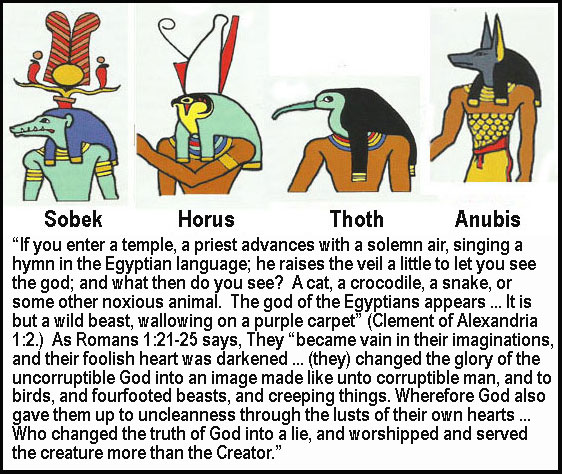
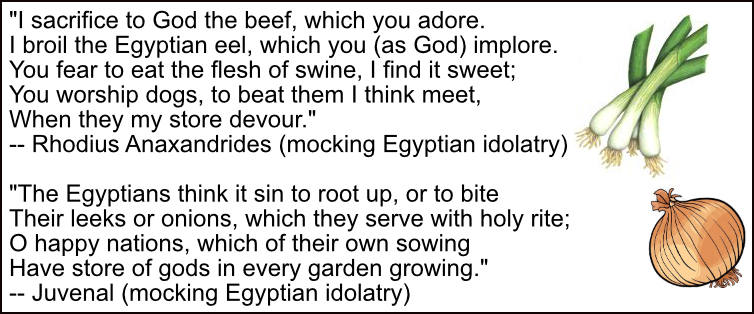
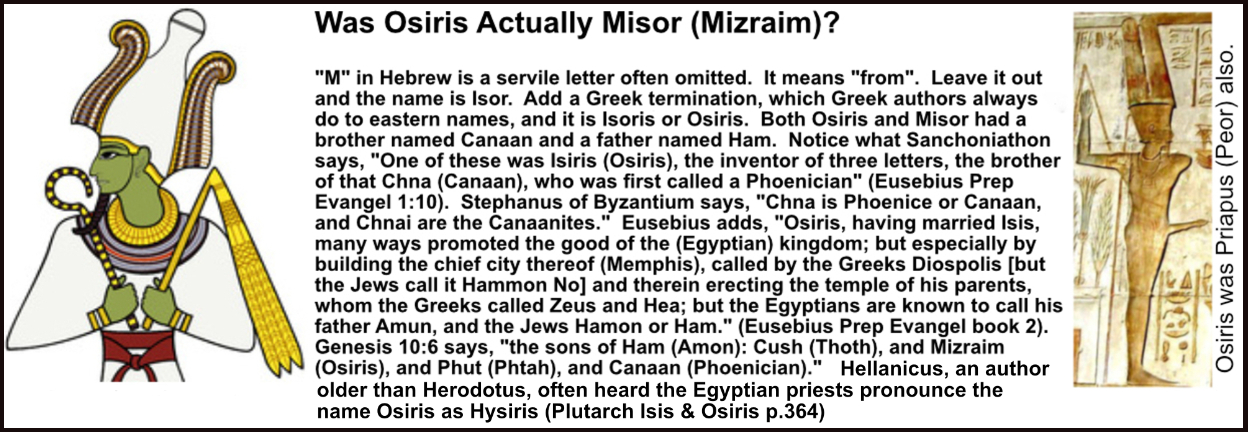
Secular History Confirms the Identities of Pharaoh Menes (Mizraim -- Osiris) Who Colonized Egypt in 2198 BC and Pharaoh Thoth (Cush) His Successor
Herodotus says, "the first man to rule Egypt was Min" (Her. 2:4, 99). Diodorus 1:45 says, "Menas was the first who reigned over the Egyptians ... the descendants of the above-mentioned king, fifty-two in all (ending in Ramses XII), reigned more than 1400 years." Misraim is identified with the first Egyptian pharaoh Menes (George Syncellus quoting Manetho's Book of Sothis). Josephus says Menes ruled 1300 years before Solomon (Ant. 8:6:2).
How do we know Menes and Mizraim (Misor) are the same person?
1. Misor and Menes both built the same city after the dispersion at the Tower of Babel about 2203 BC. Menes, the first king of Egypt, is said by Herodotus to have built Memphis (Her. 2:99) -- a Greek corruption of Mene-phis; It was called Meneph by Arabians -- Bochart. But Arabians also call this city Mezer; and Turks call it Mitzir. So the city was named after both men.
2. Misor and Menes had the same man as "son" or successor. Misor's "son" is Thoth [Sanchoniathon] ; Menes' "son" is Athothes [Eratosthenes]. Athothes just has a Greek termination of "es". Remember that Aram [1 Chr. 2:9] became Ram [Luke 3:33]; Eleazar became Greek Lazarus; and Shepherd King Apachnas [Josephus] became Pachnas [Africanus]) -- all dropping the initial vowel. Also arise became rise and around became round.
3. Misor and Menes had the same man as father. The father is Ham [Amun; Hammon]. Mizraim's (or Misor's -- Isa. 19:6) father was Ham (Gen. 10:6). The Bible refers to Egypt as "the land of Ham" in Psalm 78:51; 105:23, 27; 106:22; 1 Chronicles 4:40. Evidence of this founder of Egypt is found in Ezekiel 30:15, Jeremiah 46:25 and Nahum 3:8 where we read about "Hamon-No" or "No-Amun" (Thebes) (not "multitude of Thebes"). Ham is also called "Cronus" by Plutarch, Diodorus Siculus and Sanchoniatho. Notice Eusebius Prep. Evangel. 9:17 which says "There was ... Cronus ... of him came ... Canaan, who was ... the father of the Phoenicians ... the brother of Mestraim, the father of the Egyptians." Furthermore, "Menes ... is also Mestraim" (Syncellus p.127, Chronography; Eusebius in Chron. Graec. p.17) which is known to be the Greek manner of expressing the Hebrew name Mizraim by both Eusebius and Eupolemus. Therefore Menes father was Amon or Ham also. Furthermore, "Osiris ... his father (was) Amun" (Ham) also -- Eusebius Prep. Evang. book 2, so Osiris is both Misor and Menes. Dionysius of Halicarnassus (1:27:1) says Manes (Menes), who founded the Lydian monarchy (Ludim), was the son of Jupiter (meaning Jupiter Hamon or Ham). The Achaemenians fignifiy the Tribe of Menes.
Thus the last three kingly successions of Sanchoniathon: Cronus (Ham), Misor and Thoth answer to the first three in Eratosthenes: Jupiter Hammon (implied from the fact that the kings rule from Thebes -- No-Amun), Menes and Athothes. Sanchoniathon begins his history with Protogonus (Adam) and brings it down to Cronus (Ham), Misor (Mizraim) and Thoth (Cush, the second king of Egypt). Eratosthenes begins his catalog with Jupiter Hammon (Thebes or No-Hamun), Menes (Misor), and Athothes (Cush). In fact, Eratosthenes names a total of 38 kings of Thebes, Egypt, reigning for over 1055 years. This brings us down to the Siege of Troy and is a secular history that agrees with Bible history. If they reigned only in Thebais (southern Egypt), as the title of Theban Kings implies, this allows the Hyksos to rule in the north of Egypt (15th, 16th & 17th Dynasties overlap). Then the Theban kings take over even the north (18th Dynasty). The Hyksos never ruled over all of Egypt (Josephus Against Apion 1; Euseb. 10:13). (The first dynasty of the Thinites in Manetho also begins with Menes and Athothes.)
How do we know Cronus and Ham are the same person?
1.
The descent of Cronus (Ham) from Ouranus and Ge (Noah & his wife) is acknowledged in all heathen Theogonies (Hesiod, Apollodorus, in Diodorus Siculus's account of the Theologia Atlantiorum, and in Euemerus Messenius transcribed by Eusebius).
2.
Comparing the number of generations set down in Sanchoniathon from Protogonus to Cronus with the number of generations set down in Moses from Adam to Ham, there are eleven in both authors.
3. Uranos has another son besides Cronus, named Iapetos, the Greek equivalent to Noah’s son Japheth (Yapet). Japheth and his offspring represent the Greeks and other European groups.
4.
Hesiod's Theogony 154-166 says Cronus castrated and deposed Uranus. Uranos, like Noah, is a patriarch responsible for populating the world. Uranos’s youngest son (Cronus) performs a shameless act against him, like Noah’s youngest son, Ham, does to him (Gen. 9:22).
5.
Furthermore, Eusebius Prep. Evangel. 9:17 says, "There was at first Belus, who is Cronus (Ham); but of him came another, 1. Belus, and 2. Canaan, who was or begot the father of the Phoenicians; his son too was 3. Coum, whom the Greeks call Asbolos, the father of the Aethiopes, the brother of 4. Mestraim, the father of the Egyptians" (Eusebius Prep. Evangel. 9:17). Adjusting this translation to the four sons of Ham (Gen. 10:6) is easy enough since Canaan and Misraim are mentioned by both Eusebius and Moses. The third name Coum is slightly altered from Cush, the Shin being changed into a Mu, only to express the accusative case in a form more like the Greek termination of that case. The fourth name Belus, the successor of his father Ham in the dominions over Africa, must be Phut who bears the title of his father among the Babylonians since he is here called by the Chaldean title of honour Belus. Cronus must therefore be Ham. Ham is called Cronus as well as Belus by Eupolemus.
Thoth was Cush, who was not the "son" of Mizraim, but his successor. When Typhon (Shem) killed Osiris (Mizraim), Thoth (Cush) was appointed king in his place by Cronus (Ham) (see Sanchoniathon). Therefore Thoth (Cush) is the "successor" of Mizraim, not his "son" (p.202, Worship of the Dead). Belus (Cush), the first king of Babylon, was king of Africa also (Lempriere, Egyptus).
How do we know Thoth and Cush are the same person?
1. Hyginnus says, "for many ages men lived ... all speaking one language. But after Mercury interpreted (divided) the speeches of men ... the same individual distributed the nations. Then discord began" (Fab 143 p.114). We know Cush created "CHAOS" at the Tower of Babel (Gen. 10:8-10 & 11:9), hence his name came to mean "CHAOS". Janus, father of the gods, says, "the ancients called me CHAOS" (Ovid Fasti 1:104). "Bel (Cush) is CHAOTIC" (Jer. 1:2). But who was Mercury? "Tautus was called Hermes" (Mercury) -- Sanchoniathon. "Hermes" actually means "son of Ham" -- Cush. On the reverse of an Etruscan medal of Janus a club is shown, and the name of the club in Chaldee is derived from the word which signifies to 'break in pieces" or "scatter abroad" (Hislop, p. 27 note) implying Janus was the cause of the human race being scattered abroad.
2.
Humboldt says, "Woden of the Chiapenese (Mexicans) was the GRANDSON of that illustrious old man, who at the time of the great Deluge in which the greater part of the human race perished, was saved on a raft together with his family. Wodan cooperated in the construction of the great edifice which had been undertaken by men to reach the skies; the execution of this rash project was interrupted; each family received from that time a different language; and the great spirit Teotl ordered Wodan to go and people the country of Anahuac (Mexico)." (Humboldt Mex. Res. 1:320 p.134). Cush was Wodan who was ringleader in building the Tower of Babel. Hermes ("son of Ham" --Cush) in Greece was worshipped as Odin in Scandinavia; and Woden in Mexico (Buddha in Tamul is Poden; P & W are identical in Sanscrit). In Mexico, human sacrifices were offered to a god with negro features called Wodan (Prescott's Conquest of Mexico 3:6, p.168). Woden's Day in Germany is Buddha's Day (Boodwar) in China or Mercury's Day (Mercredi) in France. Buddha's triratna is Mercury's caduceus. Tacitus says Woden was Mercury (Germ. 9) The star Mercury is called "Buddha" by the Hindus (Asiat. Res. 1:162). The mother of Mercury was Maia (Lempriere Mercury) and this was also Buddha's mother's name. Bel was called "All-Wise" (Rawl. Herod. 1:599-600) just as Buddha means "All-Wise". Buddha had a wide nose, thick lips and wooly hair. He was a negro called Cush (Gen. 10:6-8). "Hermes or Thoth (was) an Ethiopian" (Cushite) (Diod. Sic.). Hermes was called Tautus or Thoth in Egypt (Philo's intro to Caesarea's Praep.); Mercury in Rome; Gothic Tuisto or Teut in Germany (Lucan Pharsal. 1:444-6); and "Teutates" by the Gauls (Lactant. Instit. 1:21); "Tautus was called Hermes" (Mercury) -- Sanchoniathon. Herodotus refers to the mummification of ibises, Thoth's sacred bird, in Hermopolis, the city of Hermes (2:66).
How do we know Priapus (Peor) is the same person as Mizraim (Menes)?
1. The LXX makes Meon a deity.
2. Meon was so great a title of honor that it is given to God himself in Scripture (Psalm 90:1; 91:9) and translated "Dwellingplace." The Lord is our "Meon" (Dwellingplace) -- not Mizraim (Psalm 90:1; see also Psalm 91:9).
3.
Egyptian cities named in honor of Baal-Meon (Num. 32:38; Josh. 13:9,17,21; 21:36; Jer. 48:23; Ez. 25:9; 1 Chr. 25:8), in the plain of Misor (See Josh. 13:9,17,21; 21:36; Jer. 48:21 in Septuagint), were associated with the idol Peor (See Targum of Jonathan regarding Num. 32:38) which was a derogatory name for Meon. David sang about those who were "joined (sexually) to Baal-Peor" (Ps. 106:28). Peor (Opener of vagina) is only used by Jews in Scripture and rabbinical books so it must be an insult. There is no evidence that heathen authors ever used this name for their god. Priapus comes very near to it. This implies that Meon or Menes (Mizraim) was Peor (Priapus). Hierom often tells us Peor is Priapus. Isaiah leaves out "Meon" -- the idol's name -- in Isaiah 15:2, just calling a town "Beth". The Israelites changed the name of the city Baal Meon when they rebuilt it, just like that of Nebo, because these were false gods.
4.
Plutarch tells us that in Osiris's feast called Pamylitia, his shameless phalli are carried in procession. They are three times as big as normal. Herodotus in his Euterpe assures us the phallus was movable. Lucian calls it erect. We know that Osiris was Mizraim (Menes or Meon) from proof already given. Priapus was known for his phallus also. "Peor" simply means "Opener" (of the vagina).
5. Priapus is the same as Dionysus according to Suidas. The Greek Dionysus is the same person as the Egyptian Osiris as proven by Diodorus, Herodotus and especially Plutarch. Therefore Priapus is Osiris whom we already have proven to be Mizraim
(Meon or Menes).
6. Baal Pe'or, honoured with lewd rites, was Priapus ; Pe and Phe are prepositives; Gwr and wr in Celtic signify man ; thus Pe'or is the man ; and Peor Apis, as Bryant observes is Priapus; that is the man Apis; the first Apis was that Meon or Menes who was Misor :
How do we know Tammuz is the same person as Mizraim?
1. Ta-Miz (Tammuz) or Da-Miz (Dumuzi) is composed of two words. "Miz" which is short for Mizraim; and "Ta" or "Da" which is the Egyptian equivalent of "Theos" of the Greek or "Deus" of the Latin. It is a verb meaning "to give." Thammuz is the Hebrew name of Adonis, or Osiris, or Menes.
2."Osiris (Mizraim) ... was killed by Typhon (Shem) his brother ... who ... divided the body into twenty-six parts ... Isis ... wife of Osiris, avenged the murder ... having slain Typhon (Shem) ... became queen of Egypt ... found all except one part of the body of Osiris ... and gave them to the priests throughout all Egypt to be worshipped." (p.59, Eusebius, Prep. For Gospel) Another account reads: "Set (Shem), the brother of Osiris (Mizraim), rebelled against him and cut his body in pieces" (Rawlinson's Egypt and Babylon). A third account reads, "When the false prophet named Thammuz preached to a certain king that he should WORSHIP the seven STARS and the twelve SIGNS of the ZODIAC, that king ordered him to be put to a terrible death ... And hence arose the custom every year, on the first day of the month Thammuz, to mourn and to weep for Thammuz" (Maimonides, More Nevochim, p. 426). Therefore Tammuz is Osiris (Mizraim).
3. Notice parallel accounts: Just as Typhon overcame Osiris "NOT BY FORCE OR OPEN WAR" (Wilkinson's Egyptians 4:330-332), so also Manetho wrote, "There was a king of ours whose name was Timaus (Thammuz -- Cumberland's Sanchoniathon, p. 359-360; Theta and tau are letters easily exchanged in Greek.). Under him it came to pass ... men ... our country ... with ease subdued ... YET WITHOUT OUR HAZARDING A BATTLE WITH THEM. So when they had gotten those who governed us (Tammuz) under their power, they afterwards burned down our cities and demolished the temples of the (false) gods (cp. Num. 33:52; Deut. 7:5, 25-26), and used all the inhabitants in a most barbarous manner, nay, some they slew and led their children and wives into slavery. At length they made one of themselves king, whose name was Salatis (or Saites or Shem -- first king of 15th Dynasty) (Manetho, from Josephus, Contr. Apion 1:14-15)
4. Ham, Nimrod and Ninyas were also called Thammuz or Tammuz. This is not unusual. Ham and Phut were both called Belus as a title (Praep. Evang. 9:17 p.419). Wilkinson says that the different gods "take eachother's characters and attribues" (pp.9-10, Egyptians). Eusebius well says, "It must be confessed the ancient writers have very much confounded these ancient names with one another." In addition to titles of office used successively, this may be due partly to the custom among the ancients of speaking of all the direct descendants of an important person as his SONS. Also, the word BROTHER was anciently used to describe all parallel branches of a family. For instance Typhon (Shem) was called the BROTHER of Osiris (Nimrod) (Lempriere).
How do we know Egypt was colonized in 2198 BC?
Eratosthenes gives 986 years from Menes to Pharaoh Nilus, whom Herodotus (2:3) calls the son and successor of Ramesses the Great. Dicaearchus, a Greek historian of the 4th century BC, says, "From the time of Pharaoh Nilus to the first Olympiad there were 436 years." (Dicaearchi Mess. de Sesos. Rege Frag. given in Egypt's Place, I. 680; Apollodorus Argonautic 4:272). If Dicaearchus refers to the time when the Olympic games were first instituted in BC 776; this would give 1212 BC as the date of the death of Ramesses and the accession of his son. (776 + 436 = 1212) Adding 986, we obtain 2198 BC when Menes (Mizraim) commenced the kingdom of Egypt. Colonization of Egypt (2198 BC) therefore followed five years after dispersion at Babel (2203 BC). Champollion declared that "no Egyptian monument is really older than the year 2200 BC." The papyrus of Turin gives 355 years as the duration of the first six dynasties of Egypt.
What other pharaohs can be identified?
Agag, a king of Amalek, mentioned by Balaam (Nu. 24:7) is Apophes (Manetho), the fourth Hycsos Shepherd King of the Second Dynasty. Diodorus says "the Ethiopians claimed Memnon as a native of their country" and Pausianius says Memnon was "king of the Ethiopians" and the Memnon of the Greeks (Homer's Odyssey & Virgil's Aeneid) is identified with the Egyptian Phamenoph, Pharmenoth, Amenophis (the Noph of the Hebrews) or Amenothph (Pausianius 1, 42, 2). Zerah the Ethiopian" (2 Chr. 14:9) is identified with Sera (Tomai), who reigned 26 years from 949-923, of the Dynasty of Menelik (from Solomon and the Queen of Sheba) (see In the Country of the Blue Nile by C.F. Rey - 1927). The Shishak of Scripture identifies with Shoshenq (943-922 BC), who invaded Rehoboam in 943 BC (1 Ki. 14:25; 2 Chr. 12:1-12) -- Sesonchis (head of Manetho's 22nd Dynasty). The So of Scripture identifies with Sabaco (727-715 BC) (Her. 2:137) or Osorkon IV (730-715 BC), the Ethiopian who reigned in Egypt about 730 BC (2 Ki. 17:4). Another king is “Tirhakah king of Ethiopia” (2 Ki. 19:9) who identifies with Taharqa (690-664 BC) (Her. 2:141). And the Necos of Herodotus (2:159) or the Pharaoh Necho of Scripture identifies with Necho II (610-595 BC) in 609 BC (2 Ki. 23:29, 2 Chr. 35:20–24). The Hophra of Scripture (Jer. 44:30) is Apries (589-570 BC) of Herodotus 2:165.
Why Worship Animals? Why Polytheism?
The religion of Thebais (southern Egypt) consisted of worshipping Cneph, the hidden, immortal king and supreme life-giver God, so much so that they were not taxed towards the charge of maintaining the sacred animals worshipped by the others (Plutarch de Isid et Osirid, p. 359). From this god Cneph they supposed a secondary god proceeded called Phtha, which word is at present used among the Copts to signify the divine being. Thus, Simplicius even believed that Moses' history of the creation of the world by God was wholly taken from Egyptian fables (Aristot. Phys. 8:268). But in the rest of Egypt (northern Egypt), idolatry prevailed. Menes "instituted the worship of the gods" (Diod. Sic. 1:37). He was the originator of idolatry. But it was Thoth or Hermes (Cush), appointed king over Egypt by Cronus (Ham) (Sanchoniathon p.39), who "first arranged those things which belonged to religion and the worship of the gods" (Sanchoniathon in Cory's Fragments, p.21). "Ethiopians (Cushites) were the first who introduced the worship of the gods" (Baldwin's Prehistoric Nations pp.61-62). Diodorus tells us that one of the first and most prudent kings of Egypt, finding the Egyptians very prone to SEDITION, enjoined to each province the worship of some particular ANIMAL DIFFERENT from all the rest, and likewise to use a DIFFERENT DIET; so that the Egyptians being by this means divided into so many distinct societies, PREJUDICED AGAINST EACHOTHER in religious matters, and mutually DESPISING ONE ANOTHER on account of their DIFFERENT CUSTOMS in the ordinary affairs of life, there was no likelihood of their ever uniting again (Diodorus ubi supr. p.80). This is how POLYTHEISM overran Egypt. They came to bestow divine honours on ANIMALS and even VEGETABLES such as leeks, garlic and onions; and that with so great variety, that except for some of the principal gods over all Egypt (Osiris [the sun] & Isis [the moon] -- Diod. 1:11) (plus Ra, Amon, Ptah, Serapis, & Neith), the worship of every lesser deity was confined to one or two cities [these deities were none other than stars & planets of the zodiac]. Thus it came to pass, that a great number of the chief cities of Egypt, were by the Greeks named after the gods or ANIMALS that were worshipped there. As Diospolis or the city of JUPITER; and Heliopolis (On), or the city of the SUN. Pausanius says that "in the Egyptian city of Onuphis (ophis = serpent) they worship the ASP" (cp. Herod. 2:74). Other cities bore the names of Pan, Apollo, Latona, Hermes, Hercules and Venus. Also the apis, the dog, the cat, the lion, the wolf, the hawk, the eagle (Diod. 1:87), the ibis, the crocodile (Herod. 2:69), the fishes latos, oxyrynchus, phagrus, wasp, etcetera.
The worshippers of one city were held in the greatest abhorrence by their neighbors since one deity ANIMAL was a natural predator of another deity. This resulted in unending quarrels and wars. Those of Heracleopolis who worshipped the MONGOOSE (meerkat) quarrelled with those of Arsinoe who worshipped the CROCODILE. The people of Dendera hunted and destroyed the CROCODILE, sacred at Kom Ombo. The city of Oxyrynchus whose inhabitants sacrificed and ate dogs but worshipped a FISH, quarrelled with the city of Cynopolis whose inhabitants worshipped the DOG but ate the fish (Plutarch ubi sup. p.380). At Lycopolis the WOLF was worshipped and the SHEEP was eaten (following the example of their god the WOLF). But the SHEEP was worshipped at Thebes. The Mendesians also ate the holy SHEEP of Thebes. One can only imagine the hostilities between the GOAT-worshippers of Mendes (named from Menes) and Thmuis and the LION-worshippers of Leontopolis. If a person killed any of these sacred animals deliberately, he was punished with death. The destruction of a cat in a burning building was lamented more than the loss of property. Upon the death of a dog, every member of the family shaved his head. The scarabaeus, or beetle, was especially sacred, being considered an emblem of the sun. They made gods of "man, and birds, and four-footed beasts, and creeping things" (Rom. 1:23) -- even leeks and onions.
Why Birthday Celebrations and Human Sacrifices?
The Egyptians are said to have been the first who required men to abstain from women in temples and not enter any sacred place without washing after having sex with a woman. They were also the first who assigned each month and day to a particular deity, and observed the time of each person's nativity (BIRTH DAY); by which they determined that person's future fortunes (FORTUNE-TELLING). Regarding CONSULTING ORACLES, the most ancient and famous oracles among the heathen, particularly those of Jupiter in Libya, and at Dodona, owed their origin to Egypt (see Herodotus) where, for instance, a sacred animal was offered food and either accepted it (good omen) or rejected it (bad omen). HUMAN SACRIFICES were offered by ancient Egyptians at the tomb of Osiris (Busiris -- Diod. Sic. 1:79) who were red-headed because of their resemblance to Typhon who slew Osiris. The victim was burnt alive and called Typhonian (Eusebius Praep. Evang. 4:16; Plutarch de Isid. et Osir. p.380). This barbarous custom was abolished by Amosis, who ordered that images of wax should be offered in their place. Incidentally, according to the Greek story, Hercules (Samson) would have been sacrificed to Zeus (Dagon) in Egypt (Philistia) "with the sacrificial wreathe upon his head ... he quietly submitted until the moment came for the beginning of the actual ceremony at the altar, when he exerted his strength and killed them all" (Herod. 2:45).
Egypt, immediately after the death of Menes, was divided into four distinct kingdoms: 1.Thebes, 2. This, 3. Memphis, and 4. Lower Egypt (besides some of lesser note, which arose afterwards). It then continued in this divided state for almost seven centuries, till the Hyksos pastors made themselves masters of all, except that of Thebes. Then 511 years after that, Egypt became subject to one prince called Amosis. This is how Manetho's dynasties can be made to fit inside of the Biblical chronology. They were contemporaneous (cp. 2 Ki. 7:6; Isa. 19:2) rather than successive.